JOAN AND PETER CLEMENGER, MELBOURNE
Joan and Peter Clemenger’s passion for art and generous philanthropy to the arts over many decades is all the more remarkable given that neither came from families with an interest in visiting galleries and collecting. This is something they developed together as a couple, and it has been one of the hallmarks of their extraordinary lifelong partnership. However, rather than focus exclusively on developing their own collection, the Clemengers made the visionary – and at the time, ground-breaking – decision to share their love of art and the enrichment it gave them, through philanthropy, and particularly through their support of the National Gallery of Victoria, a relationship that now extends over 40 years.
Joan and Peter met when Joan was working in the Collins Street studio of acclaimed Melbourne fashion and advertising photographer Athol Shmith, and the pair married in 1956. Peter had started working in advertising at the age of 16 and joined his father in establishing Clemenger Advertising just two years later. Today, Clemenger BBDO is the largest agency group in Australia. Not long after their marriage, Joan attended a Christie’s art appreciation course, which she loved. Visits to Melbourne’s small clutch of commercial galleries ensued, with Joan coming to know gallerists such as Joseph Brown, Max Hutchinson, Georges Mora, Anne Purves and Sweeney Reed.1 As Peter’s advertising business grew and he was increasingly required to travel overseas for work, their knowledge of art correspondingly expanded to include international modern and contemporary artists and dealers. In a story that has since become family lore, Joan once arrived at the reception of New York’s Chase Manhattan Bank and requested to see the Bank’s art collection. Such was Joan’s courage, determination, and bravura, that no further questions were asked, and she was subsequently taken on a private tour by David Rockefeller (1915 – 2017), the Bank’s chairman and chief executive at the time. As Jason Smith has so aptly described Joan: ‘She had a twinkle in her eye, a ready smile, and a fabulous laugh. But when she spoke, she meant business.’ 2
The Clemengers’ art collection started modestly, with an eight by six-inch Ray Crooke painting that was bought from gallerist Barry Stern for £25. This was followed by a group of small paintings by Thomas Gleghorn; a Lawrence Daws for $5; a Fred Williams work on paper, bought from Rudy Komon Gallery for $190, and then a small John Olsen purchased when Peter had ‘had about three sherries… and was feeling fairly relaxed’. Driven by personal response rather than by fashion or art world ‘favourites’, the couple lived with their growing collection and rarely sold works: ‘We’ve not had a plan’, admits Peter, ‘we are just happy with what we’ve got’. 3 Their first significant acquisition was an Arthur Boyd ‘Wimmera’ painting from Melbourne’s Australian Galleries, which was $1,600 – quite a jump from the price of earlier purchases, and quite a stretch for the young couple at the time. As this sale attests, several important works followed including Brett Whiteley’s magnificent Bathurst landscape, The Wren, 1978, executed at the height of his fame; John Brack’s enigmatic still life, No More , 1986, and the joyful The Splash, 1955 from John Perceval’s iconic Williamstown series.
29
A major donation by the Clemengers to the NGV in 1991 was the impetus for the establishment of what was to become known as the Clemenger Contemporary Art Prize, a series of six triennial exhibitions (running from 1993 to 2009) which celebrated the contribution of Indigenous and non-Indigenous mid-career and senior contemporary Australian artists. Having had the pleasure of working on two iterations of this Prize in 2006 and 2009 as Curator of Contemporary Art, I came to understand and appreciate the Clemengers’ deep commitment to Australian art and artists, their generosity of spirit, and their extensive knowledge. This unique and important series was a collaboration between the Gallery’s curators and Joan and Peter, with the development of each exhibition unfolding over several years. Peter’s keen eye was largely tuned to management of the budget and to the exhibition collateral, signage, and promotion; with Joan acting, in each iteration, as one of Prize’s three judges.
It did not stop there. In 1999, Joan made a commitment to build upon the important legacy of the Gallery’s G H Michell (1976 – 1987) and Margaret Stewart Endowments (1987 – 1997), which supported the acquisition of emerging Australian artists working in all media. Thus, the Joan Clemenger Endowment was born. Over the course of the Endowment’s four-year term, Joan was closely involved in the acquisition process, visiting galleries with the curators, and attending Acquisitions Meetings. The price for works was capped at $5,000 to ensure that the fund was truly benefiting artists at the beginning of their professional careers, and to enable the purchase of a greater number of works. It is telling that many of the artists whose work was acquired through this fund – including David Rosetzky, Ricky Swallow and Louise Weaver, to name but a few, are now some of our most celebrated contemporary artists.
Given the benefits they derived from travel, and from seeing the world’s best museums, Joan and Peter also established the Clemenger Travel Grant – an application-based program that enabled the professional development of the Gallery’s curators, conservators, and other professional staff. I was fortunate to be a recipient of this grant and can vouch for the life- and career-boosting benefits of the five-week trip I was able to undertake, visiting museums and colleagues across the UK and North America. The grant has now been running for close to 20 years.
After the end of the Clemenger Contemporary Art Award, Joan and Peter’s support of acquisitions at the NGV broadened to include international contemporary art, but equally, they have also been quietly involved in the purchase of works across other collecting areas for decades. After Joan’s death in early 2022, Peter has continued the couple’s commitment to the NGV, ensuring that Joan’s legacy as a benefactor, art lover, and friend to artists continues through his involvement.
30 COLLECTION OF JOAN AND PETER CLEMENGER
Yet the Clemengers’ benefaction is by no means exclusive, and alongside their incredible support of the NGV they fostered long term relationships with a range of arts organisations. Peter was a patron of the Melbourne International Arts Festival, the pair are Lifetime Patrons of the Melbourne Theatre Company, and through the Joan and Peter Clemenger Trust (established in 2001) they support the Australian Ballet to bring international artists and companies to Australia to tour. Searching for a major tourism and reinvigoration project for Melbourne in the early 1990s, Peter established (and funded) the Melbourne Food and Wine Festival and ran the organisation for nine years. It has since become one of the world’s top food and wine events and celebrates its 30th anniversary this year. Joan was a Fellow of Heide Museum of Modern Art and was central to the fundraising efforts that enabled the Museum to develop the 2012 exhibition Louise Bourgeois: Late Works and was also a supporter of a host of organisations ranging from Orchestra Victoria to Big Brother Big Sister and Royal Botanic Gardens Victoria. The Clemenger Trust has also funded medical research through its support of, amongst other organisations, the Mental Health Research Institute of Victoria, the Centre for Eye Research Australia, the Peter McCallum Cancer Foundation and the Murdoch Children’s Research Institute, and has helped address the needs of vulnerable children, young people and families through its substantial support of Anglicare. 4
In 2015 Joan and Peter Clemenger scored a rare ‘double’ in the Australia Day Honours, each becoming Officers of the Order (AO) for their support of the visual and performing arts and for their philanthropic work. Peter’s response to this very public recognition was characteristically low-key: ‘I got a letter telling me about the award and thought that’s nice…Then I opened another letter and found Joan had the same. That was wonderful.’ 5
The author is grateful to Veronica Angelatos for the notes she took during her interview with Peter Clemenger at his Melbourne home on 26 May 2022, which have informed this piece.
1. Joseph Brown (1918 – 2009) opened Joseph Brown Gallery at 5 Collins Street, close to Athol Shmith’s studio, in 1967. Max Hutchinson (1925 – 1999) was the founding director of Gallery A; Georges Mora (1913 – 1992) was the director of Tolarno Galleries; Anne Purves was the director, with husband Tam, of Australian Galleries, and Sweeney Reed (1945 – 1979) was the Director of Strines Gallery, and later, Sweeney Reed Gallery.
2. Smith J., speech notes for Joan Clemenger AO, Memorial Service, 5 April 2022. Jason Smith, also a Curator of Contemporary Art at the NGV from 1997 to 2007, worked on the 1999, 2003 and 2006 iterations of the Clemenger Contemporary Art Award.
3. Childs, K., ‘Portrait of a Patron’, Flight Deck, May 1993, p. 21 in ‘EXHIBITION: JOAN AND PETER CLEMENGER TRIENNIAL EXHIBITION OF CONTEMPORARY AUSTRALIAN ART 1996 PART 1: APR 1993 – DEC 1994’, NGV RMU File G1111, accessed 29 June 2022
4. ‘Advertising Legend Peter Clemenger and Wife Joan Both Awarded AO in Australia Day Honours’, 26 January 2015, https://campaignbrief.com/ad-legendpeter-clemenger-and/?utm_source=pocket_mylist , accessed 23 July 2022
5. Money L., ‘Australia Day Honours: Ad Legend Clemenger and Wife Score The “Double”’, The Sydney Morning Herald, 23 January 2015, https://www.smh. com.au/national/australia-day-honours-ad-legend-clemenger-and-wife-score-the-double-20150123-12wu6a.htm l, accessed 23 July 2022
KELLY GELLATLY
31 31
BRETT WHITELEY
(1939 – 1992)
THE WREN, 1978 oil on canvas
168.0 x 153.0 cm
signed lower right: brett whiteley
ESTIMATE: $2,000,000 – 3,000,000
PROVENANCE
Australian Galleries, Melbourne
Joan Clemenger AO and Peter Clemenger AO, Melbourne, acquired from the above in July 1978
EXHIBITED
Brett Whiteley: paintings, drawings and three scrolls plus one bronze from 1960
Italy never before shown in Australia, Australian Galleries, Melbourne, 12 – 25 July 1978, cat. 48 (label attached verso)
LITERATURE
Makin, J., ‘Which Brett is for real?’, The Sun, Melbourne, 19 July 1978, p. 32
Sutherland, K., Brett Whiteley: Catalogue Raisonné , Schwartz Publishing, Melbourne, 2020, cat. 243.78, vol. 3, p. 556 (illus.), vol. 7, p. 457
RELATED WORK
(Blue Wren), c.1979, mixed media and collage on card, 101.5 x 76.0 cm, private collection, illus. in Sutherland, K., op. cit., cat. 176.79, vol. 3, p. 636

32 COLLECTION OF JOAN AND PETER CLEMENGER
6
Front cover of exhibition catalogue Brett Whiteley: paintings, drawings and three scrolls plus one bronze from 1960 Italy never before shown in Australia, Australian Galleries, Melbourne, 12 – 25 July 1978
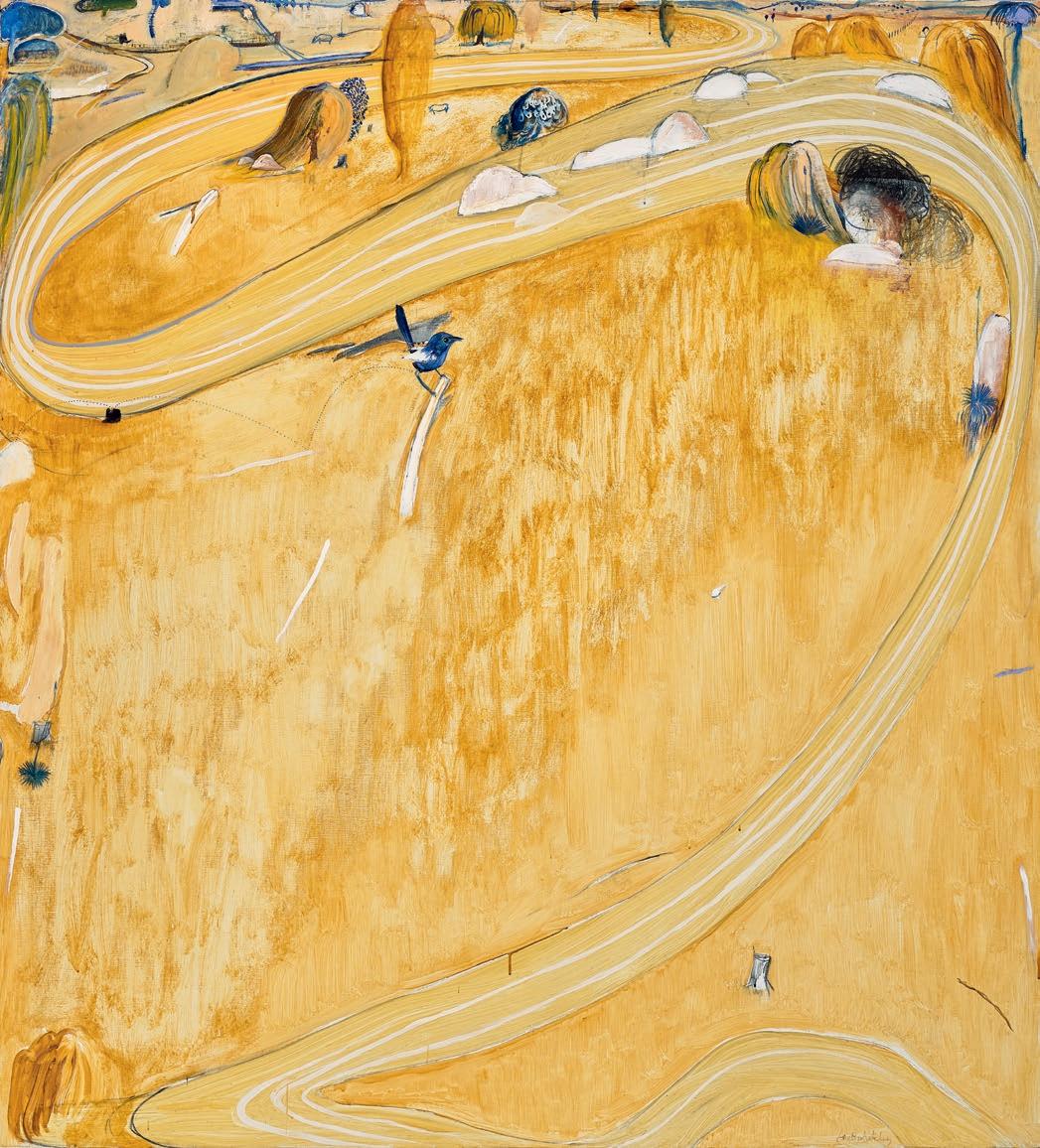
33
‘Of all the subjects Whiteley painted in his career, landscape gave him the greatest sense of release…’1
After a tumultuous decade abroad, in 1969 Brett Whiteley returned to Australia and, in the tradition of many expatriate artists before him, thus embarked upon an artistic pilgrimage to rediscover his homeland. Captivated afresh by the beauty, vastness and variety of the Australian landscape, he thus explored the shifting chromatic illusions and ‘optical ecstasy’ of Sydney’s Lavender Bay in sumptuous tableaux redolent of Matisse, before subsequently revisiting the country of his boyhood in the central west of New South Wales – returning ‘to the rounded, monumental, full-breasted hills and open spaces that surround Bathurst’. 2 Today universally acclaimed among the most relaxed and quietly assured paintings of Whiteley’s career, the resultant landscapes immortalising the central west thus exuded a distinct lightness and easy spontaneity – an intimacy derived from the artist’s deep identification with this region’s geography over the span of three decades. Capturing the shimmering heat that descends on these rolling hills and gentle vales during the blaze of an Australian summer, The Wren, 1978 represents a particularly magnificent example from this celebrated period within Whiteley’s oeuvre – evoking both the detached grandeur of classical Chinese painting, and the close emotional engagement of his spiritual and artistic hero, Vincent Van Gogh. Hailing from that auspicious year when Whiteley was at the very height of his fame – his annus mirabilis of 1978 in which he became the first artist ever to win all three of the country’s most coveted art prizes (namely the Archibald Prize for Portraiture; the Wynne Prize for Landscape and Sulman Prize for Genre) – indeed the work is Whiteley at his finest, elegantly encapsulating his luminous colour, sensual line and characteristic verve all in poignant homage to the landscape where his journey as a painter first began.
* * * * * * * * *
In February 1948, amidst the demands of managing a business and maintaining their hectic social schedule, Clem and Beryl Whiteley made the steely decision to uproot their children – Brett, aged eight and sister, Frannie, aged ten – and pack them off to boarding schools some three hundred kilometres away from Sydney. 3 Seething with frustration at his loss of freedom and the regimentation of boarding life at The Scots School, Bathurst, not surprisingly Whiteley felt banished, rejected and angry; as he later reflected, ‘The days were so long – it was all so stretched out. A term seemed three years. It really was a punishment
and there was nothing else to do but to invent my own world – to set up a device to deal with it.’4 Notwithstanding such negatives, there were also triumphs and with hindsight, the Bathurst experience proved crucially important to Whiteley’s future development as a painter – influencing his understanding of the landscape and its seasons in a way that could not have been possible had he remained in Sydney during these formative childhood years. Notably, his teachers were perspicacious and supportive of their reluctant student’s precocious artistic talent, encouraging him to set up an easel at the back of the classroom from which he could paint the view through the window – whether it be ‘a wren that landed on a tree branch’ or ‘the hills, the sort of caressed breasts of Bathurst’. 5 Moreover, on Sundays during his final years of high school, Whiteley and his close friend, Vernon Treweeke, were granted special permission to leave the school grounds to explore and paint en plein air the surrounding Bathurst countryside – with one composition from such excursions earning Whiteley first prize in the Young Painters section of the 1956 Bathurst Show.6 Significantly, after leaving school and while working at the Lintas advertising agency in the city, Whiteley would continue to make weekend sketching expeditions over the Blue Mountains to Bathurst, Ulladulla, Sofala and Hill End, and notably, it was a central west landscape from this time, Around Bathurst , 1959 (private collection) that won him the Italian Government Travelling Art Scholarship for 1960.7
If these seminal experiences nurtured the beginning of a profound and enduring attachment to the landscape of the New South Wales central west – a connection Whiteley described as ‘a sense of feeling close to the earth’ 8 – his response was also inevitably conditioned by a boundless admiration for that great visual rhapsodist of the region, Lloyd Rees. As famously recounted, Whiteley first made the serendipitous discovery in 1954 when, as a curious, wide-eyed fifteen year old dressed in his school’s cadet uniform, he wandered into a solo exhibition of Rees’ recently painted landscapes at Macquarie Galleries in Sydney. 9 Deeply poetic in their contemplation of soft curves and arabesques all rendered
Brett Whiteley
1970
photographer: Robert Walker
© Robert Walker/Copyright Agency 2024
Art Gallery of New South Wales, Sydney
34 COLLECTION OF JOAN AND PETER CLEMENGER
*
(right page)
in his studio,

35


Around Bathurst , 1959
oil and sand on composition board, 122.3 x 143.0 cm
Private collection
© Wendy Whiteley / Copyright Agency 2024
On the Road to Berry, 1947
oil on canvas on paperboard, 34.6 x 42.2 cm
Art Gallery of New South Wales, Sydney
© A&J Rees / Copyright Agency 2024
with impeccable tonality, such images instinctively appealed to a young Whiteley in his ‘obsession’ with the sensuality of the landscape – with the child prodigy believing he had found in Rees a kindred artistic spirit. Indeed, Rees’ interpretations of the landscape left such an indelible impression upon his consciousness that decades later Whiteley not only dedicated an entire series to celebrating the master’s creative genius, but would write to his frail mentor to pay tribute: ‘I wanted to convey to you just how important an influence you have been on my life and on my art, how one event in 1954 had a profound effect on my understanding of what painting was and could be, and that the realisation that day has continued to influence and inspire me to this day.’10
Although attracted to the overtly sexual elements he perceived in Rees’ landscape, Whiteley nevertheless doubted that ‘old Reesey’ would have recognised such allusions in his own work.11 Years after the encounter at Macquarie Galleries, Whiteley would repeatedly visit Bathurst and Orange with fellow artist Michael Johnson, ‘hunting for Reesey’s hills’, remarking ‘Look at those rolling contours, he’s modelling the torso…’. As Johnson recalls, ‘We got so excited thinking of the landscape as a female figure, but we’d never say any of this to Lloyd. Lloyd was a nineteenthcentury man, settled into what he was, and we were twentieth-century kids, searching for the new.’12 Today one need only consider Whiteley’s early landscapes, such as The Black Sun, Bathurst , 1957 (private collection) – a portrait of melancholia prompted by his mother’s departure for an indefinite period overseas following the breakdown
of her marriage to Clem – alongside Rees’ iconic south coast painting, The Road to Berry, 1947 (Art Gallery of New South Wales) to appreciate the master’s defining influence. And in turn, the debt of both artists to the surrealist landscapes of British abstractionist Graham Sutherland – in particular, his Welsh Mountains , 1937, one of the few international modern paintings hanging in the Art Gallery of New South Wales at the time.13 Beyond the sensual abstracted forms of his soulful landscapes moreover, Whiteley also absorbed Rees’ predilection for intentionally leaving visible pentimenti or traces of the artwork’s evolution within the finished composition – a dynamic painterly technique that would become a hallmark of the younger artist’s oeuvre. As Whiteley recalled of his landscapes at the Macquarie Galleries’ exhibition, ‘…they contained naturalism but also seemed very invented, and the adventure of them was that they showed the decisions and revisions that had been made while they had been painted. I had never seen anything like that before… it set me on a path of discovery that I am still on today – namely that change of pace in a painting is where the poetry begins.’14
* * * * * * * *
Still reeling from his experience of living the turbulent, not-quite ‘American dream’, it is of little surprise that Whiteley should seek out the landscape of the central west for solace and inspiration upon his return to his homeland. As Barry Pearce, emeritus curator at the Art Gallery of New South Wales, has noted: ‘…if in many of his other themes
36 COLLECTION OF JOAN AND PETER CLEMENGER
*
*
Brett Whiteley
Lloyd Rees

Private collection
© Wendy Whiteley / Copyright Agency 2024
Whiteley confronted the difficult questions of his psyche, landscape provided a means of escape, an unencumbered absorption into a painless, floating world.’15 Oscillating between periods of extreme dependence on narcotics and restorative sojourns in the countryside (where the Whiteleys would invariably stay at the home of influential radio host, John Laws, in Oberon, or Michael Hobbs in Carcoar), thus the years that ensued witnessed the production of some of the most beautiful, highly acclaimed landscapes of Whiteley’s career – aptly earning him the epithet of ‘chronologist of the golden paddocks, sensual hills and willow-strewn rivers of the central west.’16 Culminating most famously in his highly successful solo show, ‘Rivers’, held at Robin Gibson Gallery, Sydney in March 1977, as well as the two Wynne-Prize winning paintings – River at Marulan (…Reading Einstein’s Geography), 1976 (private collection) and Summer at Carcoar, 1977 (Newcastle Art Gallery) – such large-scale landscapes poetically captured the region in its myriad moods and seasons, featuring birds, rivers, trees, rocks, skidding insects and shy mammals (both painted and assemblage), all brought together with elegiac majesty.
Monumental in scale and conception, The Wren exemplifies brilliantly this genre – complementing the dominant vertical perspective of the gliding river that ascends the picture plane with an acute attention to detail to exquisitely depict the tough beauty of a drought-ravaged landscape in mid-summer. Indeed, as Jeffrey Makin, art critic for the Sun astutely observed upon the painting’s unveiling at Australian Galleries in
1978, ‘As a performer Whiteley knows few equals. His understanding of the mechanics of composition are [sic] often excellent as evidenced in ‘The Wren’. Here the relationship between flattened space and incident – ie. that bouncy blue bird – is beautifully balanced.’17 Recalling the legacy bequeathed by artistic predecessors Russell Dysdale and Sidney Nolan in their stark portrayal of the country’s parched interior, thus the composition similarly evokes all the colour and drama of drought – presenting a theatre of death and survival in the same reductive palette of pale desiccated yellows punctuated by cobalt blue highlights that Whiteley so favoured in masterworks such as River at Carcoar; To Yirrawalla, 1971 (Art Gallery of New South Wales); and Blue River, 1977 (private collection).
Yet, as intimated by the painting’s title, it could well be argued that Whiteley’s focus here is as much upon the motif of the little blue wren as it is the expansive landscape. Occupying a poignant place in his iconography from early in his artistic journey, birds embodied for Whiteley not only peace and tranquility – a refuge from the internal demons that haunted him – but in his later work particularly, represented a yearning at once for both domestic stability and personal freedom. As Margot Hilton and Graeme Blundell elaborated, ‘Whiteley so loved birds, loved the way they hung overhead, tacking against the breeze, sliding sideways, wheeling and screeching away. He loved their freedom, the mindless glide of them. They were like a blessing on his life, an indication that the hand of God was at work…’18 , they were ‘the
37
Brett Whiteley
The Black Sun, Bathurst, 1957 oil on board, 39 x 58.5 cm

Brett Whiteley
Orange Fruit Dove, Fiji, 1969 oil and mixed media on composition board, 136.5 x 122.0 cm
Private collection
© Wendy Whiteley / Copyright Agency 2024

Brett Whiteley
To Yirrawala, 1972 oil and mixed media on board, 185.3 x 166.3 x 6.3 cm
Art Gallery of New South Wales, Sydney © Wendy Whiteley / Copyright Agency 2024
essential symbol of the song of creation’19 . Whether painted, drawn, collaged or stuffed and mounted, ornithological creatures populate Whiteley’s most important works – from the hummingbird and eagle appearing in his chaotic multipaneled American Dream, 1968 – 69 (Art Gallery of Western Australia) and the lyrebird, blue wren and even Donald Duck nestled within Alchemy, 1972 – 73 (Art Gallery of New South Wales), to his individual portraits dedicated to particular species – for example, Orange Fruit Dove, Fiji, 1969 (private collection, Brisbane); Pink Heron, 1969 (Art Gallery of New South Wales); Lyrebird, 1972 – 73 (private collection, Sydney); Hummingbird and Frangipani, 1986 (private collection) and even a Butcher Bird with Baudelaire’s Eyes , 1972 (private collection, Sydney). And of course, there are the whimsical avian sculptures – a Picasso-esque owl created from a boot; pelicans fashioned from dried palm fronds; and giant egg sculptures atop Brancusian pole-plinths. Bereft of any hint of angst or menace and ‘motivated more by love than despair’ 20 , not surprisingly such bird paintings remain among Whiteley’s most universally admired achievements; in the words of Sydney poet, Robert Gray, ‘In Whiteley’s bird paintings is embodied his finest feeling; they are to me his best
work. I like in the bird shapes that clarity; that classical, haptic shapeliness; that calm – those clear, perfect lines of a Chinese vase. The breasts of his birds swell with the most attractive emotion in his work. It is bold, vulnerable and tender.’ 21
Situated both thematically and chronologically between the two legendary late 1970s solo shows that explored the themes of the Bathurst landscape and birds respectively – namely his 1977 ‘Rivers’ and 1979 ‘Birds and Animals’ exhibitions, both held at Robin Gibson Gallery, Sydney – thus The Wren encapsulates Whiteley at his most lyrical, with his signature sweeping calligraphic line, dominant palette of sun-bleached yellows and luminous blues, and refreshing sense of freedom, optimism and contentment. An arcadian refuge of tranquil release and contemplation that seems almost beyond time in its stillness, indeed the masterpiece betrays an elegance and harmony unmistakably redolent of the Chinese art that Whiteley so admired, with the ‘repetition of motifs symbolising states of mind…the arabesques echoing the flightpaths of birds, which in turn mirrored the artist’s relaxed journey through his own domain.’ 22 In stark contrast to his
38 COLLECTION OF JOAN AND PETER CLEMENGER

more gruelling, visually demanding canvases of previous years, here there is no complex artifice, no anthropomorphic forms, nor flamboyant burlesques. Rather, Whiteley simply offers a romantic celebration of Nature in all her sensuality and rugged beauty, paying tribute to the landscape of his boyhood which first inspired his journey as a painter all those years ago. As the artist himself reflected upon such landscapes at the time, ‘…Sometimes I have to paint pictures that have an effortless naturalness, not artificial or synthetic, not manufactured – pictures that have no affectation through mental tricks but are graceful and according to nature.’ 23
1. Pearce, B., Brett Whiteley: Art and Life, Art Gallery of New South Wales, Sydney, 1995, p. 196
2. McGrath, S., Brett Whiteley, Bay Books, Victoria, 1979, p. 206
3. Sutherland, K., Brett Whiteley: A Sensual Line, 1957 – 67, Macmillan, Sydney, 2010, p. 15
4. Brett Whiteley, cited in McGrath, op. cit., p. 18
5. Brett Whiteley in Interview with Phillip Adams, radio 2UE, Sydney, September 1986
6. Sutherland, op. cit.
7. In November 1959, Whiteley was awarded Italian Government Travelling Art Scholarship for 1960, judged by Sir Russell Drysdale at the Art Gallery of New South Wales. Whiteley submitted four entries: Sofala; Dixon Street; July c.1959; and Around Bathurst, 1959 the painting that won him the scholarship.
8. Brett Whiteley, cited in McGrath, op. cit., p. 18
Brett Whiteley
Summer at Carcoar, 1977
oil and mixed media on pineboard, 244.0 x 198.7 cm
Newcastle Art Gallery, New South Wales
© Wendy Whiteley / Copyright Agency 2024
9. Lloyd Rees: 22 European Paintings, 17 March 1954, Macquarie Galleries, Sydney.
10. Brett Whiteley, cited in Klepac, L., Lloyd Rees – Brett Whiteley: On the Road to Berry, Heide Museum of Modern Art, Melbourne, 1993, p. 7
11. According to Wendy, Rees was reportedly astounded when Whiteley pointed out to him the overt sexual elements that he had found in his paintings: see Hawley, J., ‘Whiteley and Rees: An Inspiring Friendship’, Sydney Morning Herald, Sydney, 8 July 1992, pp. 13 – 17, cited in Sutherland, op. cit., p. 19
12. Michael Johnson, cited in Hawley, ibid., p. 17
13. Graham Sutherland, Welsh Mountains,1937, oil on canvas, 56.0 x 91.0 cm, Art Gallery of New South Wales. For discussion of the influence of this work upon both artists, see Pearce, op. cit., p. 18 and Sutherland, op. cit., p. 19
14. Brett Whiteley, cited in Klepac, op. cit.
15. Pearce, op. cit.
16. Hopkirk, F., Brett Whiteley 1958 – 1989: The Central West, Orange Regional Gallery, Orange, 1990
17. Makin, J., ‘Which Brett is for real?’, The Sun, Melbourne, 19 July 1978, p. 32
18. Hilton, M and Blundell, G., Whiteley: An Unauthorised Life, Macmillan, Sydney, 1996, p. 215
19. Pearce, B., Australian Artists, Australian Birds, Angus & Robertson, Sydney, 1989, p. 144
20. McCulloch, A., ‘A Letter from Australia’, Art International, October 1970, pp. 69 – 70
21. Gray, R., ‘A Few Takes on Whiteley’, Art and Australia, vol. 24, no. 2, Summer 1986, p. 222
22. Pearce, B., Brett Whiteley: 9 Shades of Whiteley (Education Kit), Art Gallery of New South Wales, Sydney, 2007, p. 25
23. Brett Whiteley cited in McGrath, op. cit., p. 216
VERONICA ANGELATOS
39
JOHN BRACK
(1920 – 1999)
NO MORE, 1984
oil on canvas
137.0 x 137.0 cm
signed and dated lower right: John Brack 1984
ESTIMATE: $800,000 – 1,000,000
PROVENANCE
Rex Irwin Art Dealer, Sydney (label attached verso)
Joan Clemenger AO and Peter Clemenger AO, Melbourne, acquired from the above in December 1996
EXHIBITED
John Brack, Tolarno Galleries, Melbourne, 21 September – 12 October 1985, cat. 6
John Brack Paintings and Drawings, DC–Art, Sydney, 19 September – 15 October 1988
John Brack Recent Paintings and Drawings , Rex Irwin Art Dealer, Sydney, 13 April – 1 May 1993
LITERATURE
Grishin, S., The Art of John Brack , Oxford University Press, Melbourne, 1990, vol. 1, pl. 53, pp. 164, 166 (illus.), vol. 2, cat. o282, p. 37
RELATED WORK
No More, 1984, watercolour, pen and ink, 68.0 x 68.0 cm, private collection, illus. in Grishin, S., The Art of John Brack , Oxford University Press, Melbourne, 1990, vol. 2, cat. p289, p. 241
40 COLLECTION OF JOAN AND PETER CLEMENGER
7

41
John Brack’s motivation for painting remained consistent throughout his career. In 1956, following the National Gallery of Victoria’s purchase of Collins St, 5p.m., 1955, he wrote to Eric Westbrook, the gallery’s director, explaining, ‘One either has a subject, or one has not… If I choose to paint the life I see around me, it is because I find people more interesting than things.’1 Brack satisfied this intense interest in people by finding subject matter in his immediate surroundings, the suburbs and the city of Melbourne, and now iconic paintings such as The New House , 1953 (Art Gallery of New South Wales) and The Bar, 1954 (National Gallery of Victoria) still stand as acute observations of modern Australian life. While the clothing, hairstyles, interiors and other accoutrements of mid-century suburban life imbue these paintings with a strong sense of nostalgia, it is what they reveal about human behaviour and its inevitable predictability, irrespective of the era, that is most compelling. It is this element which also provides the thematic link between Brack’s most well-known works and his later paintings.
During his tenure as head of the Melbourne National Gallery School between 1962 – 68, Brack maintained a studio in a small room behind his office, however the demands of his job and the seriousness with which he approached it left little time for making art. While no commercial exhibitions took place during these years, the positive regard in which his art was held was reflected in his inclusion in several important international exhibitions and the awarding of the inaugural Gallaher Portrait Prize in 1965 for his painting of Harold (Hal) Hattam (private collection, Melbourne). In 1967 the exhibition John Brack, Fred Williams was mounted at Albert Hall in Canberra, displaying sideby-side the art of two great friends who would eventually be counted among the most significant figures in twentieth century Australian art. Brack resigned from the Gallery School at the end of 1968 and with the promise of a monthly stipend offset against annual sales from Sydney
art dealer Rudy Komon, he was able to paint full-time and constructed a purpose-built studio at home. Including paintings from the ballroom dancing series, Brack’s first commercial exhibition with Komon was held in 1970. The following year he was awarded the Travelodge Art Prize and a monograph by Ronald Millar was published, firmly cementing his place in contemporary Australian art.
In late 1973 Brack and his wife, Helen, left Australia for the first time. With plans to travel in England and Europe for two months, he painstakingly planned their itinerary, ‘down to the specifics of street maps and detailing individual paintings that would form cultural targets .’ 2 While the experience of visiting great historical cities and seeing works of art known up until then only in reproduction left Helen buoyant, John was overwhelmed by the loss of control he felt in such unfamiliar surroundings. 3 Despite this, the trip prompted a marked shift in Brack’s art and over the next few years, the human figure disappeared from his paintings almost entirely, replaced by a range of inanimate objects including museum postcards, umbrellas, pencils, playing cards and wooden artists’ manikins. Perhaps not surprisingly, when Brack showed these new paintings publicly, his audience was confounded. The social commentary that had been such a consistent feature of his work appeared to have been discarded, along with the human figure. Sandra McGrath typified the cool response of many to this new imagery, writing in the Australian newspaper that ‘Brack’s work celebrates an intellectual rather than an emotional approach to life and art. It’s a unique vision and puts him outside the mainstream of Australian art.’4
Combining this esoteric selection of objects with various domestic props to construct subtle visual metaphors, Brack found another way to express his perspective on the perennial forces of human nature, in the process transforming his view from the local to the universal. 5 As
42 COLLECTION OF JOAN AND PETER CLEMENGER
(right page)
John Brack in his Surry Hills studio, 1988 photographer: Robert Walker
Art Gallery of New South Wales, Sydney
© Estate of Robert Walker

43

Helen Brack observed, ‘What John saw in the collections of Europe gave him all the courage and consolidation and self-confidence he needed to develop the paintings of Grand Human themes that were not in his consciousness when he was young, trying to identify in the Suburbs.’6
The first paintings in this vein were exhibited under the broad title of the Unstill Life Series and combined finely rendered depictions of cutlery and postcards of antiquities which Brack had collected during his visits to museums overseas. Gleaming knives and forks often appear to hover in space while the postcards are precariously balanced on their edges and corners. These paintings, and almost all that followed, also incorporated a distinctive new element in which an irregular border frames the central image. In addition to disrupting the viewer’s rightangled perspective and drawing attention to the illusionistic nature of painting, this feature also pointed to the possibility of something else beyond the painted surface. ‘John wanted to somehow alter the balance.
He knew that although the human framework calls to the right-angle and the horizontal and the vertical, you can talk about other things in the margins. The margins here are very important, because they are about the dark past, other ages. He was extremely interested in how you can use structure to say what you want to say.’7
If the meaning behind Brack’s Unstill Life paintings remained elusive to most viewers, the works that followed, with their themes of alliance, conflict and division, should surely have made it clear. As Sasha Grishin has noted, the artist now sought ‘to express the whole complexity of social interconnections. The form needed the potential for intricacy and complexity as well as the ability to be organised with deceptive simplicity. It needed to be a thing of considerable visual beauty, yet one that could be treated in a completely impersonal way and be worked with a sense of technical detachment in order to make the picture appear
44 COLLECTION OF JOAN AND PETER CLEMENGER
John Brack
Collins St, 5p.m., 1955
oil on canvas, 114.8 x 162.8 cm
National Gallery of Victoria, Melbourne © Helen Brack

John Brack
The battle, 1981-83
oil on canvas, 203.0 x 274.0 cm
National Gallery of Australia, Canberra © Helen Brack
silent, permanent and durable.’ 8 In the late 1970s umbrellas, walking sticks, pencils and pens became the active figures in Brack’s paintings and, just like people, they are seen forming into groups, declaring allegiances, breaking rank and marching in triumph. The Battle , 1981 – 83 (National Gallery of Australia) is the major work from this series and by far the largest painting within Brack’s oeuvre. Setting himself the challenge of painting what he regarded as an impossible picture, Brack set out to depict the immense scale and minute detail of a military battle – specifically the 1815 Battle of Waterloo, with the French forces in blue, surrounded by the English in red and the Prussians in brown. Recalling drawing-room conversations after dinners held at the home of his new wife’s parents decades before, where ‘those old gentlemen would start refighting the battles of World War I…[picking] up their knives and forks and salt-cellars… to represent the lines of the troops’, Brack stated, ‘My pens and pencils are the same thing.’ 9
The densely massed pens and pencils of No More , 1984 appear to describe a crowd, perhaps one that is marching in protest and holding aloft a banner of playing cards which spells out the title of the painting. The message is clear – No More! – but the presence of a pair of additional cards just visible at the top edge of the painting introduces a nagging, unanswered question – No More What? We see Brack’s enjoyment of colour as the crowd of yellow, pink, lime green, blue and other brightly-hued writing implements builds. Moving in from the sides and squeezing into the centre, they are oblivious to those who have fallen, and seemingly compelled on an inexorable and inevitable path that is directed by the vertiginous tilt of the table, down to the floorboards below. The crowd builds as brightly coloured writing implements move in from the sides to join its ranks, squeezing into the centre, oblivious to those who have fallen, and seemingly compelled on an inexorable and inevitable path that is directed by the vertiginous
45

John Brack
Out , 1979
oil on canvas, 153.0 x 122.0 cm
Art Gallery of New South Wales, Sydney
© Helen Brack
tilt of the table, down to the floorboards below. The surface of the marble table is littered with hundreds of pencil marks, both within the confines of the marching pencils and, inexplicably, on the path in front of them, suggesting that this is not the first time such a crowd has gathered on this site. The meaning of Brack’s imagery is always enigmatic, but in the context of his exploration of human nature and the recognition that generation after generation, little changes, No More might indeed represent a personal protest against what he perceived as the inevitability of human behaviour and our inability to learn from past mistakes.
Like all of Brack’s late paintings, No More is the result of intense preparation and a meticulous technique. A series of working drawings preceded the construction of an elaborate tableaux in his studio. Using
a variety of furniture props, including a marble-topped table – a familiar feature in many of the late paintings carefully selected for its distinctive veined pattern – he would build a model with fishing line and tape used to suspend actual cutlery, postcards, pencils and other items in place. From this, he would make a single, highly detailed preparatory drawing on which the painting was based. Using fine brushes and glazes to minimise the appearance of brushstrokes, Brack aimed to heighten the pictorial realism in these works and in this way, to engage viewers so that they could focus on the meaning of his imagery rather than being distracted by expressive painterly bravura.10
In the late paintings Brack’s perspective expanded beyond the local to encompass the universal. As Patrick McCaughey eloquently concluded, ‘The strategy of these paintings is clear; here the still life goes beyond
46 COLLECTION OF JOAN AND PETER CLEMENGER

the observed and the daily and passes into the life of metaphor… John Brack… transforms himself from the classicist whose forms are drawn from the experience of the world to the allegorical fabulist. The still life enables him to ruminate and reflect on ideas and arguments beyond the scope of observed appearance. Brack becomes a ‘modern history painter’, able to take on the largest speculations pictorially through the humble genre of the studio still life.'11
1. Brack to Eric Westbrook, 15 April 1956, National Gallery of Victoria Artist File
2. Gott, T., A Question of Balance: John Brack 1974 – 1994, Heide Museum of Modern Art, Melbourne, 2000, p. 4
3. ibid., pp.4 and 6
4. McGrath, S., ‘Brack’s unique vision’, The Australian, 27 December 1975, cited in Gott, ibid., p.8
5. The exceptions to this were the nudes, a subject which Brack painted throughout his career, and occasional portraits.
John Brack
We, us, them, 1983
oil on canvas, 183.4 x 122.4 cm
National Gallery of Victoria, Melbourne © Helen Brack
6. Helen Brack, cited in Gott, op. cit., p. 18
7. ibid., p. 11
8. Grishin, S., The Art of John Brack , Oxford University Press, Melbourne, 1990, p. 140
9. Brack, cited in Grishin, ibid., p. 152
10. See Grishin, op. cit., p. 132
11. McCaughey, P., ‘The Complexity of John Brack’ in Lindsay, R., John Brack, National Gallery of Victoria, Melbourne, 1987, p. 9
KIRSTY GRANT
47
JOHN PERCEVAL
(1923 – 2000)
THE SPLASH, 1956 oil and enamel on composition board 91.0 x 122.0 cm
signed and dated lower left: Perceval / 1956
ESTIMATE: $400,000 – 600,000
PROVENANCE
Australian Galleries, Melbourne
Geoffrey Hillas, Melbourne, acquired from the above in 1956
Australian Galleries, Melbourne
Joan Clemenger AO and Peter Clemenger AO, Melbourne, acquired from the above in March 1975
EXHIBITED
Exhibition of Paintings by John Perceval, Australian Galleries, Melbourne, 12 – 30 November 1956, cat. 5
Commonwealth Art Today, Commonwealth Institute, London, 7 November 1962 – 13 January 1963, cat. 16
John Perceval: A Retrospective Exhibition of Paintings, Heide Park and Art Gallery, Melbourne, 10 July – 26 August 1984, cat. 47
LITERATURE
John Perceval: A Retrospective Exhibition of Paintings, Heide Park and Gallery, Melbourne, 1984, cat. 47, pp. 21 (illus.), 23
Grishin, S., ‘Perceval’s work in retrospect’, The Canberra Times, Canberra, 23 July 1984, p. 12
Allen, T., John Perceval, Melbourne University Press, Melbourne, 1992, pp. 105, 106 (illus.), 156
Allen, T., John Perceval, Melbourne University Press, Melbourne, revised edition 2015, pp. 133, 134 (illus.), 146, 171
Field, C., Australian Galleries: the Purves family business. The first four decades 1956–1999, Australian Galleries, 2019, pp. 34, 35 (illus.)
RELATED WORKS
Gannets diving , 1956, enamel paint and gouache on composition board, 91.5 x 122.0 cm, in the collection of the National Gallery of Victoria, Melbourne, illus. in Plant, M., John Perceval, Lansdowne Press, Victoria, 1978, pl. 12, p. 41
Fisherman’s sights, Williamstown, 1956, oil on composition board, 91.5 x 121.0 cm, private collection, sold Deutscher and Hackett, 15 March 2017, Sydney, lot 6
48 COLLECTION OF JOAN AND PETER CLEMENGER
8
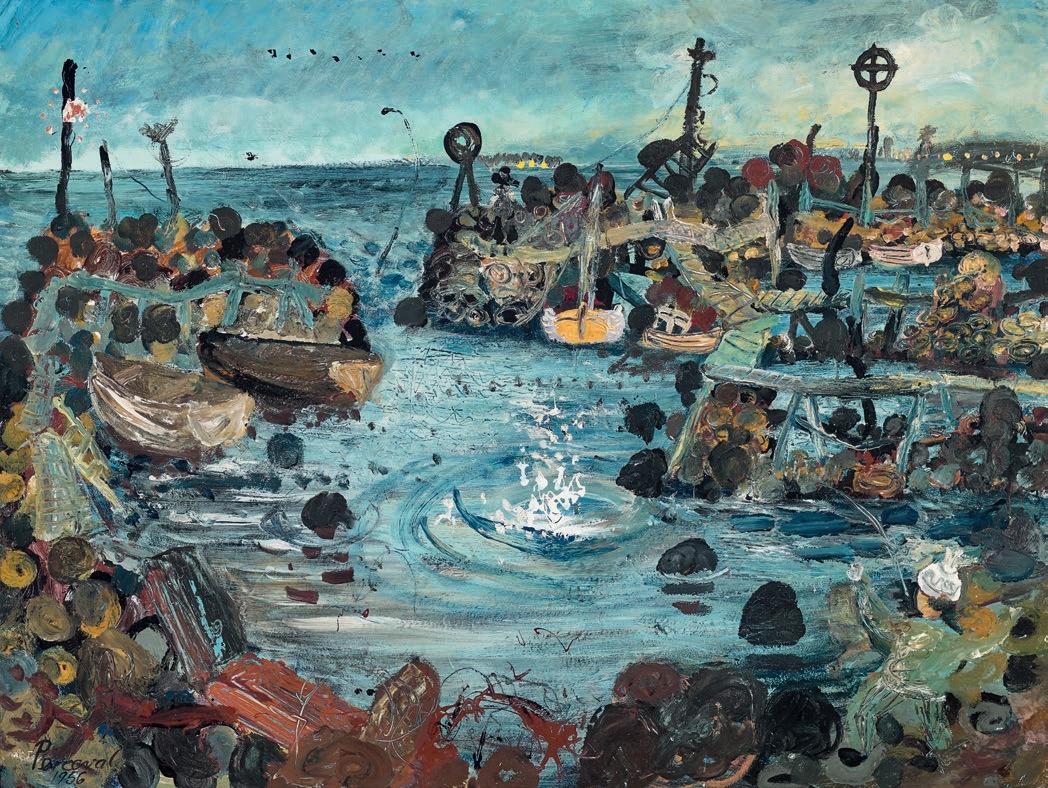
49

Williamstown today is a bustling tourist town on Port Phillip Bay that proudly celebrates its maritime history. Located on the traditional lands of the Bunerong people of the Kulin nation, the area was originally called ‘koort-boork-boork’ (clump of she-oaks), a paradise for sea birds such as gannets, pelicans and black swans. In the mid-1950s, however, when John Perceval first visited, Williamstown was a rundown graveyard of rusting hulks moored amidst the formerly bustling docks, but the artist, in a rapturous mood, described the experience as akin ‘to discovering Venice.’1 Also attracting his attention was a sequence of hand-built boat shelters located at the western edge of the town, and it was here that he painted The splash, 1956, as well as two others works Gannets diving (National Gallery of Victoria), and Fisherman’s sights (Deutscher and Hackett, The Gould Collection of Important Australian Art , Sydney, 15/03/2017, lot 6). Now known as ‘the Williamstown series’, Perceval’s joyous paintings are recognised as an iconic moment in Australian art.
Although the artists Frederick McCubbin and Walter Withers had both painted the docks here in the early part of the twentieth century, few others had found the town worthy of consideration. Having recently bought his first car, an orange Volkswagen beetle, Perceval began exploring the outer regions of Melbourne. In 1956, with Charles Blackman as his passenger, he journeyed across the Yarra River and onwards down to Williamstown. Their mutual excitement was captured perfectly by Blackman in his drawing Portrait of Perceval at Williamstown, 1956 (formerly Dr Joseph Brown Collection), which shows his colleague waving in excitement whilst standing atop the rock walls next to the harbour opening shown in The splash. Known variously as Bayview Harbour, the Secret Harbour, and Jimmy’s Creek, the anchorage lies at the end of Bayview Street and was built in the 1920s by local fisherman
from ‘a combination of rough and dressed bluestone, bricks, concrete rubble and various other combinations of building material.’2 A jumble of wooden walkways linked the individual shelters, and fishermen’s sights were added using old tyres painted white. Three fishing clubs also have their sheds here.
One of the reasons why Perceval’s Williamstown paintings are so celebrated is the highly individualistic approach he took in their depiction and, importantly, in their distinctive technique. In 1944, Albert Tucker introduced Max Hoerner’s influential book The Materials of the Artist and their Use in Painting (published 1921) to Perceval and his brother-in-law Arthur Boyd, and in this they found a wealth of information concerning Old Master techniques with which they began to experiment. They also began to research the artists Hoerner referred to, and Perceval was particularly drawn to the rambunctious peasant scenes of the Northern Renaissance artist, Pieter Breughel the Elder –subsequently painting his own variants set within Melbourne environs, such as Christ Dining at Young and Jackson’s , 1948 (Private collection);; and Flight into Egypt , 1947 – 48 (Art Gallery of Western Australia). The bustling immediacy of these works are direct antecedents of the Williamstown series, and such was his new mastery of mediums and pigment that the noted artist-critic James Gleeson was moved to comment later that ‘John Perceval loves paint and is lavish with it. He loves the warmth or crispness of the air and evokes its quality with the exactness of an Impressionist and the feeling of an Expressionist.’3
In The splash , this description is particularly evident. Due to the number of works he painted at Bayview Harbour, Perceval was no doubt drawn to the independent spirit that had resulted in the boat
50 COLLECTION OF JOAN AND PETER CLEMENGER
Bayview Harbour, 1950s photographer: Bob Leak
 John Perceval in his studio at the Australian National University
John Perceval in his studio at the Australian National University
51
Photographer: The Canberra Times Ltd

John Perceval
Fisherman’s sights , Williamstown, 1956
oil on composition board, 91.5 x 121.0 cm
Private collection
© John de Burgh Perceval/Copyright Agency 2024
harbour’s construction and sought to express his empathy though a bravura technique involving a mix of ‘resinous colour over tempera with a heightening of white, allowing a calligraphic basic drawing and a rather dry scumbled top effect.’4 Perceval painted The splash from a vantage point just outside the eastern wall of the harbour, and takes obvious delight in the tangle of timber walkways and barbed wire surrounding a scatter of typical ‘couta’ boats, surmounted by the handmade fisherman’s sights. On the horizon, the lights of Altona and Point Cook indicate that dusk has begun to fall, whilst at the lower right, a fisherman (wearing Perceval’s signature beanie, so likely a self-portrait) spreads his arms in delight having just witnessed a gannet plunging into the depths in search of a meal. There is a likely symbolism to the ripples left by the gannet, that of the doomed mythological figure Icarus, who drowned after the wings made by his father melted when he flew too close to the sun. Arthur Boyd painted his own version of Pieter Brueghel’s Landscape with the Fall of Icarus , c.1560, 5 and it is plausible that Perceval also had this in mind when he painted The splash
Further cementing the significance of the Williamstown paintings was the manner of their first exhibition. In June 1956, Tam and Anne Purves opened Australian Galleries in Collingwood as a professionally focussed exhibition space, sited in a former warehouse with their extant fabric pattern-making company located at the rear. After selling a couple of paintings by Perceval, the artist asked for a solo show and on visiting his home studio, the Purves encountered a multitude of paintings of Williamstown and Gaffney’s Creek, in the wilderness of Victoria’s Yarra Ranges. Perceval was insistent that they all be shown together, so the Purves made a strategic decision and reconfigured their business to solely focus on the promotion and selling of contemporary Australian art – and Perceval’s exhibition became their inaugural event. Two of the paintings had already been sold prior to the opening, Tug boat in a boat , 1956 by the National Gallery of Victoria, and Early morning –back beach, 1956 purchased by the renowned collector Bruce Wenzel. On his recommendation, Wenzel’s good friend, the timber importer Geoffrey Hillas, purchased The splash and remarkably this was the only
52 COLLECTION OF JOAN AND PETER CLEMENGER
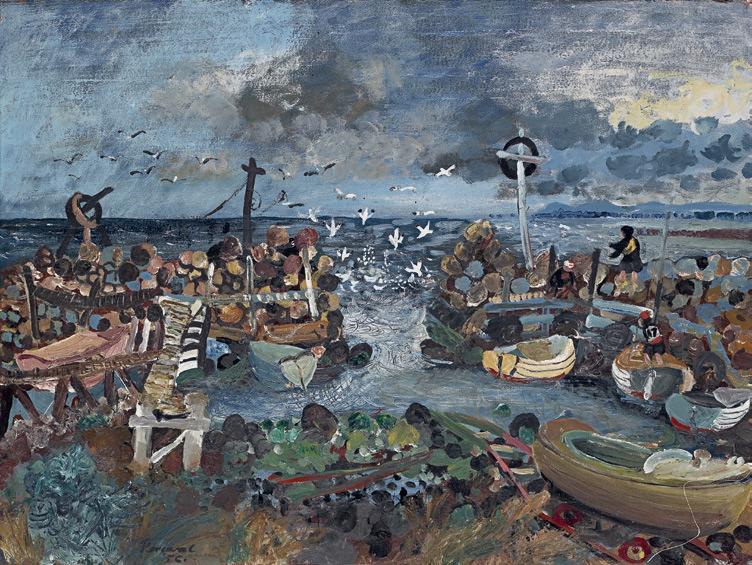
John Perceval
Gannets diving, 1956
enamel paint and gouache on composition board, 91.5 × 122.0 cm
National Gallery of Victoria, Melbourne
© John de Burgh Perceval/Copyright Agency 2024

Charles Blackman
Portrait of Perceval at Williamstown, 1956 ink on paper, 93.2 x 121.0 cm
Private collection
© Charles Blackman/Copyright Agency 2024
painting sold during the exhibition itself. In many ways, this reflected the conservative tenor of collectors at the time but in subsequent years, understanding caught up with Perceval, and examples of the Williamstown series have now entered a number of prestigious collections with the National Gallery of Victoria adding a second work, Gannets diving, 1956 to their collection in 1957.
1. Reid, B., Of Light and Dark: the art of John Perceval, National Gallery of Victoria, Melbourne, 1992, p. 26
2. ‘Jimmy’s Creek: Williamstown Back Beach recreation precinct’, Victorian Heritage Database at https://vhd.heritagecouncil.vic.gov.au/places/13689 (Accessed 11 January 2024)
3. Gleeson, J., Modern painters: 1931 – 1970, Lansdowne Press, Sydney, 1971, p. 95
4. Plant, M., John Perceval, Lansdowne Press, Melbourne, 1971, p. 26
5. See Arthur Boyd, Boat builders, Eden, 1948, in the collection of the National Gallery of Australia, Canberra
ANDREW GAYNOR
53
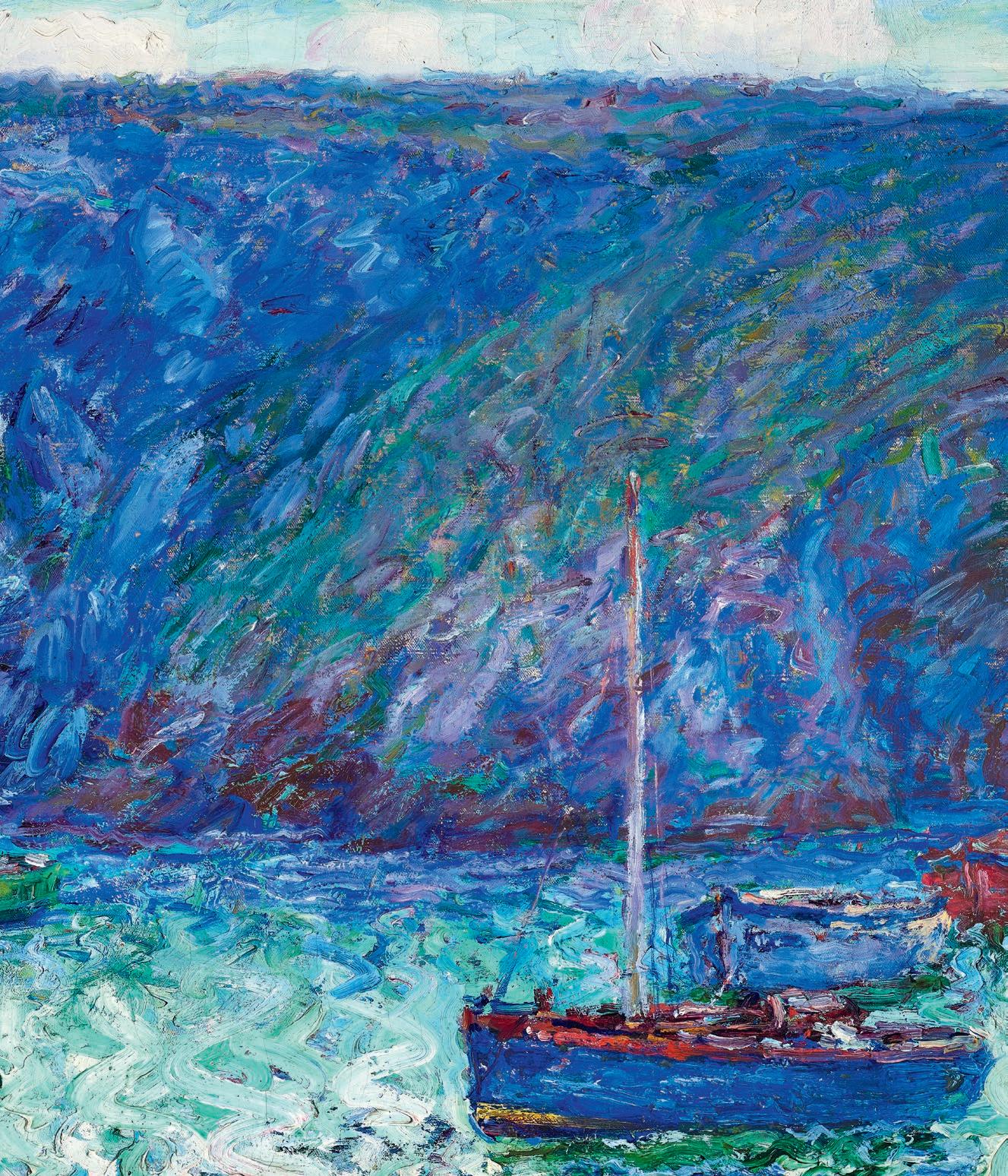
Important
Property of various vendors
Lots 9 – 55
11 John Peter Russell (1858 – 1930) Cruach En Mahr, Matin, Belle–Île–En–Mer, c.1905 (detail) 55
Lot
Australian + International Fine Art
BRETT WHITELEY (1939 – 1992)
BATHER ON THE SAND, 1975 – 76 oil on canvas
122.0 x 90.0 cm
signed and dated lower right: brett whiteley 75-76
ESTIMATE: $1,000,000 – 1,500,000
PROVENANCE
Australian Galleries, Melbourne
Private collection, Melbourne, acquired from the above in September 1976
Australian Galleries, Melbourne
Private collection, Melbourne, acquired from the above in November 1984
EXHIBITED
Recent Interiors, Still Lifes, Windowscapes, Sculptures and Ceramics, Australian Galleries, Melbourne, 21 September – 5 October 1976, cat. 30 (label attached verso)
Brett Whiteley: Recent Nudes, the artist’s studio, Sydney, 3 – 31 October 1981, cat. 44 (illus. in exhibition catalogue)
An Exhibition by Brett Whiteley – Eden and Eve, Australian Galleries, Melbourne, 12 – 28 July 1984, cat. 33 (illus. in exhibition catalogue)
On long term loan to Bendigo Art Gallery, Victoria, December 2005 – March 2024
LITERATURE
McGrath, S., Brett Whiteley, Bay Books, Sydney, 1979, p. 73 (illus.)
Pearce, B., Brett Whiteley: Art and Life , Art Gallery of New South Wales, Sydney, 1995, pl. 64 (illus.), p. 230
Sutherland, K., Brett Whiteley: Catalogue Raisonné, Schwartz Publishing, Melbourne, 2020, cat. 209.75, vol. 3, p. 320 (illus.), vol. 7, p. 348
RELATED WORKS
Justine, Bondi, 1986, oil, charcoal and collage on plywood, 152.3 x 122.0 cm, private collection, Melbourne, illus. in Sutherland, K., op. cit., cat. 74.86, vol. 4, p. 343
After the Swim, Tangier, 1986 – 87, oil, ink, glass eye, sunglasses and cotton t-shirt on board, 152.0 x 122.0 cm, private collection, Sydney, illus. in Sutherland, K., op. cit., cat. 75.86, vol. 4, p. 345
Preliminary sketch for ‘Bather on the Sand’, 1975 – 76, pencil and ink on paper, illus. in McGrath, S., op cit. p. 72
56 IMPORTANT AUSTRALIAN + INTERNATIONAL FINE ART
9

57
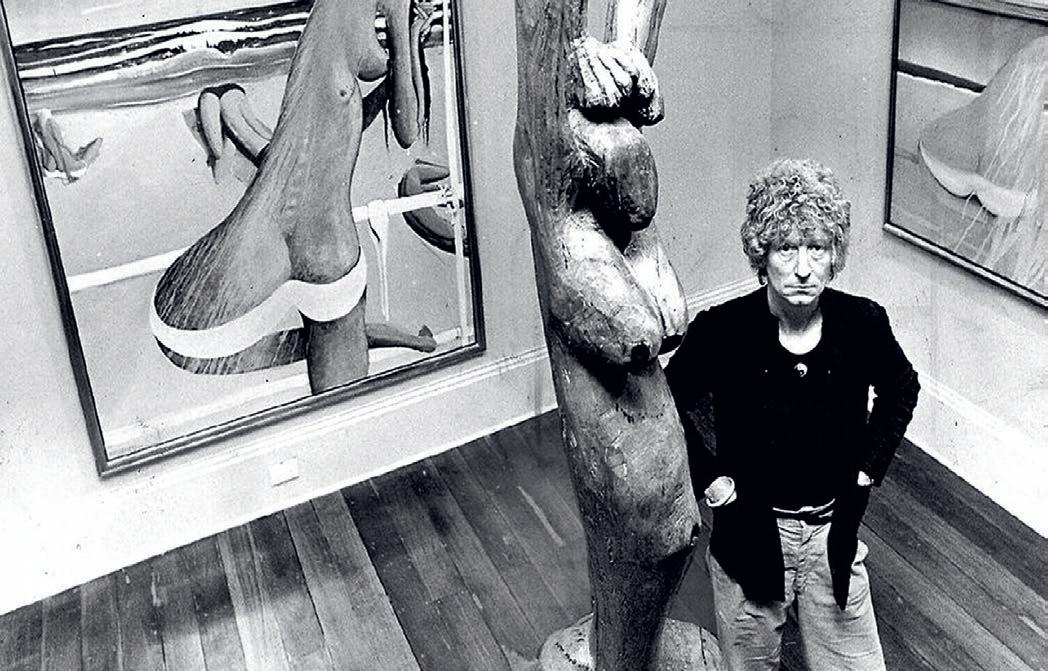
A celebration of the female nude, established canon of Western art history, became one of the most fertile themes within Brett Whiteley’s oeuvre. Catalysed by his semi-abstract ‘Bathroom’ nudes of 1960s London, Whiteley pursued this theme through various media in the 1970s and 1980s, in the form of totemic wooden carvings and languorous sexually charged paintings and drawings of sun-kissed antipodean shores. Looking to the guiding figures of modernist masters Henri Matisse, Pablo Picasso and Francis Bacon, Whiteley considered the nude to be an integral theme within his work. He wrote in the catalogue foreword for a 1981 exhibition devoted entirely recent works of this subject, in which featured Bather on the Sand, 1975 – 76: ‘if genius is the atheist’s word for God… then to attempt to visualise the great nude would be the highest point of creation, for perfection is impossible and no distortion can be extreme enough.’1
Painting Australia’s glittering, busy shore with the ceaseless wonderment of a returned (libidinous) expatriate, Whiteley has rightly since been celebrated as the ‘great Australian painter of female sexuality at the beach’. 2 The Whiteleys were seasoned travellers, and throughout the 1960s they had lived in and visited dozens of cities throughout Europe, Africa, Asia, the Middle East and America. Bather on the Sand, 1975 - 76 was Whiteley’s first major painting of bathers by the sea since returning to Australia in December 1969. An iconic painting within his oeuvre, Bather on the Sand crystallised the distinctive form of the reclining bather in Whiteley’s iconography, inspired by a rapid ink sketch of Wendy at Bondi, with waves lapping in the background – (Study for ‘Bather on the Sand’), 1975 – 76, ink drawing in artist’s sketchbook. A version of this figure study appears pinned to the wall of the artist’s Lavender Bay living room within his Archibald-prize-winning Self Portrait in the
58 IMPORTANT AUSTRALIAN + INTERNATIONAL FINE ART
Brett Whiteley in his studio, 1985 photographer unknown Courtesy Mosman Daily, Sydney

Brett Whiteley
After the Swim, Tangier, 1986 – 87 oil, ink, glass eye, sunglasses and cotton t-shirt on board 152.0 x 122.0 cm
Private collection
© Wendy Whiteley / Copyright Agency 2024
studio, 1976 (Art Gallery of New South Wales), echoed by the vertical forms of his contemporaneous wood carving, Her, 1975. Perhaps by virtue of this constant visual presence in Whiteley’s working and living environment, the winged shape of the reclining bather reappears in several of his major paintings of the beach during the final decades of his life. These include the large landscape painting Balmoral, 1975 – 78, painted around the same time as Bather on the Sand, and then revisited over ten years later in Justine, Bondi, 1986 and After the Swim, Tangier, 1986 – 87 and even within his unfinished Beach Polyptych, 1984/1991 – 92 (all held in private collections).
Stretching out on a faint small towel in a featureless vertical expanse of sand, in the bleaching light of noonday, this buxom bather could be enjoying any stretch of Australian shoreline. Amongst its related
paintings, Bather on the Sand, as the title would suggest, is uniquely devoid of even the slightest sliver of blue sea or rolling waves to orientate the viewer. Having recently completed an entire suite of detailed Wave paintings, Whiteley likely appreciated the stark graphic emphasis on his nude. Her body dominates the canvas, intimately observed in Whiteley’s compressed pictorial space. Although this painting is geographically unspecific, its preliminary sketch appeared in the artist’s notebook amongst sketches of lounging and frolicking bathers at Bondi, which Whiteley had been refining into a busy landscape painting (never realised) titled ‘The Beach’ Revisited. Referring to his 1965 – 66 Pop collage masterpiece painted during a brief Australian sojourn at Whale Beach, The Beach, these sketches continued Whiteley’s hedonistic beach voyeurism and provided source material small group of closely connected paintings developing what Kathie Sutherland qualified
59

B rett Whiteley
Washing the salt off II (After the swim), 1984 oil on canvas, 86.5 x 86.5 cm
National Gallery of Victoria, Melbourne © Wendy Whiteley / Copyright Agency 2024
as ‘the possibilities of distortion and exaggeration.’ 3 The restricted chromatic palette of honey tones and stark composition of Bather on the Sand highlight this plastic manipulation of Whiteley’s figure, turning her into a Matissian arabesque of intertwined limbs.
Brett Whiteley’s nudes all find their genesis in the early ‘Bathroom’ nudes of Wendy created in London between 1962 – 64, whose tender, tense and ambiguous forms were immediately compared to the works of Pierre Bonnard and Francis Bacon. 4 Although Whiteley had met the latter, a titan of London’s art scene, while living there in the early 1960s, his influence would become much more dominant in his next series of nudes, the tortured Christie paintings (1964 – 65). Whiteley’s interaction with Bacon continued even when he had moved back to Australia, through to the mid-1980s when he painted Bacon’s portrait for the Archibald Prize (twice, in 1984 and 1989). Whiteley clarified
Bacon’s influence on his nascent figurative works: ‘I wasn’t absorbed at all by Bacon but coming back into figuration, I could see that he had arrived at devices of expression, especially with the face, that if one was going to paint figuratively, there was no way one couldn’t use some of these discoveries.’5
Whiteley’s bather lies on her belly, although instead of reclining horizontally like a romantic odalisque she faces the viewer, staring with wide eyes ringed with large lashes. Reprising a vulnerable and joyful pose with bent elbows raised frequent in Henri Matisse’s works, cited by Pablo Picasso the following year in the iconic Demoiselles d’Avignon, 1907, the sweeping loops of her elongated arms draw attention to her foreshortened Baconian face. The distorted Janus-face of Whiteley’s ink sketches is repeated here in paint, with aquiline profile and frontal views combined with a startling dash of ultramarine blue around her
60 IMPORTANT AUSTRALIAN + INTERNATIONAL FINE ART
 Brett
Brett
left eye. The bather’s gaze appears unabashed, meeting the artist’s eye with alluring defiance and pouting red lips. She is enjoying and inviting his looming voyeurism. The rhythmic loops of her arms are mirrored by the emphatic arches of her breasts in the foreground (her bikinitop lying open underneath her) and her fleshy derrière, which expands voluptuously through the centre of this painting. It is easy to imagine Whiteley delighting in and emphasising these hilly contours, stretching his own arms across the large canvas to trace the distinctive outline of his subject’s curves.
Bather on the Sand reprises Whiteley’s preferred motif of the bather stretching, arms held aloft in a double-arched shape, first explored after observing his wife’s toilette, washing her hair with a handheld showerhead ( Wendy Under the Shower, London, 1962, private collection). Whiteley was not afraid to follow in Matisse’s footsteps,
enacting the same sacrifice of polished modelling in favour of ‘violent transitions and emphatic simplifications’ that Kenneth Clark identified in this predecessor’s most daring nudes.6 While Whiteley’s bathroom paintings toed the line between graphic abstraction and sensual power, their related forms in paintings of bathers by the sea were decidedly less abstract, which only heightened their overt eroticism. This is particularly true of Bather on the Sand, whose pose is boldly legible against an empty, monochrome background, creating ‘rhythmic patterns and the impression of a rocking movement on the sand.’7
Whiteley’s two-toned sunbather, oblivious to the dangers of overexposure, is not caught in her own reverie as are many bathers in art. In later compositions she pretends to be occupied. She reads books, coyly eyeing the artist over the top of her sunglasses and paperback. Occasionally these accoutrements provide a layer of psychological
61
Whiteley Justine, Bondi, 1986 oil, charcoal and collage on plywood, 152.3 x 122.0 cm Private collection © Wendy Whiteley / Copyright Agency 2024
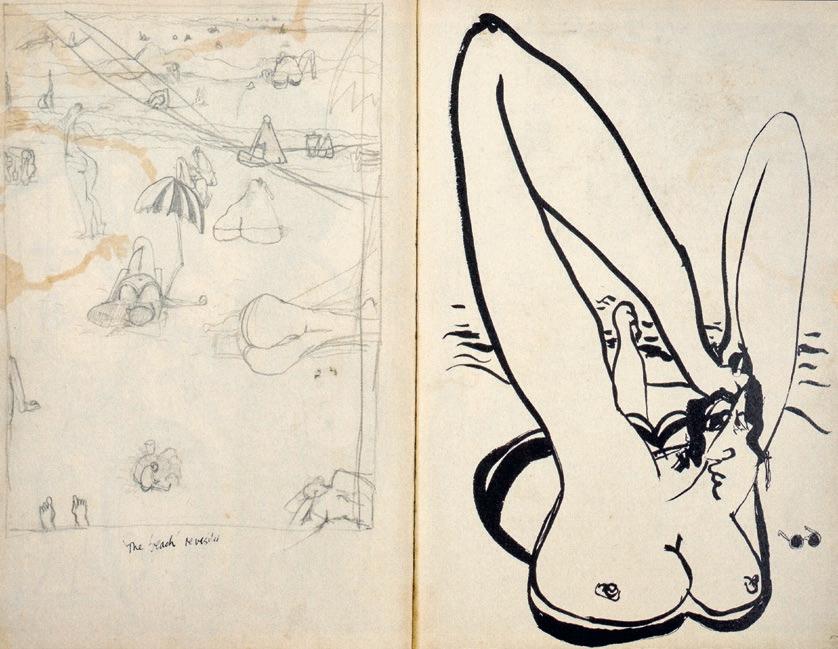
Brett Whiteley
Artist’s notebook with Preliminary sketch for ‘Bather on the Sand’, 1975 – 76, pencil and ink on paper
Whiteley Estate
© Wendy Whiteley / Copyright Agency 2024
depth to the painting, weaving into the image literary themes of sexually emancipated women and complex love triangles. In Bather on the Sand, as she is in the larger landscape composition Balmoral, 1975 – 78, the figure is accompanied only by a tiny toy-like transistor radio. Brett Whiteley was fanatical about music, listening to records while he painted and often incorporating musical themes into his artworks. Here, we can only guess to what music is emanating from the portable device and colouring the bather’s playful wordless interaction with the artist. While other paintings of bathers Whiteley is self-referential, including in the composition a little mise-en-abyme of his own hand copying the scene onto clipboard (for example within the lower right-hand corners of The Beach, 1966 and Sketching at Bondi, 1986 – 87), Bather on the Sand includes no such distancing device between the artist and his
observed subject. Here, Whiteley is entirely in the moment. In 1994, historian Geoffrey Dutton described Whiteley as ‘Australia’s supreme artist of the hedonism of the beach, as well as of sexual comedy [where] abandonment rules.’ 8
In 1974 Brett Whiteley and his wife Wendy purchased the Lavender Bay home that they had been renting since 1970. This period of settled belonging in Australia and a stable loving relationship heralded the beginning of Whiteley’s mature phase as a painter, his house’s sublime views of Sydney Harbour leading to the creation of his most celebrated works. Announcing a new aesthetic manifesto in the exhibition catalogue for his show at Australian Galleries in November 1974, Whiteley wrote: ‘The paintings in this exhibition begin from the
62 IMPORTANT AUSTRALIAN + INTERNATIONAL FINE ART

photographer: John Edwards
Collection & image © Hugh Lane Gallery, Dublin © The Estate of Francis Bacon
premise of recording the glimpse seen at the highest point of affectionpoints of optical ecstasy, where romanticism and optimism overshadow any form of menace or foreboding.’ 9
As it had been briefly for the artist in 1965 at Whale Beach, the potent spectacle of sun and sand of Sydney beaches became a vessel to reimagine his relationship with the country of his birth. The artist wrote in his diary, with his distinctive stream-of-consciousness prose, of idyllic days of summer lassitude with libidinous overtones: ‘Tumbling and telescoping into days, old ways – grinning and brimming apricot hot desire on transparency blue days, of honey-legged girls and halfbaked mateship warming sand to a haze. And what a haze! So gentle – delicious sunny indifference – the freedom of stupor.’10
1. Whiteley, B., ‘Recent Nudes’, exhibition catalogue, Artist’s Studio, Sydney, 1981, n.p.
2. Featherstone, D., The Beach, Australian Broadcasting Company and Featherstone Productions; Sydney, 2000
3. Sutherland, K., ‘Essay: The Nude: the Bathroom, the Bedroom and the Beach’, in her Brett Whiteley: Catalogue Raisonné, Schwartz Publishing, Melbourne, 2020, vol. 7, p. 23
4. op. cit., vol. 7, p. 11
5. Brett Whiteley, cited in McGrath, S., Brett Whiteley, Bay Books, Sydney, 1979, p.58
6. Clark, K., The Nude. A Study in Ideal Form, Princeton University Press, 1990, reprinted by the Folio Society, London, 2010, p. 262
7. Sutherland, op cit. vol. 7, p. 23
8. Dutton, G., On the Beach, On the Beach, Australian Artists at the Shore, Museum of Modern Art at Heide, Bulleen, 1994, p. 17
9. Brett Whiteley, 1974, cited in McGrath, S., Brett Whiteley, Angus and Robertson, Sydney, 1992, p. 130
10. Brett Whiteley, cited in McGrath, 1979, op. cit., p. 75
LUCIE REEVES-SMITH
Brett Whiteley Painting Francis Bacon’s Portrait at Bacon’s studio, 7 Reece Mews, October 1984
63
CHARLES BLACKMAN (1928 – 2018)
WHICH WAY, WHICH WAY?, 1956
tempera and oil on composition board
122.0 x 121.5 cm
signed and dated upper left: BLACKMAN 56
ESTIMATE: $1,000,000 – 1,500,000
PROVENANCE
Barbara Blackman, Melbourne, a gift from the artist in 1957 Private collection, Melbourne, acquired in April 1987
EXHIBITED
Probably: Paintings from Alice in Wonderland, Gallery of Contemporary Art, Melbourne, 12 – 22 February 1957
‘Alice in Wonderland’ by Charles Blackman, Johnstone Gallery, Brisbane, 4 – 21 September 1966, cat. 17
‘Alice in Wonderland’ by Charles Blackman, South Yarra Gallery, Melbourne, 21 – 30 March 1967, cat. 26
Charles Blackman ‘Alice in Wonderland’, David Jones’ Art Gallery, Sydney, 14 – 26 October 1968, cat. 31
‘Alice in Wonderland’ painted in 1956 – 57 by Charles Blackman, Heide Park and Art Gallery, Melbourne, 24 May – 10 July 1983, cat. 28
Charles Blackman: Alice in Wonderland, National Gallery of Victoria, Melbourne, 11 August – 15 October 2006, cat. 4
LITERATURE
Carroll, L., Alice's Adventures in Wonderland: Illustrated by Charles Blackman, A.H. & A.W. Reed, Sydney, 1982, p. 22 (illus.)
Moore, F. St. J., and Smith, G., Charles Blackman: Alice in Wonderland, exhibition catalogue, National Gallery of Victoria, Melbourne, 2006, pp. 17, 46, 47 (illus.), 134
64 IMPORTANT AUSTRALIAN + INTERNATIONAL FINE ART
10

65
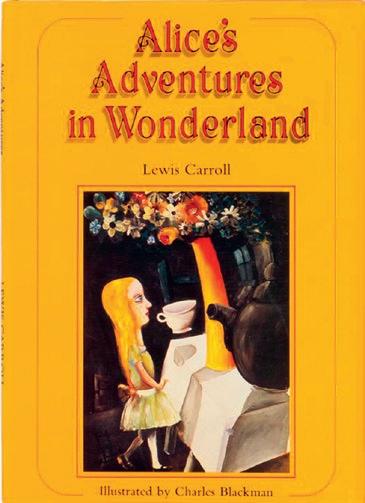
Alice’s Adventures in Wonderland by Lewis Carroll
Illustrated by Charles Blackman, A.H. & A.W. Reed, Sydney, 1982
We are grateful to Felicity St John Moore for kindly allowing us to reproduce the following excerpts from her essay ‘Conception to Birth: The Alice in Wonderland Series’ and catalogue entry for the present work, in St John Moore, F. & Smith, G., Charles Blackman, Alice in Wonderland , National Gallery of Victoria, Melbourne, 2006, pp. 10 – 18, 46
Alice’s adventures began as an improvised tale told to ten-year-old Alice Liddell and her sisters, daughters of the Dean of Christ Church, Oxford, during a boat trip on 4 July 1862. The rest has become part of our heritage. Lewis Carroll, as the pseudonym of the gentle mathematician Charles Dodgson, published the illustrated book Alice’s Adventures in Wonderland in 1865, and it became a classic of children’s literature. Then, in 1871, he published a sequel, also illustrated, Through the Looking Glass and What Alice Found There
Charles Blackman grew up in a family without books. The first time he heard Alice’s Adventures in Wonderland was on a talking book borrowed from the library for the blind in 1956 by his wife Barbara, a writer who had been legally blind since 1950. He therefore experienced the book without the illustrations. ‘I’d never read Alice in Wonderland, although
I’d heard of it of course. And I’d never seen Tenniel’s drawings, which are very famous illustrations to this magnificent and marvelous book, which everyone’s analysing out of their minds eternally. And it means so much to everybody, including me.’1
The recording was beautifully read by Robin Holmes, a BBC announcer. Blackman was twenty-eight, a painter of adolescence and the feminine psyche. In love with symbolist literature, the poetic image, surrealism and Barbara, for Blackman the book was a doorway to his own myth.
Listening to the story again and again, he was struck by the parallels with his own life – not just the feeling that anything could happen but that everything was happening, all at once! As he put to Robert Peach:
‘I was absolutely thrilled to bits with it… and it seemed to sum up for me at that particular moment my feelings towards surrealism, and that anything could happen. The cup could lift off the table by itself, the teapot would… pour its own tea… when [Alice] passes through the mirror. The world is a magical and very possible place for all one’s dreams and feelings. One is completely outside of reality… This was sparked completely off by Barbara’s influence on my life.’2
66 IMPORTANT AUSTRALIAN + INTERNATIONAL FINE ART
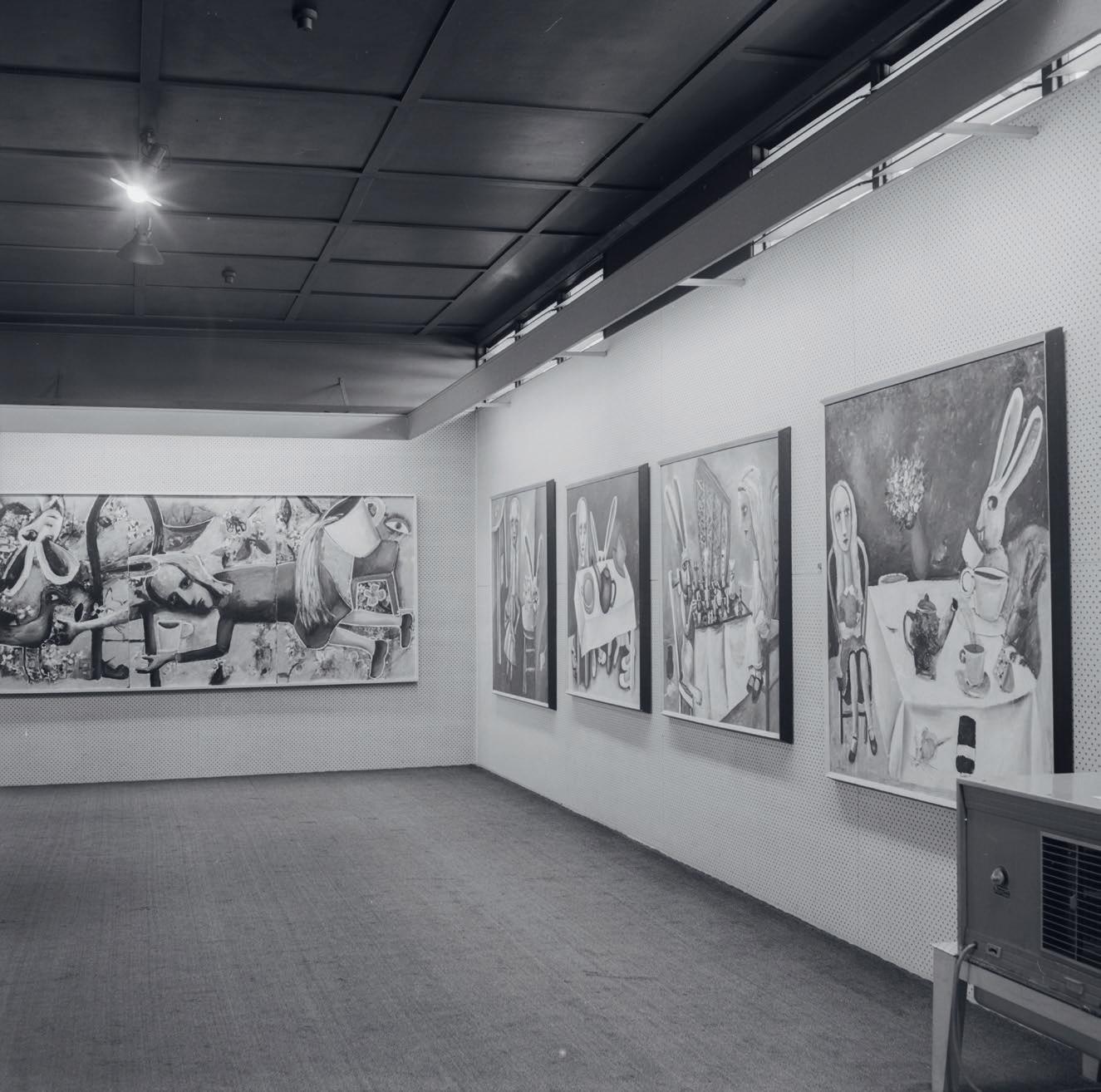
67
Installation view of the Charles Blackman exhibition Alice In Wonderland, Johnstone Gallery, Brisbane, 4-21 September 1966 photographer: Arthur Davenport courtesy of James Hardie Library of Australian Fine Arts, State Library of Queensland, Brisbane


Goodbye Feet , 1956
tempera and oil on composition board, 116.0 x 122.0 cm
National Gallery of Victoria, Melbourne
© Charles Blackman/Copyright Agency 2024
© Charles Blackman/Copyright Agency 2024
Above all, Blackman was struck by the parallel between the fabulous Alice and the familiar Barbara, including her increasing sense of spatial disorientation to which they were both then adjusting. In Barbara’s words, ‘Alice was moving enquiringly, questioningly, trustfully, bemusedly, changefully, into a new and strange world, trying with good sense and honesty to get her bearings in it, however often she seemed to change body shape and whereabouts.’3 For Barbara, these changes in body shape were caused, as it happens, by her first pregnancy, a joyous event which was to coincide with the start of the series proper and lasted the nine-month duration of its making. This pregnancy, which transformed Barbara’s innocence into womanhood, in parallel with Alice’s transformation from dream to reality, became a key to the shaping and evolution of the series.
Pregnancy also had a side effect, ending her work as a life model (thereby impelling the finding of another model for John Brack’s series of nudes), and cutting the earnings that had supplemented her blind pension as their income, allowing Charles the chance to paint full-time. So Charles spent regular time at the Eastbourne Café in Wellington Parade, Melbourne, where he was employed as a short-order chef for his friend Georges Mora and was actually involved with chairs, tables, dishes and people, the paraphernalia of the Alice series. The restaurant came into the paintings:
‘It used to be referred to as the kitchen ballet. I used to leap from fridge to plate… my record was serving a hundred and four meals, three courses, absolutely fully served, of – not haute cuisine, but not bad
68 IMPORTANT AUSTRALIAN + INTERNATIONAL FINE ART
Charles Blackman
Charles Blackman
Alice , 1956
tempera and oil on composition board, 133.0 x 90.0 cm
Heide Museum of Modern Art, Melbourne

food – in under two hours [for a French film crew who came out in advance of the Olympic Games]. You could work it out minute by minute for yourself.’4
Charles came home after his nightly cooking in the restaurant with his head full of spinning plates and teacups; Barbara would say he brought the rabbit into the restaurant at night, and it would help him do the work, and the next day he would paint it all.’5
…The concept of an Alice in Wonderland series was born at the opening of Sidney Nolan’s Ned Kelly series (1946 – 47) exhibition in the new Gallery of Contemporary Art in Melbourne in late June 1956; there began the pregnancies. With the Alice paintings already underway and their personal relevance multiplying by the minute, the concept of the series blossomed. Firstly, the Ned Kelly paintings were literary, based on
the vernacular in captions and jingles, but not illustrative. Secondly, they were also personal, as was known within the walls at the time, relevant to Nolan’s ménage à trois with Sunday and John Reed.
In the same way, the Blackmans had identified their own surreal adventures with the Alice story and Charles would use the series to evoke his personal poetic image. The expressive figure of Alice, as Barbara, is ever present; so (usually) is the White Rabbit, as the artist, Charles, there by implication when not visible. So again is the bouquet, a symbol of creation and carnality, the flowers in the centre of the table as though for a birthday. 6 Then, there is the teapot, a pre-maternal shape with different personalities and roles; the magic bottle, or bottle of change, usually tipping/tilting on the shady side of the picture space; and of course, the white tablecloth with its handy apron, at once a versatile motif and a pictorial device.
69
Charles Blackman
The Blue Alice , 1956-57 tempera, oil and household enamel on composition board, 122.0 x 122.0 cm Queensland Art Gallery | Gallery of Modern Art, Brisbane © Charles Blackman/Copyright Agency 2024


Charles Blackman
The flowers growing , 1956 oil and tempera on composition board, 134.6 x 97.0 cm
Private collection
© Charles Blackman/Copyright Agency 2024
Private collection
© Charles Blackman/Copyright Agency 2024
* * * * * *
‘Oh my poor little feet, I wonder who will put on your shoes and stockings for you now, dears?
I’m sure I shan’’t be able! I shall be a great deal too far off to trouble myself about you: you must manage the best way you can – but I must be kind to them,’ thought Alice, ‘or perhaps they won’t walk the way I want to go! ’7
In this surprising composition, Blackman links Alice’s sense of separation from her body to the threat of separation facing the real Alice (Barbara) and the White Rabbit (Charles) as a result of her pregnancy. Their predicament was an artistic one, the question of whether the White Rabbit should go or stay: choose the path of artistic freedom on the basis that ‘artists don’t need wives’ (as Sunday Reed advised), or stay with his wife and muse, the pregnant Barbara. Cosmus or domus, that was the question. This painting is in the manner of a poetic portrait of the dilemma.
The room itself appears to be both illogical and in a state of becoming, expressing correspondences between the inner and outer, image and colour. The side walls double as changeful skies that stretch back into the corners of a full wall of wildflowers, tunnel-like, under a cloudy, charcoal-grey roof. The floor is in a similar state of becoming, as though illuminated from below, or blue shadows. These dream-like images impart the idea of poetry, transience and uncertainty. So does the childish table, its flask rocking, fore legs washed with pink. On the right, the transforming wainscot leads to the stars through the sunset panels of the door, to the night sky below and outside.
In one direction, this open door points to the sky and twinkling of the friendly stars, implying artistic freedom. In the other, the low diagonal perspective leads back to the skirts of domesticity through the growing figure of Alice. Her moon-like face shines in a golden-haired alcove, above the blue-belling of her skirt. From the depths of her twinkling hem, her ‘bloomering’ eyes peer down her long flamingo legs as the White Rabbit heads back from the night. Notably, his urgent image is
70 IMPORTANT AUSTRALIAN + INTERNATIONAL FINE ART
Charles Blackman
Alice closing up like a telescope , 1956 tempera and oil on composition board, 135.9 x 121.0 cm

dualistic 8 , with two profiles – at once man and beast – his instinctive leap akin to an act of faith. That this is the way of the future is implied by his igniting (with a twist of his extended ear) the visionary bouquet, its skinny vase springing from the centre of the fertile floor. In company with the still-perfumed imagery of earlier creations, such as the shy bouquet over the rose-lipped vase, this newborn and imaginative creation suggests that there are always alternatives. As the White Rabbit can see through the arch of Alice’s legs, left is right and right is left, and her socks are tweedling this way and that.
Both ways lead in the same direction. It doesn’t matter which way – ‘they’re both mad.’ 9
1. Charles Blackman, interview with Robert Peach, Sunday Night Radio Two, ABC Radio, 9 September 1973
2. Charles Blackman, ibid.
3. Barbara Blackman, cited in St John Moore, F., Charles Blackman: Schoolgirls and Angels: A Retrospective Exhibition of Paintings and Drawings, National Gallery of Victoria, Melbourne, 1993, p.4
4. Charles Blackman, op. cit.
5. Charles Blackman, cited in Shapcott, T., The Art of Charles Blackman, Andre Deutsch, London, 1989, p. 13
6. See Freud, S., The Interpretation of Dreams, Macmillan, New York, 1932, p. 374
7. ‘The Pool of Tears’ in Carroll, L., Alice’s Adventures in Wonderland, Macmillan, London, 1974, pp. 16 – 17
8. That this image evolved during the creative process is evident from a pair of sideways ears, overpainted by the artist, their buried outline visible in the raking light.
9. Carroll, op. cit., p. 97
FELICITY ST JOHN MOORE
71
Charles and Christabel Blackman at Charles Blackman: Alice In Wonderland, David Jones Art Gallery, Sydney, 14 – 26 October 1968 photographer unknown courtesy of Charles Blackman papers
JOHN PETER RUSSELL (1858 – 1930)
CRUACH EN MAHR, MATIN, BELLE–ÎLE–EN–MER, c .1905
oil on canvas 60.5 x 73.5 cm
signed lower left: J. P. RUSSELL signed verso: J. P. RUSSELL
artist’s label attached verso, signed and inscribed with title: CRUACH EN MAHR / J.P. RUSSELL / BELLE ÎLE EN MER
ESTIMATE: $1,500,000 – 2,500,000
PROVENANCE
Private collection, France
Christie’s, Melbourne, 28 April 1992, lot 186
Private collection, London, acquired from the above
EXHIBITED
Salon d’Automne, Troisième Exposition, Grand Palais, Paris, 18 October – 25 November 1905, cat. 1388
(as ‘Cruach en Mahr, (matin)’) label attached to frame verso) Belle–Île: Monet, Russell & Matisse in Brittany, Art Gallery of New South Wales, Sydney, 24 November 2001 – 3 February, and touring Queensland Art Gallery 14 February - 21 April 2002, cat. 30 (as ‘Morning, Cruach en Mahr, Belle–Île–en–Mer (Cruach en Mahr, matin, Belle–Île–en–Mer)’)
Australia’s Impressionists , The National Gallery, London, 7 December 2016 – 26 March 2017 (label attached verso)
John Peter Russell: Australia’s French Impressionist, Art Gallery of New South Wales, Sydney, 21 July – 11 November 2018

LITERATURE
Galbally, A., The Art of John Peter Russell, Sun Books, Melbourne, 1977, cat. 168, p. 108
Galbally, A. et al, Belle Île: Monet, Russell & Matisse in Brittany, Art Gallery of New South Wales, Sydney, 2001, pp. 101 (illus.), 127
Riopelle, C. (ed.), Australia’s Impressionists , National Gallery Company and Yale University Press, London, 2016, cat. 41, pp. 59, 107 (illus.), 118, 125
Tunnicliffe, W. (ed.), John Peter Russell: Australia’s French Impressionist, Art Gallery of New South Wales, Sydney, 2018, pp. 88, 145, 146 (illus.), 152 (illus.), 228
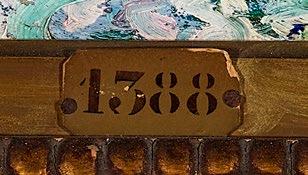
72 IMPORTANT AUSTRALIAN + INTERNATIONAL FINE ART
11

73
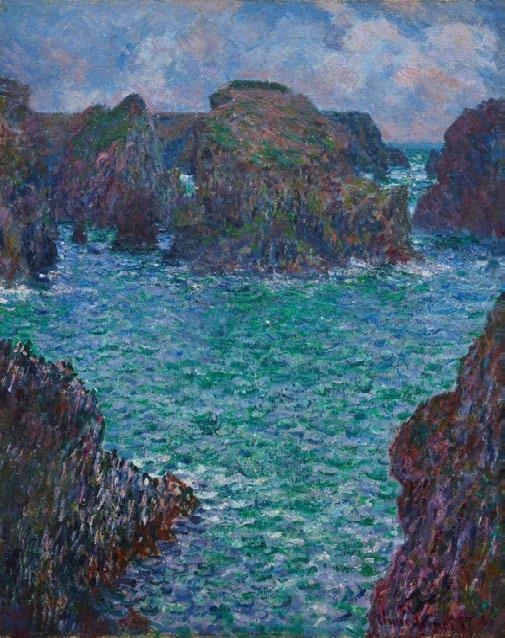
Claude Monet
Port-Goulphar, Belle-Île , 1887 oil on canvas, 81.0 x 65.0 cm
Art Gallery of New South Wales, Sydney
John Russell holds a unique place in Australian art history for his close association with avant-garde circles in 1880s Paris and his firsthand acquaintance with some of the masters of European Impressionism and Post-Impressionism. Following studies at the Slade School, London in 1881, he attended Fernand Cormon’s atelier in Paris in the mid-1880s, working alongside Émile Bernard, Henri de Toulouse-Lautrec and later, Vincent van Gogh. The two artists established an enduring friendship which is documented in their extensive personal correspondence.1 Russell was one of the few artists to paint van Gogh and the 1886 portrait, now in the collection of the Van Gogh Museum in Amsterdam, was treasured by the Dutchman who later asked his brother Theo to ‘take good care of my portrait by Russell which means a lot to me.’ 2 There is also a sheet of profile sketches of van Gogh in the Art Gallery of New South Wales. Russell’s deep interest in Japanese art, which is reflected in the group of spring blossom paintings made during the
late 1880s, was also encouraged by van Gogh who collected Japanese ukiyo-e woodblock prints – developing a collection which numbered in the hundreds – and inspiring his friend to do the same.
On a summer break from Paris in 1886, Russell spent several months on Belle- Î le, one of a group of small islands off the coast of Brittany. It was here that he met and befriended Claude Monet who he saw working en plein air and, recognising his painting style, famously introduced himself by asking if he was indeed ‘the Prince of the Impressionists’. Inevitably flattered, Monet, who was eighteen years Russell’s senior, took a liking to the young Australian and dined with him and his beautiful wife-to-be, Marianna, enjoying their hospitality and company during his stay on the island. Uncharacteristically, Monet allowed Russell to watch him work and on occasion, to paint alongside him, experiences that provided the younger artist with an extraordinary insight into the techniques and
74 IMPORTANT AUSTRALIAN + INTERNATIONAL FINE ART

John Peter Russell
Portrait of Vincent van Gogh, 1886 oil on canvas, 60.1 cm x 45.6 cm
Van Gogh Museum, Amsterdam
working method of one of the founders of the Impressionist movement. The influence on Russell was significant and the paintings he made in Italy and Sicily only a few months later show him working in a new style, using a high-keyed palette (from which black had been banished entirely) and his compositions made up of strokes of pure colour. 3 In addition to showing him how to use colour as a means of expressing a personal response to the subject, Monet’s example also highlighted for Russell the importance of working directly from nature.4
Belle- Î le is part of the accurately named La Côte Sauvage, buffeted by almost constant westerly winds blowing in from the Atlantic Ocean. With a rugged landscape as yet untouched by tourism, it offered little in the way of obvious picturesque views but ‘instead… the challenge of a raw confrontation with nature for which there was no tradition of painterly representation.’ 5 Russell and Monet were both liberated
and excited by the task of representing ‘the solid yet fantastical in the form of the rock formations on the western coastline, with the fluid and the mercurial – the sea, waves and spray … being forced beyond … previous boundaries into unknown territory.’ 6 During his visit to the island, Monet wrote to fellow artist Gustave Caillebotte, ‘I am in a superbly wild country, a heap of terrible rocks and an improbable sea of colours.’7 In July 1888, Russell wrote to van Gogh, ‘I am a painter of nature, of nature’s moods, of sunlight and (the) changing temper of the sea.’ 8 Similarly, Henri Matisse, who visited Belle- Î le in 1895 and met Russell there the following year said simply, ‘Here it is wildness in all its beauty and emptiness.’ 9
Inherited wealth afforded Russell many freedoms and inspired by the possibilities of Belle- Île, he bought land overlooking the inlet of Goulphar in 1887, writing to his friend, Tom Roberts, ‘I am about to build a house in
75

John Peter Russell
La Voile rouge, port de Goulphar, c.1900
oil on canvas, 65.0 x 80.0 cm
Musée d’Orsay | Musée de Morlaix, France
France. Settle down for some five years. Get some work done. It will be in some out of the way corner as much as a desert as possible.’10 Building a well-appointed home known as Château de l’Anglais (or Château de Goulphar), complete with a large studio, workshop and expansive garden, Russell lived there permanently until 1909/10. He came to know the geography of Belle- Î le intimately and as an accomplished yachtsman, often sailed around the island experiencing the physical power and changing moods of the ocean. While La Pointe de Morestil par mer calme (Calm Sea at Morestil Point), 1901 (Queensland Art Gallery I Gallery of Modern Art) describes tranquil waters, Rough sea, Belle- Î le , 1900 (National Gallery of Victoria), captures the opposite extreme in a luminous example of Russell’s painterly dynamism, the energy of his brushstrokes mirroring the turbulence of the ocean. Russell scholar Ann Galbally has described the ‘intensity of vision’ that characterises the works made on Belle- Î le, where his focus on a limited range of
subjects – the sea, the rocks, rugged coastline and figure studies –encouraged bold formal experimentation in paintings that captured the changing light and atmospheric conditions of the environment, as well as displaying his committed pursuit of pure colour.11
Cruach en Mahr, Matin, Belle-Île-en-Mer, c.1905 is one of a group of paintings produced around the turn of the century that depicts the tranquil waters of Port Goulphar. Painted from a location close to Russell’s home on the south-western side of the island, it describes a view that was very familiar to him. Looking across the protected bay, it takes in a group of moored fishing boats in the foreground, the rocky coastline and undulating hillside which rises up dramatically almost to the top of the canvas, capped by a sliver of sky. The red sail, Port Goulphar, c.1900, in the collection of the Musée d’Orsay/ Musée de Morlaix, depicts a similar view, although the palette could not be more
76 IMPORTANT AUSTRALIAN + INTERNATIONAL FINE ART

John Peter Russell
Roc Toul, Roche Guibel, 1904–05 oil on canvas, 98.4 x 128.0 cm
Queensland Art Gallery | Gallery of Modern Art, Brisbane
different, as vivid colours reflect the bright sunshine of mid-afternoon. By contrast (and as the title indicates), the predominantly blue, green and purple colour palette of Cruach en Mahr, Matin, Belle-Île-en-Mer –describes a morning view, before the sun has fully risen and while the hillside and water’s edge are still cast in deep shadow. Russell describes the gentle, rhythmic movement of the water in freely applied squiggles of paint and the hillside is composed of layered brushstrokes of intense colour, as well as glimpses of exposed raw canvas. Russell’s brilliance as a colourist is on full display in this painting, as is his ability to communicate as much about the feeling of being in the landscape as its physical and geographical features. Adopting the Impressionist practice of painting the same subject at different times of the day and during different seasons, Russell had an indefatigable interest in exploring the varied effects of light and weather and the resulting chromatic range of this familiar and yet ever-changing landscape. Continually inspired by
Belle- Î le, he wrote ‘the colours completely bowl me over. On some days here it’s ravishing but impossible for my poor palette.’12
Russell evidently regarded this painting highly, as it is one of only a small number he chose to exhibit publicly during his lifetime. He entered it into the 1905 Salon d’Automne, the newly-established annual exhibition held at the Grand Palais in Paris, which displayed the most progressive contemporary art, and the label attached to its frame is evidence that it was accepted and catalogued as number 1388. The 1905 Salon d’Automne is particularly significant as the occasion on which the term ‘Fauvist’ was coined in response to the ‘wild dashes of colour’ in the new paintings of Henri Matisse, André Derain and Maurice de Vlaminck. It is apposite that Russell was represented in this salon given the role he had played in the dramatic transformation of Matisse’s approach to colour and indeed, given his own reputation as one of the most daring and
77

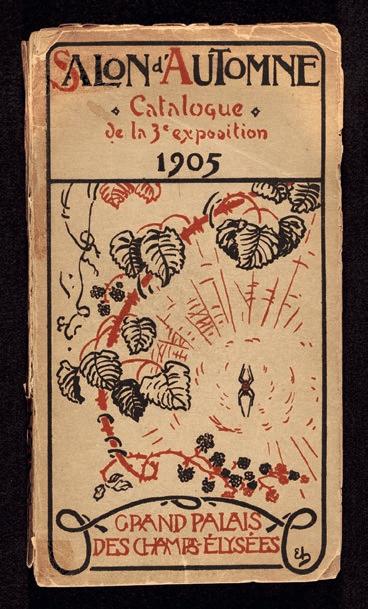
talented colourists of his day. The young Frenchman spent three months on Belle- Î le in 1896, fortuitously meeting Russell who subsequently introduced him to Monet’s techniques and to the work of van Gogh, gifting him one of the pen and ink drawings the Dutchman had sent him from Arles some years earlier. This encounter contributed to the development of what his biographer, Hilary Spurling, described as ‘a way of seeing: the first inklings of the pursuit of colour for its own sake that would draw in the end on his deepest emotional and imaginative resources.’13
In more recent years Cruach en Mahr, Matin, Belle-Île-en-Mer has been included in several important exhibitions: Belle-Île: Monet, Russell & Matisse in Brittany at the Art Gallery of New South Wales in 2001; the John Russell retrospective, Art Gallery of New South Wales, 2018 and the 2016 – 17 exhibition, Australia’s Impressionists , at the National
Gallery, London. The first ever exhibition in the United Kingdom to focus on the art of Australia’s Impressionists, this show was part of the National Gallery’s expanded mission to collect, display and study the work of artists working within the tradition of European representational painting but further afield, away from the places usually acknowledged as the centres of artistic production.14
Elaborating on the significance of Cruach en Mahr, Matin, Belle-Îleen-Mer within Russell’s oeuvre and its importance in the exhibition, the Director of the National Gallery, Dr Gabriele Finaldi wrote, ‘This unconventional view of the coastline of Port Goulphar not yet fully illuminated by the rising sun suggests the lessons Russell absorbed from painting en plein air alongside Claude Monet, and the indefatigable interest Russell developed for capturing the varying effects of light and weather on the rugged landscape of his adopted home of Belle- Î le. In its
78 IMPORTANT AUSTRALIAN + INTERNATIONAL FINE ART
Catalogue for the 1905 exhibition of the Salon d' Automne at the Grand Palais Des Champs Elysees, Paris, France Smithsonian Institution, Washington DC
Louis Freon
Portrait of John Russell, Neuilly, Paris , c.1908 National Library of Australia, Canberra

Belle-Île-en-Mer, Le Port de Goulphar with Russell’s house ‘Le Chateau Anglais’ prominent above the cliff, c.1909
complex layering of intense, contrasting colour, veiled with the dominant key of electric blue, we see Russell in full force as a colourist, exploring the dense chromatic modulations of shadow.’15
Russell played a crucial role in the exhibition and indeed, an entire section of the display was dedicated to his art. Shown alongside Tom Roberts, Arthur Streeton and Charles Conder, Russell’s significant place among the very best of Australia’s artists working in the late nineteenth and early twentieth centuries was made clear, as was his utterly unique role as a vital and direct link between Australian art and French Impressionism and Post-Impressionism.
Alongside these national and international exhibitions of Russell’s work, institutional acquisitions have taken place as galleries and museums strive to ensure their collections represent the best of his painting. The offering of this painting represents an increasingly rare opportunity to acquire a major painting by John Russell.
1. Although Russell did not see van Gogh again after he departed for Arles in the south of France in early 1888, their friendship continued via correspondence. See Galbally, A., A Remarkable Friendship: Vincent van Gogh and John Peter Russell, The Miegunyah Press, Carlton, 2008
2. Taylor, E., ‘John Russell and friends: Roberts, Monet, van Gogh, Matisse, Rodin’, Australian Impressionists in France, National Gallery of Victoria, Melbourne, 2013, p. 56
3. ibid., p. 60
4. Prunster, U., ‘Painting Belle- Île’, in Prunster, U., et al., Belle- Île: Monet, Russell and Matisse exhibition catalogue, Art Gallery of New South Wales, Sydney, 2001, p. 31
5. Galbally, A., ‘Mer Sauvage’, in Prunster, U., ibid., p. 14
6. Galbally, 2001, op. cit., p. 13
7. Prunster, ‘Painting Belle- Île’, op. cit., p. 19
8. ibid., p. 29
9. ibid.
10. Russell to Tom Roberts, 5 October 1887, cited in Tunnicliffe, W., (ed.), John Russell: Australia’s French Impressionist, Art Gallery of New South Wales, Sydney, 2018, p. 193
11. Galbally, 2001, op cit., p. 15
12. Russell to Auguste Rodin, April-May 1890, cited in Prunster, ‘Painting Belle- Île’, op. cit., p. 46
13. Spurling, H., The Unknown Matisse: A Life of Henri Matisse, Volume One: 1869-1908 , Hamish Hamilton, London, 1998, p. 144, cited in Taylor, op. cit., p. 65
14. See Riopelle, C., ‘Australia’s Impressionists in a World Context’ in Australia’s Impressionists, National Gallery Company, London, 2016, pp. 14 – 16
15. Dr Gabriel Finaldi to the vendor, 16 June 2016
KIRSTY GRANT
79
MARGARET PRESTON
(1875 – 1963)
ANEMONES, 1916
oil on cardboard
55.5 x 46.0 cm
signed and dated lower right: M.R. Macpherson / –1916 unfinished still life verso artist’s label attached to backing board verso inscribed: – “Anemones” – / by Margaret Preston / Exhibited [ind.] / Royal Academy etc. etc. inscribed with names and addresses on backing boards
ESTIMATE: $220,000 – 280,000
PROVENANCE
Gladys Reynell, Adelaide
Emily Lucy Walters (née Reynell; sister of Gladys Reynell), Adelaide
Thence by descent
The Rev. and Mrs John Reynell Walters, Adelaide and Sydney
Thence by descent
Walters Family collection, Sydney
EXHIBITED
Royal Academy of Arts 148th Annual Exhibition, Burlington House, London, 1 May – 7 August 1916, cat. 138 (as ‘The Window’) Exhibition of Paintings etc. by Misses Margaret R. MacPherson and Gladys Reynell, Preece’s Gallery of Australian Art, Adelaide, 15 – 30 September 1919, cat. 3 (as ‘The Window’) (postal labels attached to plywood backing)
The Art of Margaret Preston, Art Gallery of South Australia, Adelaide, 23 May – 22 July 1980, and touring to the National Gallery of Victoria, Melbourne, and Art Gallery of New South Wales, Sydney, cat. O.10 (label attached to frame verso)

12
LITERATURE
‘Personal’, The Journal, Adelaide, 23 June 1916, p. 1
‘”Australia for Artists” – Macpherson – Reynell Exhibition.’, The Journal, Adelaide, 15 September 1919, p. 1
‘”Australia for Artists!” – Macpherson – Reynell Exhibition.’, The Register, Adelaide, 16 September 1919, p. 5
Ure Smith, S., & Gellert, L. (eds), Art in Australia, Margaret Preston Number, 3rd series no.22, Art In Australia Ltd, Sydney, 1 December 1927, pl. 1 (illus.)
Preston, M., ‘From Eggs to Electrolux’, ibid., n.p.
‘Art in Australia’, The Register, Adelaide, 17 December 1927, p. 5
North, I., The Art of Margaret Preston, Art Gallery board of South Australia, Adelaide, 1980, pp. 7, 34 (illus.), 46 (illus.), 77, 85
Edwards, D., Peel, R. and Mimmocchi, D., Margaret Preston, exhibition catalogue, Art Gallery of New South Wales, Sydney, 2005, pp. 41, 48, 51
Margaret Preston Catalogue Raisonné of paintings, monotypes and ceramics , Art Gallery of New South Wales, Sydney, 2005, CD–ROM compiled by Mimmocchi, D., with Edwards, D., and Peel, R. cat. 1916.4
80 IMPORTANT AUSTRALIAN + INTERNATIONAL FINE ART
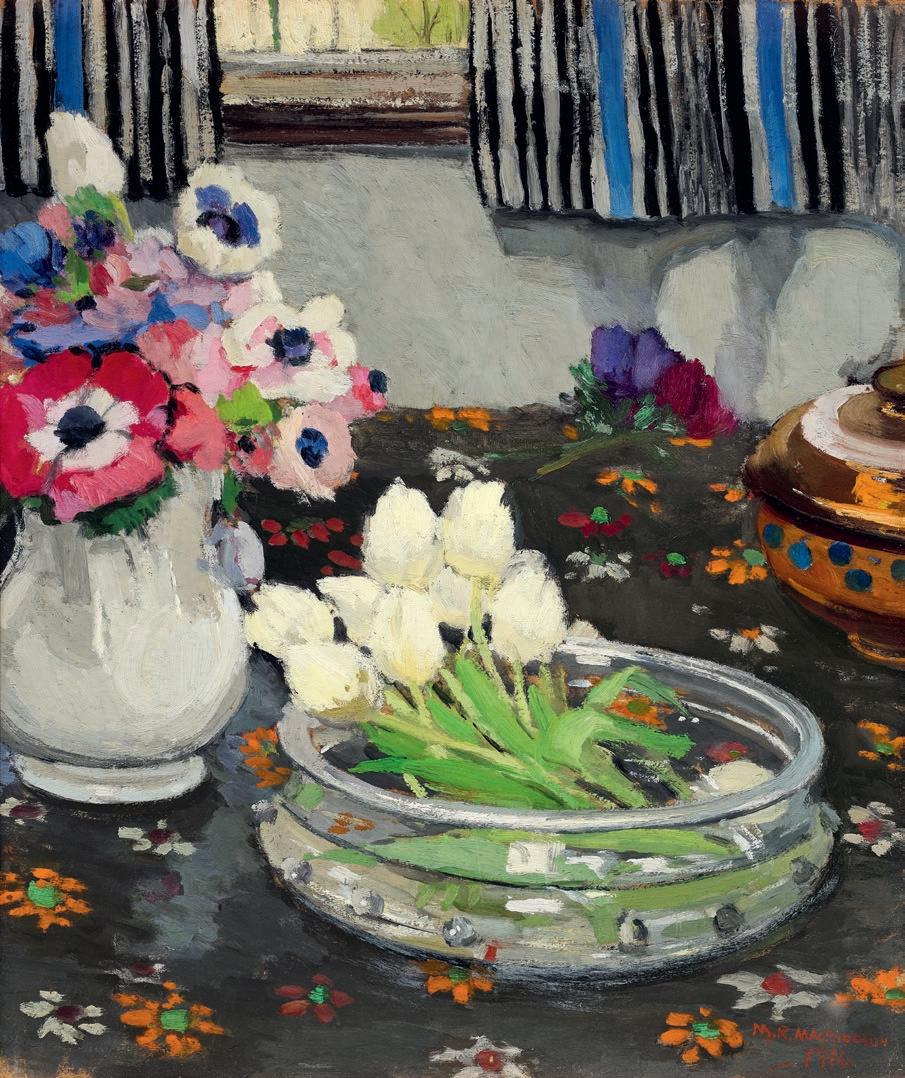
81
In October 1913, after eighteen months in France, Margaret MacPherson (later known by her married name of Preston) travelled to London in the company of her close friend Gladys Reynell. Before leaving, she wrote to her Australian colleague Norman Carter that ‘I’m very keen to try to show at some of the small shows in London, and having exposed three times in Paris and at a fair number of small shows there, feel I can still send to the Salons and explore other fields.’1 This is a surprisingly understated comment from the otherwise headstrong and forthright Preston, who was already heralded as a ‘splendid painter of surfaces, a beautiful painter of paint’ 2; and indeed, her works shown previously in the Paris Salons had also been favourably received. 3 From the 1920s, Preston became one of the most progressive modernist artists in Australia as she sought to construct a truly national art of this country. Anemones , 1916, however, dates from an equally important, earlier period when the London-based artist rigorously explored Post-Impressionist principles of colour and design, underscored by an active analysis of the shallow space and linear rhythms of Japanese woodblock prints.
Preston’s talent was evident from an early age. She first studied at the National Art School in Melbourne, before returning to Adelaide and starting a teaching Academy there in 1899. In 1904, with her student and now intimate friend Bessie Davidson, she left for Europe where for a short period, she undertook classes at the Munich Government School for Women. Following this, the friends travelled to Paris where they were befriended by the expatriate painter Rupert Bunny, who stressed the importance of decoration, of ‘decoration without sacrificing truth’ and ‘decorations, pure and simple.’4 Her experiments towards those goals was further informed by visits to the retrospectives of Cézanne and Gauguin. Preston also experienced the infamous 1905 Autumn Salon where she was ‘startled’ by the wild colour and energy of Matisse; indeed, she may have also be seeking out the colourdrenched impressionist work of fellow expatriate John Peter Russell which hung in another gallery at this Salon [Cruach en Mahr, (matin), (lot 11). These experiences gave Preston a new sense of the subjectivity of vision, alerting her to the liberating possibilities of pure colour and clear design. Returning to Adelaide in 1907, she re-established her studio and school, then left again for London in 1912, this time accompanied by another former student, Gladys Reynell. They only stayed a month before heading to Paris, where Preston reconnected with Bunny and Davidson. She had two paintings accepted for the New Salon, and following the return to London in 1913, Preston showed at the Royal
Academy, scoring yet another personal success as ‘she was reported as a ‘colourist’. This let her know definitely the move had been made… From now on she allowed herself full licence in colour – only letting her subjects appear as realistic as her aesthetic feelings allowed.’5 Although they appear gentle to contemporary eyes, the images Preston began painting in the lead-up to Anemones were among the most radical modern works yet created by an Australian artist during those years.
The term ‘decorative’ has often been used dismissively when describing artworks, particularly when discussing the work of women artists. It would also haunt any description of Preston’s imagery during her long career, but for her, it was anything but a negative. Instead, she used the word ‘in the modern sense as an antidote to tonal illusionism to describe its emphasis on a set of aesthetic ‘truths’ closely aligned to forms of post-impressionism.’6 The works created at the studio she shared with Reynell in Battersea, London, chart her dedicated quest to align her abilities with this new vision, stating ‘I am trying all I know to reduce my still-life to decorations and find it fearfully difficult.’7 One pertinent example is Nasturtiums , c.1916 (Art Gallery of New South Wales) which shares the same table-before-window location as Anemones , but is painted in unnatural tones of ochre and brown, highlighted with red. This includes the striped curtains (in spite of the different palette, their distinctive pattern is identical) which hang behind two earthenware jugs sitting on the table and window sill; and whilst these different levels accentuate the illusion of depth, the flat, drier application of paint and tilted aspect equally alludes to flatness. In Anemones , again Preston utilises the still life as a focus (or ‘laboratory table’ in her own description) for these intentions, employing ‘a scale of colour to suit herself… with the combination of realism.’ 8 There is a freshness and vitality to Anemones ’ otherwise formal tableau, again set at a slightly tilted angle and enlivened by the contrast of the striped curtains set against the dark background of the floral table cloth (fabric design was another passion for the artist). To the right sits a covered pot patterned with blue dots which Preston had depicted earlier in Primroses , 1915 (the D R Sheumack Collection) whilst in the centre, a circular glass bowl
82 IMPORTANT AUSTRALIAN + INTERNATIONAL FINE ART
(right page)
Margaret Preston in her Adelaide Studio, c.1909 courtesy of State Library of South Australia, Adelaide


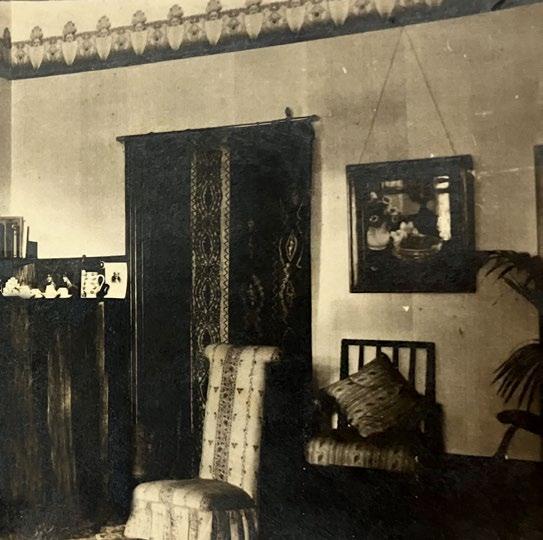
is filled with white tulips. Technically, she applied the white of the tulips last which brings the background ‘radically forward, allowing her to simulate the flattened spaces of ‘the decorative’’ thus using modernism ‘within the space of naturalism.’ 9 Anemones, 1916, is an incredibly clear and vibrant painting, cosy but not cluttered, direct but not illusionary.
The centrality of the glass bowl also helps clarify a hitherto unsolved conundrum, namely that Preston exhibited this painting under an alternate title, The window, at the Royal Academy of Arts in London in 1916 (cat. 138) alongside a second work also titled Anemones (cat. 731); and again three years later at Preece’s Gallery in Adelaide. Why she did so is unclear, as another work from 1916 is also titled The window ; plausibly it may simply have been to avoid the confusion of having two works titled Anemones at the Royal Academy. The setting for this alternate version of The window, 1916 (private collection) is the same location as the work on offer here, but showcases more of the window’s fretted inner frame. Importantly, it does not feature a glass bowl, the presence of which was very clearly described in reviews from each
exhibition, viz (from 1916) ‘For sheer beauty of painting and colour there is nothing by any other woman to equal Miss Margaret R Macpherson’s “The window”. The glass dish, with the flowers particularly, shows a real gift of observation and clear expressive technique.’;10 and from 1919, ‘“The window”, was one of the gems, with the central study of a glass dish and flowers conveying a sense of restfulness.’11 These observations confirm the alternate exhibition title for Anemones , whilst the work exhibited under that title at the Royal Academy (cat. 731) was most likely Anemones , 1915 – 1916 (private collection, formerly Deutscher Fine Art), an opinion backed up by an inscription verso which reads ‘ROYAL ACADEMY / 1916 / 299 / 6...’ This earlier variant has the anemones in a different glass bowl (the tulips are in a ceramic vase at the rear), but the illusion of reflection and transparency of the glass bowl in the work on offer here is far more believable and technically resolved, thus more likely to attract critical acclaim. Additionally, Anemones , 1915 – 1916, is predominantly painted in tones of white, lacking the ‘sheer beauty of… colour’, as quoted above, another key characteristic of this lot, Anemones , 1916.
84 IMPORTANT AUSTRALIAN + INTERNATIONAL FINE ART
Margaret Preston and Gladys Reynell with Little Jim, c.1915 courtesy of Art Gallery of New South Wales, Sydney
Interior of Reynella House with Anemones displayed, c.1925 Walters family archive
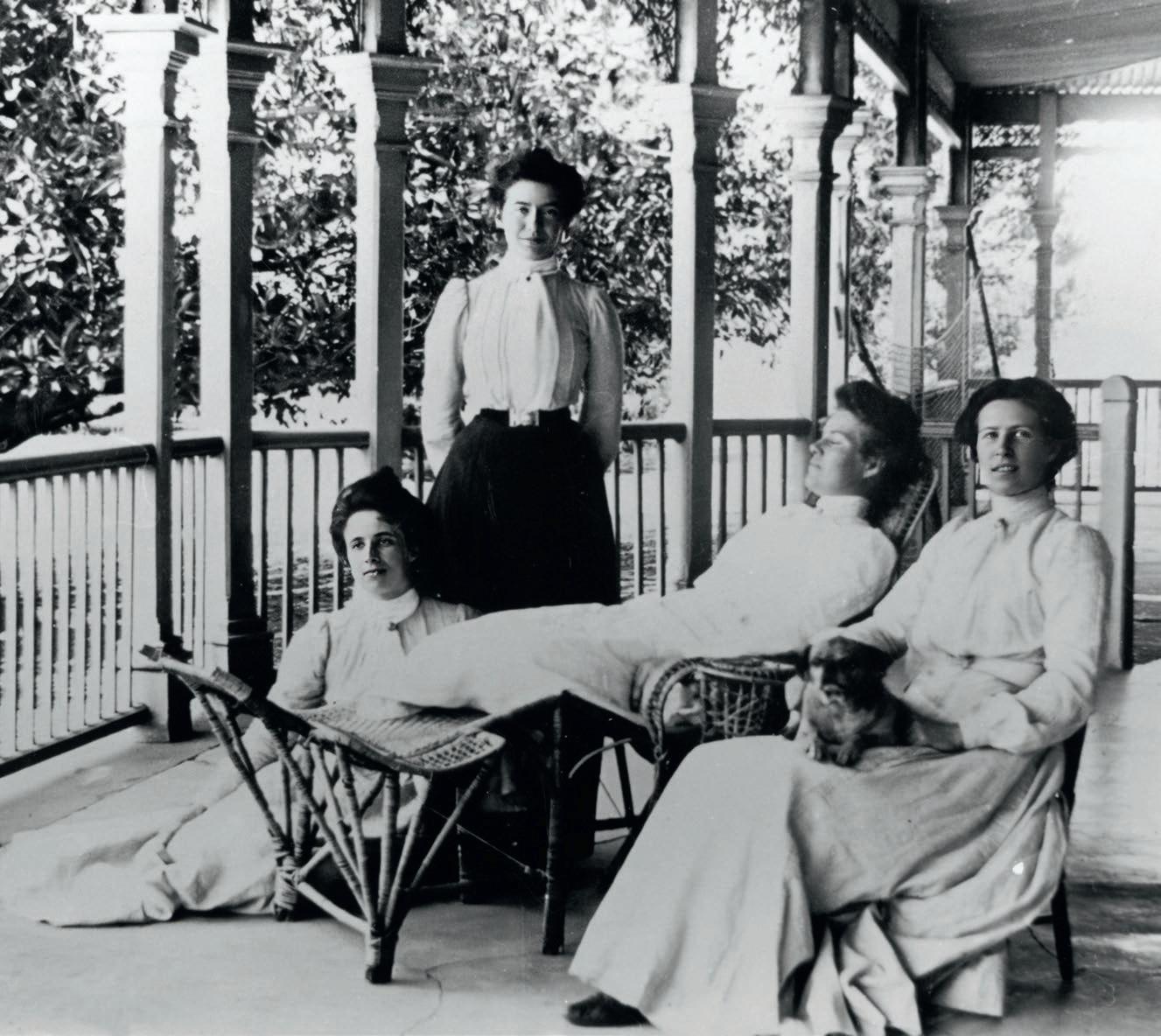 Four young women relaxing at the Reynell family home, featuring Gladys (seated on the floor) and Emily (with the dog on her lap), c.1905
Four young women relaxing at the Reynell family home, featuring Gladys (seated on the floor) and Emily (with the dog on her lap), c.1905
85
State Library of South Australia, Adelaide
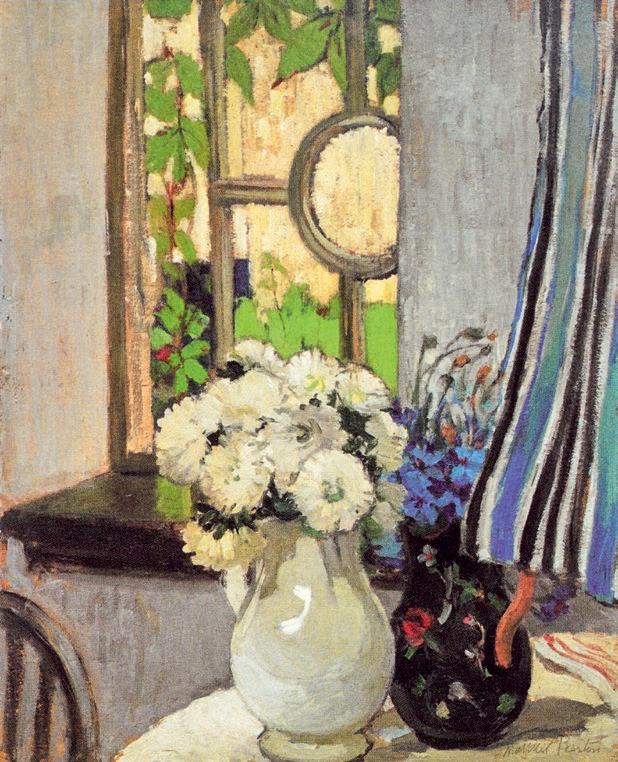
Margaret Preston
The Window, c.1916
oil on cardboard, 61.0 x 49.9 cm
Private collection
© Margaret Preston/Copyright Agency 2024
The painting also has a direct connection to Gladys Reynell and was photographed in situ on a wall of the family home ‘Reynella’ in the mid1920s. It was returned to the artist by Preece’s after MacPherson’s marriage to Bill Preston in late 1919, as the postal label is addressed ‘Mrs W.G. Preston, Glenorie, Musgrave Street, Mosman’ where the couple lived until August 1922. During a research examination for this auction, the backing board was removed which revealed a second sheet of plywood, inscribed in Preston’s hand as being addressed to ‘Miss G. Reynell, Reynella, South Australia’, sent from Musgrave Street. In a curious coincidence, Gladys Reynell married George Osborne also in August 1922 which leads to the strong implication that Anemones was a
wedding gift, particularly given its association to their shared Battersea studio. As Reynell’s marriage was not viewed favourably by the family, the newlyweds moved to Ballarat and set up Osrey Pottery, where they worked until 1926 when, due to George becoming ill with lead poisoning, they moved to Curdievale, Victoria. In 1927, when Art and Australia reproduced Anemones in their special ‘Margaret Preston Number’, the painting was listed as belonging to Glady’s sister Emily. Whilst Anemones stayed at Reynella House after the marriage (as indicated by the c.1925 photograph in the Walters family archive), a further supposition here is that Gladys may have sold it to her sister to augment their finances when she and George moved to Victoria.
86 IMPORTANT AUSTRALIAN + INTERNATIONAL FINE ART

Margaret Preston
Anemones , 1916
oil on canvas, 55.0 x 45.0 cm
Private collection
© Margaret Preston/Copyright Agency 2024
Anemones , 1916, was a pivotal moment for Preston, name checked as such in her autobiographical article From eggs to Electrolux , published in 1927. Still housed in its original frame and with an impeccable provenance, Anemones is a significant painting from so many angles but above all, it is indeed decorative and full of beautiful paint and splendid surfaces.
1. Margaret MacPherson, correspondence with Norman Carter, 1913, cited in Butel, E., Margaret Preston, Imprint, Sydney, 1985, reprint edition, 1995, p. 14
2. Anonymous, ‘The art of the year’, Lone hand, Sydney, 1 April 1910, p.676, cited in Edwards, D., Peel, R. and Mimmocchi, D., Margaret Preston, Art Gallery of New South Wales, Sydney, 2005, pp.31, 32
3. Preston was in France between April 1912 and October 1913. Whilst there, she exhibited twice at the Société Nationale des Beaux-Arts Salon (New Salon) in 1913 and 1914. In London, Preston exhibited with the New English Art Club yearly from 1913 until 1918; and with the Royal Academy 1914, 1915 and 1916. Margaret MacPherson, correspondence with Norman Carter, 1913, cited in Butel, op. cit., p. 14
4. Edwards, et al., op. cit , p.41
5. Preston, M., ‘From eggs to Electrolux’, Art and Australia, Margaret Preston Number, 3rd series no. 22, 1 December 1927, n. p.
6. Edwards, et al., op. cit., p. 24
7. Margaret MacPherson, correspondence with Norman Carter, 1913, op. cit
8. Preston, M., ‘From eggs to Electrolux’, op. cit
9. Edwards, et al., op. cit , p. 48
10. ‘Personal’, The Journal, Adelaide, 23 June 1916, p. 1
11. “Australia for Artists” – Macpherson - Reynell Exhibition.’, The Journal, Adelaide, 15 September 1919, p. 1
ANDREW GAYNOR
87
RUPERT BUNNY
(1864
– 1947)
AT THE PUMP, c .1908
oil on canvas 60.0 x 73.0 cm
signed lower left: Rupert C. W. Bunny inscribed with title on stretcher verso: At the pump
ESTIMATE: $250,000 – 350,000
PROVENANCE
Anthony Hordern and Sons, Sydney
Private collection
James O. Fairfax AC, New South Wales, and Bridgestar Pty Ltd, Sydney
Important Australian Works of Art from the estate of the late James O. Fairfax AC , Deutscher and Hackett, Sydney, 30 August 2017, lot 17
Private collection, Sydney, acquired from the above
EXHIBITED
Exposition Rupert C. W. Bunny, Galeries Georges Petit, Paris, 10 – 31 March 1917, cat. 22 (as ‘La Pompe’)
Exhibition of Paintings by Rupert C. W. Bunny, The Fine Art Society Gallery, Melbourne, 15 – 27 November 1922, cat. 36
Exhibition of Oil Paintings by Rupert C. W. Bunny, Anthony Hordern and Sons, Sydney, 2 – 31 May 1923, cat. 36
Rupert Bunny Retrospective , Newcastle City Art Gallery, New South Wales, 31 July – 3 September 1968, cat. 8 (dated as c.1912)
LITERATURE
Gleeson, J., ‘The Art Collectors 3. James O. Fairfax’, Art and Australia, Ure Smith, Sydney, vol. 3, no. 3, December 1965, pp. 174, 181 (illus., dated as c.1912)
Newcastle Morning Herald, Newcastle, 1 August 1968
Thomas, D., Rupert Bunny 1864 – 1947, Lansdowne Press, Melbourne, 1970, cat. 0155, p. 115 (dated as c.1913)
Thomas, D., The Life and Art of Rupert Bunny: A Catalogue Raisonné , Thames and Hudson, Melbourne, 2017, cat. O268, vol. II, p. 41
88 IMPORTANT AUSTRALIAN + INTERNATIONAL FINE ART
13

89

We are grateful to Brenda Martin Thomas, wife of the late David Thomas AM, for kindly allowing us to reproduce David’s writing in this catalogue entry.
The year 1908 introduces a period of special brilliance in Rupert Bunny’s art embracing such masterpieces as A Summer Morning , c.1908, in the collection of the Art Gallery of New South Wales, and the more personally sized Last Fine Days, Royan , c.1908, in the Newcastle Art Gallery. Paintings of enticing beauty such as At the Beach, c.1908 (private collection); Le Bel Après Midi, Royan, c.1908 (private collection); Shrimp Fishers at Saint-Georges , c.1908 (National Gallery of Victoria, Felton Bequest); and La Chenille Verte , c.1908 (once in the collection of Sir Reginald Marcus Clark), followed close upon each other. Bunny was at the height of his creativity, his beautiful wife Jeanne his muse and his model.
The evolution of some of these paintings is recorded in Bunny’s Villa Lili, St Georges sketchbook – figure studies of Jeanne patting a dog, feeding pet rabbits, or plucking a flower, together with compositional sketches for La Chenille Verte (The Green Caterpillar); The Cliff Path ; and Oyster Gathering (St Georges) 1 Jeanne and her lady companion feature throughout in sunny outdoor and interior scenes, or on a shaded balcony. The vivacity of handling increased in each successive painting to achieve the light-filled freedom characterised by The Swing, c.1913 (private collection).
At the Pump , c.1908, together with a number of later paintings, was shown in Bunny’s exhibition at Galeries Georges Petit, Paris, in March 1917. According to the writer for the British-Australasian, the exhibition was ‘one of the biggest successes of the season.’ 2 Paintings were acquired by the French State for the Luxembourg Museum,
90 IMPORTANT AUSTRALIAN + INTERNATIONAL FINE ART
Rupert Bunny
A summer morning, c.1908 oil on canvas, 222.0 x 181.5 cm Art Gallery of New South Wales, Sydney

and the exhibition was well reviewed by the Parisian critics. Arsène Alexandre wrote in Le Figaro : ‘never has this excellent painter displayed in his works such delicious colour, design, composition, meaning, imagination’. 3 Gustave Geffroy, the noted French art critic, wrote the catalogue introduction.4 The appeal of Bunny’s paintings inspired him to comment: ‘These paintings are studies in colour and light and are also true and charming portraits of the actual presence of women whom the painter has observed in their homes and outside’. Commenting on Bunny’s ability to discover the ‘poetry of everyday things found in daily life’, Geffroy praised him for his presentation of images of adorned women ‘as quite natural’. He continued: ‘we are not surprised to see these creatures dressed in such splendour giving themselves up to modest occupations: drawing water, pruning roses, embroidering handkerchiefs or knitting stockings.’ Geffroy lauded Bunny as ‘a realist and a visionary, an observer of truth and a poet of the world of dreams.’ 5
Bunny is a painter of sunlight, sensuously caressing the flesh and fabric, and filling the canvas with a sparkling atmosphere of warmth and pleasure, an interest reflected in his oft-used title, ‘Sun Bath’. At the Pump celebrates this delight as a transient moment of the everyday captured in paint. As Jeanne watches her companion pump water to fill watering cans for the garden, the prosaic is transformed into the poetic by dancing touches of the brush, full of light and colour.
1. Villa Lili, St Georges Sketchbook II, c.1908, formerly in the collection of Dr Ewan Murray-Will, Sydney (and since broken up)
2. ‘Australian Artists in Paris’, British-Australasian, London, 11 March 1920, p. 12
3. Alexandre, A., ‘Informations – Aux Galeries Georges Petit’, Le Figaro, Paris, 24 March 1917, p. 3
4. A champion of Claude Monet, Geffroy was one of the first to write on Impressionism. Paul Cézanne painted his portrait in 1895.
5. Geffroy, G., ‘Rupert Bunny’, Exposition Rupert C. W. Bunny, Galeries Georges Petit, Paris, 1917
DAVID THOMAS
91
Rupert Bunny
Last Fine Days , Royan, c.1908 oil on canvas, 79.5 x 63.5 cm Newcastle Art Gallery, New South Wales
PROVENANCE
Mirka’s Gallery, Melbourne
Private collection, Melbourne
The Russell Davis Gallery, Melbourne
CHARLES BLACKMAN (1928
– 2018)
SAILOR BOY, 1954
oil and enamel on cardboard
31.5 x 37.0 cm
signed and dated lower left: BLACKMAN 1954
ESTIMATE: $70,000 – 90,000
Private collection, Queensland, acquired from the above in 1974
EXHIBITED
Blackman Paintings, Mirka’s Gallery, Melbourne, 2 – 13 November 1954, cat. 12
Moonlit in stark white light, the lone figure of a young boy dressed in a sailor suit scurries down a deserted street, past a corner store tobacconist gaudily clad with hand-painted lettering of advertisements for Havelock tobacco; Ardath and Capstan cigarettes. Sailor Boy, 1954 was painted by Charles Blackman in Melbourne within a clear suite of ‘Hoardings’ paintings presented together at a seminal large solo exhibition at his friend Mirka Mora’s studio on Collins St in November 1954, after her daring hosting of an alternative Contemporary Art Society exhibition to rival the Royal Tour Exhibition.1 These ‘impressive experimental paintings’ 2 synthesised the artist’s personal interactions with the city’s urban landscapes and the disquieting poetic power of flighty and wide-eyed children recently perfected in his ‘Schoolgirls’ series (1952 – c.1954). Rapidly painted with lustrous enamel on composition board, Blackman’s eerie cityscape of creeping shadows is built with pattern of flat unmodulated planes of colour, against which the child seems to float.
The boy, towering over the shop’s awning and facing away from the viewer, moves with light feet out of the picture-frame to the right. The building’s triangular façade, inversely, comes to a point on the lefthand side of the canvas, our attention drawn to this opposing direction by the placement of striped barbershop pole. Painted with the same red as the repeated, truncated, Ardath cigarette logos lining top edge of the painting, these bright features counterbalance the fathomless black shadows running throughout the composition. A similar composition was
used within The Cigarette Shop (Running Home), 1954 (National Gallery of Australia), one of the largest works shown at Mirka’s Studio, where a freestanding tobacconist/hairdresser is almost completely obscured by sunny and emphatic advertisements, the night only beginning to encroach.
Continuing his juxtaposition of innocent characters and foreboding built environments, the power of Blackman’s paintings of this period lies in the psychological interaction between stylised children and the implied threats and temptations of the city. Smartly dressed in a miniature sailor’s costume, the boy adopts a vulnerable, well-to-do appearance. Deliberately painted in a naive cartoonish manner, he is caught mid-motion in a distant echo of Félix Vallotton’s child in Le Ballon, 1899 (Musée d’Orsay). Although instead of playfully chasing a ball, the sailor boy ignores the advertisement to hurry toward the safety of a known sanctuary, hastening like the schoolgirls of John Shaw Nielson’s influential and much-quoted poem. 3
Prefiguring Pop Art by almost a full decade, Blackman’s ‘Hoardings’ paintings had their origin in his own background of commercial art at the Sun newspaper and the influence of artistic peers, including Robert Dickerson and Danila Vassilieff, whose contemporaneous streetscapes also described the resilience of children inhabiting a harsh suburban environment. Blackman’s landscapes were semi-autobiographical, influenced by his narrated early-morning walks with Barbara, now suffering from low-vision, through Burley and Richmond to Victoria Market.4 Blackman later recalled ‘Perhaps after The Herald Outdoor Art Show, I saw these hoardings on railway stations and factory sites as a fulltime outdoor show in themselves. But also the products and their connotations were a honeycomb of sweet nostalgias which reflected back the gestures of the children I set against them.’5
1. Blackman, B., ‘The Good Ship Mirka’, Meanjin, Winter 1996
2. ‘Art Notes: Experiments in Painting’, The Age, Melbourne, 2 November 1954, p. 2
3. ‘Schoolgirls Hastening’, John Shaw Nielson, cited in Shapcott, T., The Art of Charles Blackman, Andre Deutsch, London, 1989. p. 11
4. St John Moore, F., Charles Blackman. Schoolgirls and Angels, National Gallery of Victoria, Melbourne, 1993, p. 18
5. Charles Blackman, 1993, cited ibid., p. 50
LUCIE REEVES-SMITH
92 IMPORTANT AUSTRALIAN + INTERNATIONAL FINE ART
14
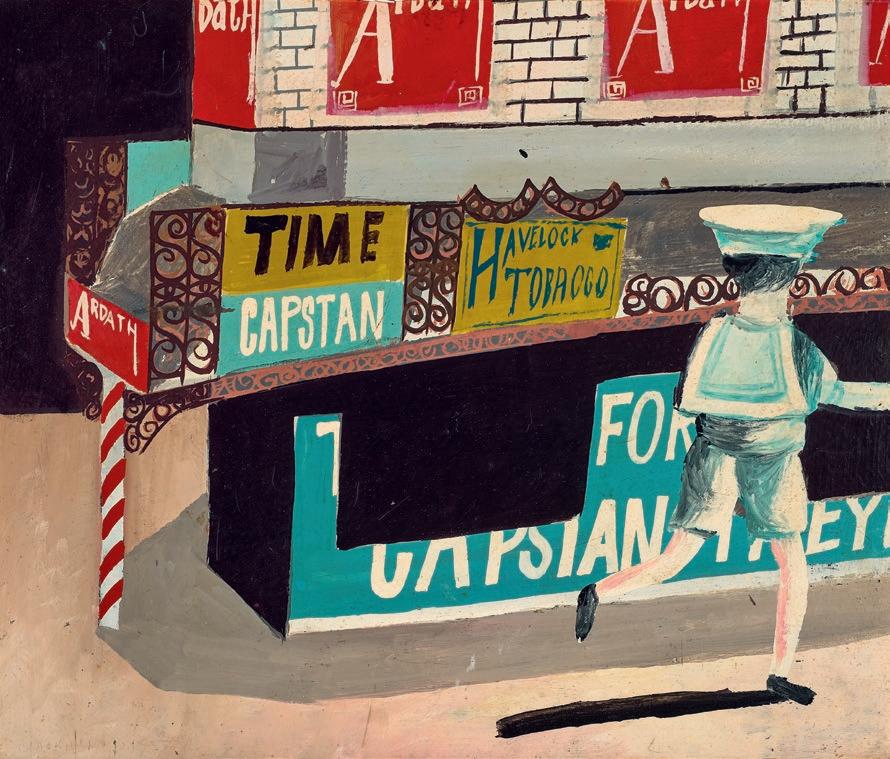
93
RUSSELL DRYSDALE (1912 – 1981)
THE DANCING CHILDREN, c .1971 oil on canvas
50.5 x 61.0 cm
signed lower right: Russell Drysdale inscribed verso: “THE DANCING CHILDREN” / RUSSELL DRYSDALE / c/o THE LEICESTER GALLERIES, / 22A. CORK STREET. / LONDON. W. I.
PROVENANCE
Leicester Galleries, London
Joseph Brown Gallery, Melbourne
Private collection, Melbourne
Thence by descent
Private collection, Melbourne
EXHIBITED
ESTIMATE: $350,000 – 450,000 15
Paintings, Drawings and Watercolours by Sir Russell Drysdale, Leicester Galleries, London, 16 June – 15 July 1972, cat. 27
RELATED WORK
Children Dancing, 1950, oil on canvas, 66.0 x 102.0 cm, private collection, sold Deutscher and Hackett, Melbourne, 3 May 2023, lot 12
94 IMPORTANT AUSTRALIAN + INTERNATIONAL FINE ART

95
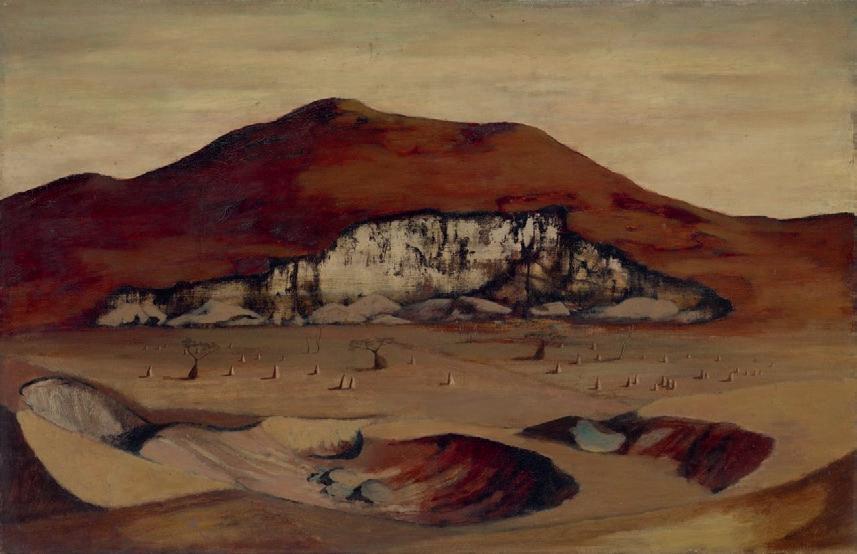
Within the ranks of the great Australian painters of the twentieth century, Russell Drysdale is distinguished by his ability to depict the Australian landscape and specifically, the psychologically charged relationship between the landscape and those who inhabit it. His colours are sun-bleached and pale, or the rich browns and reds of the earth, and the terrain he depicts is typically vast, flat and dry. Often described in the same tones and with a similar handling of paint, Drysdale’s figures rarely seem out of place, but the harshness of their environment and the profound sense of emptiness that pervades these landscapes communicates much about the strength, resilience and spirit of his subjects. As Drysdale explained, ‘[These] are the people that are fascinating. They’ve got this character. They are characters. You can take your society people, however beautiful they might be, but to me they’re ephemeral people. These others aren’t. They just go on. They’re the kind of towers that reach out. The survival thing that means something.’1
Drysdale’s first solo exhibition was held at Riddell Galleries, Melbourne in 1938 and received an overwhelmingly positive response, with Basil Burdett, the art critic for the Melbourne Herald, writing ‘I have seldom
seen a more promising exhibition by a young painter anywhere.’ 2 During the next decade Drysdale held several more solo exhibitions and further recognition of his art followed with the awarding of the 1947 Wynne Prize and the 1949 Melrose Prize. His work also began to be collected by important institutions during these years. Monday Morning, 1938 was acquired by the Metropolitan Museum of Modern Art, New York in 1941 and the following year, both the National Gallery of Victoria and the Art Gallery of New South Wales purchased their first paintings by the artist, Moody’s Pub, 1941 and Sunday Evening, 1941, respectively.
Drysdale was one of a small handful of twentieth century Australian artists who achieved international recognition during his lifetime. His art was introduced to English audiences in a solo exhibition of recent paintings at Leicester Galleries in London in 1950. Including Emus in a landscape , 1950 (National Gallery of Australia) and Broken Mountain, 1950 (National Gallery of Victoria), the paintings shown in London drew on various sources, reflecting his experience of drought in New South Wales some years earlier, visits to Hill End (a once thriving gold mining town now full of ‘jovial mad peasants who live by fossicking and rabbiting’ 3) and more recent excursions through rural Queensland.
96 IMPORTANT AUSTRALIAN + INTERNATIONAL FINE ART
Russell Drysdale Broken Mountain, 1950 oil on canvas, 66.2 × 102.0 cm
National Gallery of Victoria, Melbourne

Although London audiences were unfamiliar with the physical reality of Drysdale’s subject and sometimes challenged by the ruggedness of the landscape he described (so different to the picturesque English countryside which their artists depicted), his paintings struck a chord. Good sales – including one to Sir Laurence Olivier and another to the Tate Gallery – and positive reviews ensued.
Further solo exhibitions at Leicester Galleries followed in 1958, 1965 and 1972 and The Dancing Children, c.1971 was included in the last of these, hanging alongside drawings, watercolours and important paintings such as The Mourner, 1968, and Grandma’s Sunday Walk , 1972 (both private collection). Depicting a young boy and girl holding hands and dancing barefoot in a flat, rocky landscape, this painting reprised a theme that Drysdale had explored more than twenty years earlier. The 1949 canvas, Children Dancing (private collection), shows two girls in a similarly harsh environment, although in this version, Drysdale has elaborated on the setting, opening it up with low-lying hills just visible on the horizon and incorporating additional details such as tall, spindly trees and a distant windmill. While for a local audience at least, these details clearly locate the scene in the Australian outback,
they also demonstrate how the artist developed his paintings, carefully orchestrating the atmosphere and the feelings they evoke. The 1949 painting was evocatively described as ‘a rare, beautiful, and tragic canvas, in which two children dance against an empty landscape, not to music, but to the silence of their red and rainless outback world’4 , and this applies just as easily to the current work. What comes through most powerfully in Drysdale’s exploration of this theme, however, is the carefree delight and energy of the dancing children. Something observed by Drysdale perhaps and remembered, and a universal expression of the joy and freedom of childhood.
1. Drysdale interviewed by Geoffrey Dutton, cited in Dutton, G., Russell Drysdale, Thames & Hudson, London, 1964, p. 100
2. Burdett, B., ‘Young painter shows brilliant promise’, Herald, Melbourne, 26 April 1938, p. 10 cited in Smith, G., Russell Drysdale 1912-81, National Gallery of Victoria, Melbourne, 1997, p. 19
3. Donald Friend, diary entry, 22 August 1947, quoted in Klepac, L., Russell Drysdale, Murdoch Books, Millers Point, 2009, p. 161
4. McKie, R., ‘Drysdale takes Australia to London’, The Daily Telegraph, Sydney, 12 October 1950, p. 8
97
KIRSTY GRANT
Russell Drysdale Children Dancing , 1950 oil on canvas, 66.0 x 102.0 cm Private collection
SIDNEY NOLAN (1917 – 1992)
HARTZ RANGE, 1950
oil and enamel paint on composition board
78.0 x 121.5 cm signed and dated lower right: 11- 1- 50 / Nolan
ESTIMATE: $80,000 – 100,000
PROVENANCE
David Jones’ Art Gallery, Sydney Mr R.A.G. Henderson, Sydney Lawsons, Sydney, 16 July 1991, lot 310 Gould collection, Melbourne
EXHIBITED
Sidney Nolan: Exhibition of Central Australian Landscapes , David Jones’ Art Gallery, Sydney, 31 March – 14 April 1950, cat. 5 Australian Art, Gould Galleries, Hong Kong, 22 November – 1 December 1991, cat. 11
Sidney Nolan: Desert and Drought, National Gallery of Victoria, Melbourne, 6 June — 17 August 2003, cat. 23
LITERATURE
Smith, G., Sidney Nolan: Desert and Drought, National Gallery of Victoria, Melbourne, 2003, p. 45 (illus.)
Following his first experience of flying in 1947 Sidney Nolan wrote excitedly, ‘it seems to me one of the best possible means for seeing and understanding the landscape! Only one aspect it is true but what an aspect.’1 Two years later he visited Central Australia with his new wife Cynthia and her daughter Jinx, travelling extensively for two and a half months and viewing the desert landscape from the air. Three days after their arrival in Alice Springs, Nolan recorded in his diary:
‘Today went on a mail flight for four hundred miles over the Hartz Range & to the eastern extremity of the MacDonnell Ranges… In the morning the light on the hills was like gauze as Cynthia so accurately described it. Transparent & at the same time impenetrable.’2
Returning to the studio Nolan struggled to capture the essence of the ancient landscape but by the start of October, he had completed the first picture in the series that would in effect launch his international career.
An exhibition of forty-seven Central Australian landscapes opened at David Jones’ Gallery, Sydney at the end of March 1950. It was a commercial and popular success with nine paintings selling at the opening, including Dry Jungle , 1949 to the National Art Gallery of New South Wales, Sydney and Hartz Range , 1950 purchased by Rupert Henderson, Managing Director of John Fairfax Limited. By the end of the exhibition a total of seventeen paintings had been sold. 3 The National Gallery of Victoria, Melbourne purchased Central Australia, 1949 before the exhibition and in a remarkable vote of confidence, bought another painting from the series when it was shown in Melbourne later that year. By applying layers of oil paint and enamel and then burnishing them back, Nolan was able to capture the luminosity of the desert and there is a delicacy in these paintings that belies the monumental nature of their subject. In Hartz Range , the striated surface of the landscape appears like a vast skin pulled taut in the foreground that ripples and wrinkles as the mountains rise out of the ground and recede into the distance.
The success of these pictures continued when Inland Australia, 1950 won first prize in the inaugural Dunlop Australian Art Contest. The series also achieved significant international recognition with a painting being purchased by the Tate, London in 1951 and another by the esteemed British art historian, Sir Kenneth Clark.
James Gleeson recognised the significance of this celebrated series of paintings in a review that described the exhibition as ‘one of the most important events in the history of Australian painting… future art historians will date the birth of a predominantly Australian idiom from this exhibition… Nolan has been able to bring the vision of the poet and a respect for the objective facts of Nature into a single focus.’4
1. Sidney Nolan, letter to Albert Tucker, Brisbane, 16 July 1947, in Albert Tucker Papers, La Trobe Collection, State Library of Victoria, Melbourne, cited in Smith, G., Sidney Nolan: Desert and Drought, National Gallery of Victoria, Melbourne, 2003, p. 12
2. Sidney Nolan, diary notes, Alice Springs, 28 June 1949, Jinx Nolan Papers, cited in Smith, ibid., p. 16
3. See Smith, ibid., p. 25
4. Gleeson, J., ‘Landscapes triumph for Aust. Artist’, Sun, Sydney, 31 March 1950, p. 19
KIRSTY GRANT
98 IMPORTANT AUSTRALIAN + INTERNATIONAL FINE ART
16

99
JEFFREY SMART
(1921 – 2013)
SECOND SKETCH FOR MORNING, YARRAGON SIDING, 1983 synthetic polymer paint on Fabriano paper on card on composition board polyptych (four sheets) 20.0 x 40.0 cm (overall)
ESTIMATE: $40,000 – 60,000
PROVENANCE
Rex Irwin Art Dealer, Sydney (label attached verso) Private collection, Bangkok, acquired from the above in 1984
EXHIBITED
Jeffrey Smart, Recent Paintings, Rex Irwin Art Dealer, Sydney, 6 – 24 November 1984, cat. 12
LITERATURE
McDonald, J., Jeffrey Smart: Paintings of the ‘70’s and ‘80’s , Craftsman House, Sydney, 1990, cat. 261, p. 160
RELATED WORKS
Morning, Yarragon Siding, 1983 – 84, oil and synthetic polymer paint on canvas, 100.0 x 134.0 cm, formerly in the Holmes à Court collection, Perth
Third Study for Morning, Yarragon Siding, 1983, oil on canvas, 28.0 x 39.0 cm, Parliament House Art Collection, Canberra
We are grateful to Stephen Rogers, Archivist for the Estate of Jeffrey Smart, for his assistance with this catalogue entry.
We are grateful to Brenda Martin Thomas, wife of the late David Thomas AM, for kindly allowing us to reproduce David’s writing in this catalogue entry.
The Victorian country town of Yarragon nestles into the foothills of the Strezlecki Ranges. In Second Sketch for Morning, Yarragon Siding, 1983 Jeffrey Smart gives us a momentary glimpse of its rooftops and gently rolling hills bathed in sunlight, enveloped in an atmosphere so masterfully rendered that it seems tangible. Smart was visiting the area to make landscape studies for the Australian setting chosen for his monumental commission Container Train in Landscape , 1983 – 84 gifted to the Victorian Arts Centre, Melbourne by Marc and Eva Besen. While at Yarragon, the old railway shed on platform so captured Smart’s eye that he proceeded to explore the motif in two sketches on paper (including the present),as well as three oil studies and the larger final painting Morning, Yarragon Siding, 1983 – 84 (previously in the Holmes à Court collection, Perth).
While Smart’s final paintings are immaculate in composition and finish, as witnessed by the above-mentioned Morning, Yarragon Siding , his studies by contrast reveal an absorbingly immediate response to the motif. As such, they are often more personal by being so revealing. Indeed, the freer application of paint in Second Sketch for Morning, Yarragon Siding exudes an enthusiasm that Smart subsequently refined for the final work. Such initial enthusiasm allowed Smart the indulgence of an earlier fascination with texture, of timbers and other constructions, which contrasts starkly with the captivating plein-air quality of the landscape to the left. Painted in the tantalisingly traditional manner of Tom Roberts and the nineteenthcentury Australian Impressionists, Smart thus juxtaposes nature with the contemporary world’s hard-edged realism in the siding and its hints of flat surfaced, geometric abstraction. Smart invites us to compare the two as equally worthy of consideration.
Like his artistic mentor Cézanne, Smart’s priority has always been the pursuit of the consummate composition and certainly, nowhere is this commitment to disegno or draughtsmanship more eloquently illustrated than in the evolution of Morning , Yarragon Siding . As the present sketch demonstrates, the carefully considered final composition – the crystallisation of a specific ‘moment of enchantment’ – was preceded by numerous experiments with key components including most notably the colours of the drums; the symbols on the corrugated shed; and the depiction of the figure with the newspaper. Although retaining many elements featured here, in the final oil painting the landscape is dominated by the construction and a stronger light; the lines and corrugations of the railway shed are more pronounced; and the colour composition is more sophisticated, bearing a greater formality. Interestingly, Smart would also eventually omit the curious detail of the Italian helicopter seen here in the distance with the underslung load (similarly appearing in the first oil sketch), and would replace the motif of the ‘C’ with the number ‘2’, thus designating the particular railway siding and providing the artist’s ultimate seal of approval through his happy addiction to including (often enigmatic) words and numbers in his paintings. As in music, the study and the finished painting here might be likened to a prelude and a concerto; both are excellent in their individual ways.
DAVID THOMAS
100 IMPORTANT AUSTRALIAN + INTERNATIONAL FINE ART
17

101
JOHN OLSEN (1928 – 2023)
RIVER AND WATTLE, 1982
oil on canvas
152.0 x 167.5 cm
signed and dated lower right: John Olsen 82 inscribed with title verso: River & Wattle
ESTIMATE: $200,000 – 280,000
PROVENANCE
Gift of the artist to his sister, Mrs Harold Collins, Melbourne Sotheby’s, Melbourne, 29 November 2004, lot 16
Gould collection, Melbourne (label attached verso)
The Gould Collection of Important Australian Art, Deutscher and Hackett, Sydney, 15 March 2017, lot 20
Private collection, Sydney
EXHIBITED
John Olsen, Australian Galleries, Melbourne, 19 – 31 July 1982, cat. 5
Australian Landscape , Gould Galleries, Melbourne, 12 May – 2 June 2007, cat. 27 (illus. in exhibition catalogue)
The Director’s Choice 2010, Gould Galleries, Melbourne, 6 May – 5 June 2010, cat. 16 (illus. in exhibition catalogue)
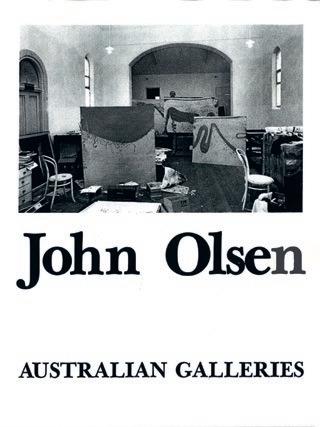
102 IMPORTANT AUSTRALIAN + INTERNATIONAL FINE ART
18
Front cover of exhibition catalogue
John Olsen, Australian Galleries, Melbourne, 19 – 31 July 1982

103
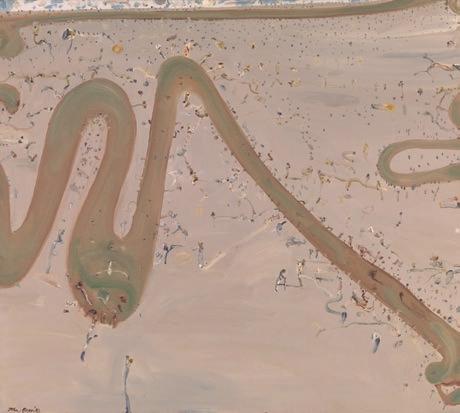
John Olsen
River passing through a plain, 1982 oil on canvas, 136.6 × 152.4 cm
National Gallery of Victoria, Melbourne
© John Olsen/Copyright Agency 2024
One of Australia’s most celebrated artists, John Olsen enjoyed a career that spanned more than seven decades and witnessed the production of a large oeuvre of paintings, drawings and works in other media that present a vivid and unique interpretation of the Australian landscape.
As a young man Olsen travelled to Europe spending much of his time in Spain absorbing the rich historical and contemporary influences of art, culture and landscape there, and distilling them into a pictorial language that was entirely original. Early on he also adopted Paul Klee’s notion of drawing as ‘taking a line for a walk’, and from that point on, the dancing calligraphic line has been a distinctive element of his work. Olsen extended this concept however, taking his line – whether drawn or painted – on a walk through the landscape and using it to record the experience of being in the natural environment rather than just looking at it.1
Talking about the You Beaut Country series of the mid-1960s – so wonderfully titled and so obviously Australian – Olsen explained: ‘... I also wanted to really come to terms with the experience of a total landscape. Not like there is the foreground, there is the middle distance and there is the horizon. I wanted that overall feeling of travelling over the landscape. There you can see the dry creek beds, the nervous system … which when you are just on the ground you don’t witness at all. Then you begin to somehow see the wholeness … It gives you a collective feeling of what’s happening … It’s more than the present, it’s the past and projects itself into the future.’ 2
Painted in 1982, River and Wattle is a landscape that reveals an artist at the height of his powers. While the ground of the painting is rendered in oil, the effect is delicate, the usual opacity of the medium repla ced
with subtle brushwork and tonal variations that enliven the surface. The river is viewed from above, a dark, solid but sinuous form meandering across the canvas and creating the illusion of vast space. This bird’s eye view is combined with the close-up study of plant, insect and bird life depicted in a riotous jumble of lines, dots and patterns. Vivid yellow dots describe the springtime wattle and amidst the conglomeration of abstract forms and gestural marks that make up this image, a bird in its nest in the top right-hand corner is a delightful detail.
In this brilliant merging of the monumental and the miniature, River and Wattle also reflects the experience of Olsen’s extensive journeys through remote parts of Australia during the 1970s – in particular his visit to Lake Eyre in 1974 – during which he was able to fully comprehend the complexity of the natural world, understanding it as both a physical structure as well as a diverse habitat 3 , and expanding his ability to describe this totality in visual terms.
1. See Hart, D., John Olsen, Craftsman House, Sydney, 2000, p. 38
2. Hurlston, D. and Edwards, D. (eds.), John Olsen – The You Beaut Country, National Gallery of Victoria, Melbourne, 2016, p. 10
3. Hart, op. cit., p. 123
KIRSTY GRANT
(right page)
John Olsen, 1979
photographer: Greg Weight
National Portrait Gallery, Canberra
© Greg Weight/Copyright Agency 2024
104 IMPORTANT AUSTRALIAN + INTERNATIONAL FINE ART

BRETT WHITELEY (1939 – 1992)
PRELIMINARY FOR ‘RIVER AT CARCOAR’, 1977 ink on paper
90.5 x 56.0 cm
signed lower right: brett whiteley dated and inscribed lower left:
Preliminary for ‘River at Carcoar’ 16/4/77 stamped lower right with artist’s monogram
ESTIMATE: $60,000 – 80,000
PROVENANCE
Private collection, Brisbane, acquired directly from the artist c.1977 Deutscher~Menzies, Melbourne, 8 September 2004, lot 6 Private collection, Melbourne and Sydney
LITERATURE
Sutherland, K., Brett Whiteley: Catalogue Raisonné , Schwartz Publishing, Melbourne, 2020, cat. 101.77, vol. 7, p. 405
RELATED WORK
River at Carcoar (Autumn), 1977, oil on plywood, 203.0 x 121.9 cm, private collection, illus. in Sutherland, K., op. cit., vol. 3, p. 467 Sketch of the River at Carcoar, c.1977, ink on paper, 96.0 x 50.0 cm, formerly in the Cbus Collection of Australian Art, illus. in Deutscher and Hackett, 100 Highlights from the Cbus Collection of Australian Art, Melbourne, 27 July 2022, lot 53
19
Across Brett Whiteley’s stellar career, the landscape served as both a conceptual and very real escape from the realities of daily existence, the expectations of the art world and ever-growing success, and the largely self-created pressures he came to experience in a life fuelled by creativity and addiction. From bases in London, and later, in New York and Australia, travel throughout Europe and Africa, and extended periods in Fiji and Bali, relaxed the artist’s body and mind and charged the imagination, providing material that would populate his oeuvre for years to come. While places like Sydney’s Lavender Bay – which became the subject of some of artist’s most well-known and highly celebrated works after the Whiteleys moved there in 1970 – are clearly recognisable, more often than not the landscape is an abstracted, generalised place; an amalgam of the artist’s diverse experiences in and connection to nature. For Whiteley, the natural world and the act
of making were deeply entwined: ‘Don’t just interpret nature, become its rival. Try and operatively work in the manner that rivals nature so that you do challenge God… There is sometimes that supernatural, superhuman sort of feeling when you’re creating that you are causing a world… From something that didn’t exist – here, this thing does exist.’1
Painted around the same time as he was awarded the prestigious Wynne Prize for landscape painting twice in two consecutive years 2 , Preliminary for ‘River at Carcoar’, 1977 offers a superb example of the pen and wash sketches, that Whiteley routinely completed – often en plein air – in preparation for many of his universally acclaimed pastoral paintings from this period, including Summer at Carcoar, 1977 (Newcastle Art Gallery); Paddock – Late Afternoon , 1979 (private collection), painted at nearby Oberon; and the magnificent The Wren , 1978 offered in this auction (lot 6) Like such masterpieces, the present similarly features the artist’s signature mesmerising, sinuous river meandering through the centre of the composition, flanked by burgeoning weeping willows and intermittent strewn granite boulders, with the sensuous, rounded curves of the mountains beyond. In his untiring efforts to depict this landscape in all its myriad seasons and moods, Whiteley recognised in such works a tendency which he described as ‘Chinese’, not only in his use of the calligraphic medium reminiscent of the Asian art he so admired, but more fundamentally perhaps, in the repetition of certain motifs to symbolise states of mind. The arabesques of rivers echoed the flight paths of birds, which in turn mirrored the artist’s relaxed journey through his own domain; as Sandra McGrath observed of the oil painting based upon the same composition, ‘The River at Carcoar borders on the surreal, having none of the convincing details to suggest that this is not a river of his own mental landscape.’3
1. Brett Whiteley, cited in Featherstone, D., Difficult pleasure: a film about Brett Whiteley, Film Finance Corporation Australia Limited, 1989
2. Whiteley won the Wynne Prize for Landscape painting three times: in 1977 with The Jacaranda Tree (On Sydney Harbour); in 1978 with Summer at Carcoar; and in 1984 with The South Coast After Rain
3. McGrath, S., Brett Whiteley, Bay Books, Sydney, 1979, p. 210
106 IMPORTANT AUSTRALIAN + INTERNATIONAL FINE ART

107
PROVENANCE
LIN ONUS (1948
– 1996)
YELLOW LILIES, 1993
synthetic polymer paint on canvas 182.0 x 182.0 cm
signed lower right: Lin Onus
ESTIMATE: $350,000 – 450,000
Gallery Gabrielle Pizzi, Melbourne (label attached verso)
Boston Consulting Group, Melbourne
Private collection, Sydney, acquired from the above in 2008
EXHIBITED
There and Back: an Exhibition of Recent Paintings and Sculpture by Lin Onus , Gallery Gabrielle Pizzi, Melbourne, 27 July – 4 September 1993
108 IMPORTANT AUSTRALIAN + INTERNATIONAL FINE ART
20
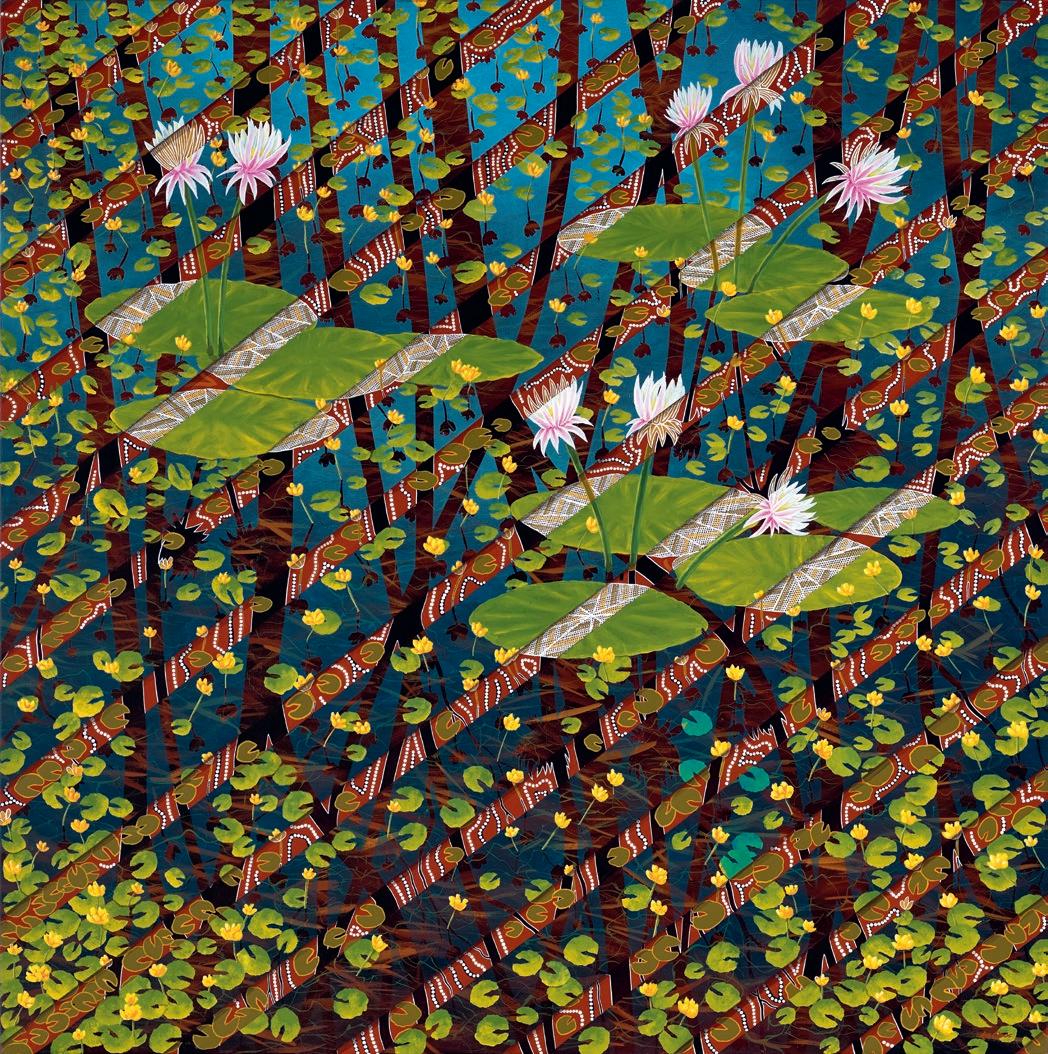
109
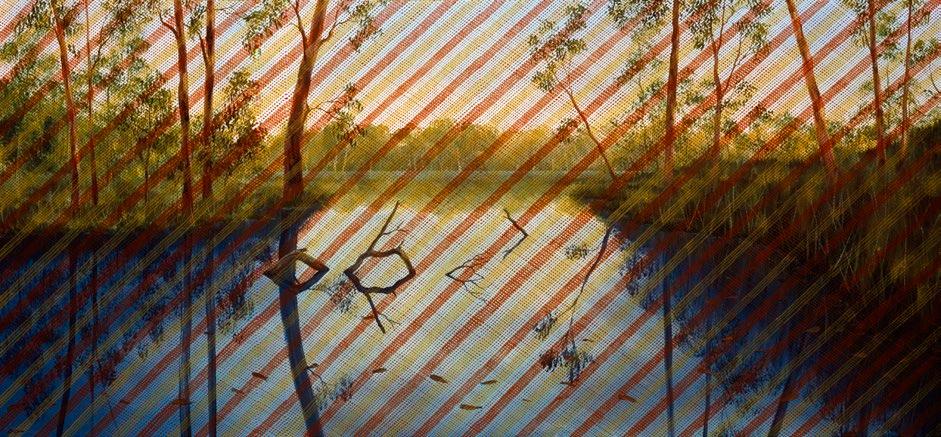
Lin Onus
Jimmy’s Billabong , 1988
synthetic polymer paint on linen, 114.0 x 235.0 cm
National Gallery of Australia, Canberra © Lin Onus/Copyright Agency 2024
With visually arresting rhythmic striations, Lin Onus’ expansive Yellow Lilies , 1993 simultaneously presents, two opposing landscape views of a site of great indigenous cultural significance, Gurruwiling, the Arafura Swamp wetlands of central Arnhem Land. Painted at dusk, the sublime surface of Onus’ billabong, dotted with hundreds of water lily plants is still, reflecting the striking black trunks of native gums, a glassy transparency revealing a bed of russet leaflitter. Spliced evenly across the entire painted surface, the integrity of his picturesque Western landscape is compromised – revealed through interstices is the same view painted in colours mimicking bark and natural earth pigments, borrowing the graphic flatness and ceremonial rarrk crosshatched motifs of local Yolngu bark painting. Joining a small and important group of double-image landscape paintings1 featuring overlays or perforations, Onus’ metaphorical dislocations, with almost Magrittean surrealism, disrupt and subvert assumptions on ideologies of representation and the implications of belonging and custodianship they project. Selfconsciously, they interrogate the process of representation itself and provide an unwavering reminder that this land is, and always has been, Aboriginal land. The incorporation of dual perspectives in his artworks through postmodern techniques of bricolage was Onus’ light-hearted and often humorous strategy to surmount prejudiced notions of what aboriginal art could and should look like. By 1993, Lin Onus was one
of Australia’s best known and well regarded contemporary aboriginal artists, awarded that year a Member of the Order of Australia (AM) in the Queen’s Birthday honours list. He remains acclaimed today for his dedication to fostering cultural understanding through his roles as artist, educator, activist, and administrator.
Onus grew up in the quiet Melbourne suburb of Deepdene within a deeply politically engaged household. He was the only child of William (Bill) Townsend Onus, a Yorta Yorta man and pioneering political activist, and Mary McLintock Kelly, a Scottish woman whom he had met at a Communist Party of Australia rally and married in 1947. Bill and his brother Eric, were instrumental in reforming the Australian Aborigines’ League advocating for indigenous civil and land rights and later driving the 1967 Referendum. 2 Throughout the 1950s and 60s, Bill Onus established and ran a successful commercial enterprise, commissioning and selling decorative replicas of traditional implements such as boomerangs and woomeras, as well as Aboriginal-themed souvenirs to busloads of visiting tourists, at his shop, Aboriginal Enterprise in Belgrave, Victoria. 3 It was through his early involvement with his father’s crafts and the influence of visiting artists, that the young Lin Onus taught himself painting, and recognised a need for cultural education and renewal amongst urban aboriginal youths.
110 IMPORTANT AUSTRALIAN + INTERNATIONAL FINE ART
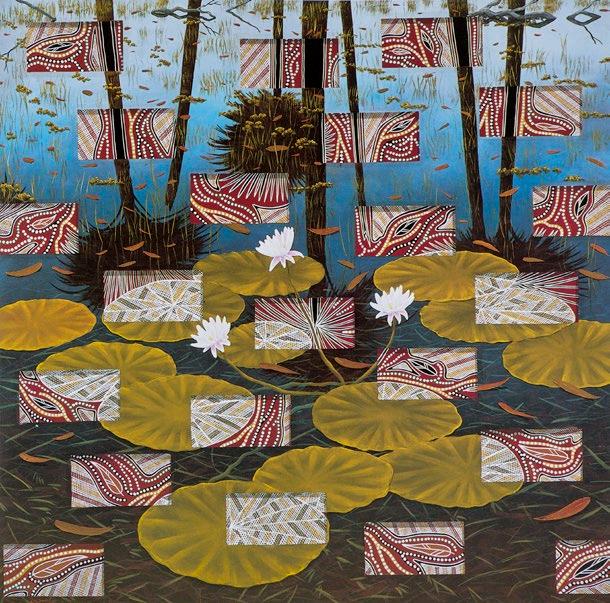
Throughout the 1970s and early 1980s, Lin Onus painted landscapes of his local environs around the Dandenongs, in a Western photorealist style, influenced by the works of older, indigenous artists who had been successful in using a European landscape tradition to depict their ancestral lands: Ronald Bull (1942 – 1979), Revel Cooper (c.1934 – 1983), and Albert Namatjira (1902 – 1959), all of whom had visited the Onus’ family in Melbourne. It was Onus’ later involvement with the Aboriginal Arts Board of the Australia Council, however, that provided a transformative visit to Maningrida, NT in 1986 – a ‘spiritual awakening’4 during which he met Senior Yolgnu artist, Djiwul (Jack) Wunuwun, whose ancestral lands run along the Northern edge of the Arafura Swamp. Over the course of dozens of subsequent pilgrimages to visit Wunuwun, Onus was welcomed into the Murrungun-Djnang clan, initiated into cultural knowledge systems and given permission to use sacred rarrk designs and storylines. Wunuwun’s philosophy of ‘seeing below the surface’ and using artistic hybridity to achieve reconciliation were also shared and adopted by Onus, explored in depth in his late water-and-reflection paintings. 5
Yellow Lilies , with its striking dense patterning, oscillates between two interwoven modes of viewing and systems of understanding the world, metaphorically portraying indigenous displacement and erasure. Like
Lin Onus
Arafura Swamp , 1990 synthetic polymer paint on linen, 182.0 x 182.0 cm
Baillieu Myer Collection, 1980s
© Lin Onus/Copyright Agency 2024
the jigsaw motif of Arafura Swamp, 1990, the revelation of an underlying bark design gives primacy to its ancient origins.6 Running perpendicular to the striations, Onus’ black tree trunks unify the two images, indicating that in the impossibility of returning to land of pre-colonisation, the coexistence of multiple and equivalent frames of reference is a sustainable path to progress.
1. These include Jimmy’s Billabong, 1988, overlaid with rrark, National Gallery of Australia; Arafura Swamp, 1990, with square cut-outs revealing an underlying bark painting, Baillieu Myer Collection; and Barmah Forest, 1994, with mismatched jigsaw piece cut-outs, Australian Heritage Commission, Canberra.
2. ‘William ‘Bill’ Onus’, First Peoples – State Relations, Victoria, 30 September 2019; see https:// www.firstpeoplesrelations.vic.gov.au/william-bill-onus (accessed March 2024)
3. Kleinert, S., ‘Aboriginal Enterprises: Negotiating an urban Aboriginality’, Aboriginal History, Australian National University, Canberra, vol. 34, 2010, p. 2
4. Lin Onus, cited in Leslie, D., ‘Earth, spirit and belonging in Australian art’, Spirit in the Land, McClelland Gallery + Sculpture Park, Langwarrin, 2010 – 2011, p. 19
5. Davis, P., ‘In Touch with an artist’s Aboriginality’, Canberra Times, 7 July 1990, p. 21 and Mundine, D., ‘Jack Wunuwun’, Museum of Contemporary Art Australia Handbook, see https:// www.mca.com.au/collection/artists/jack-wunuwun/ (accessed March 2024)
6. Neale, M., Urban Dingo - the Art and Life of Lin Onus 1948 – 1996, Queensland Art Gallery, Brisbane, 2000, p. 16
LUCIE REEVES-SMITH
111
PROVENANCE
JANE SUTHERLAND (1853
– 1928)
THE MUSHROOM GATHERERS, c .1895 – 1910 pastel and gouache on paper 35.5 x 76.5 cm
signed lower right: J. Sutherland
ESTIMATE: $30,000 – 40,000
Private collection, United Kingdom, by 1970s
Private collection, Scotland
Private collection, United Kingdom
LITERATURE
Lindsay, F. & Rosewarne, S., Sutherland (exhibition catalogue), Victorian College of the Arts, Melbourne, 1977, p. 11
Burke, J., Australian Women Artists 1840 - 1940, Greenhouse Publications, Melbourne, 1980, p. 182
RELATED WORK
The mushroom gatherers, c.1895, oil on canvas, 41.8 x 99.3 cm, in the collection of the National Gallery of Victoria, Melbourne
Although their names remain comparatively little known, there were women artists among the ranks of Australia’s leading Impressionists, and Jane Sutherland is one such figure. Born in Glasgow in 1855, she emigrated to Australia with her family and settled in Melbourne in 1870, enrolling at the National Gallery School the following year. Her father, George, was an artist and he enrolled at the same time, either to refine his drawing skills or to chaperone his daughter.1 Frederick McCubbin was a fellow student and became a lifelong friend. With McCubbin, Tom Roberts, Walter Withers and E. Phillips Fox, among others, Sutherland took part in the first outdoor painting excursions to Box Hill during the mid-1880s, although propriety demanded that she didn’t camp with the men overnight.

Jane Sutherland
The mushroom gatherers , c.1895 oil on canvas, 41.8 x 99.3 cm
National Gallery of Victoria, Melbourne
Her artistic skill was recognised early on with the award (received jointly with McCubbin) in 1874 of the Gallery School’s prize for drawing the ‘best figure in the round’ and her commitment to the life of a professional artist (she did not marry), as well as the camaraderie and respect she enjoyed among her male peers, is reflected in the range of her activities. In addition to exhibiting with the Victorian Academy of Arts from 1878, she regularly contributed to the annual Victorian Artists’ Society (VAS) exhibitions between 1888 and 1911. She was a member of the Buonarotti Society (the only female member to chair these gatherings), and in early 1900, she became the first woman to be elected to the Council of the VAS. 2 By 1888, she had established a studio in Grosvenor Chambers on Collins Street (alongside Roberts, Louis Abrahams and Jane Price, among others), which she shared with Clara Southern. In 1889, she was described as ‘one of the busiest lady artists in Melbourne as, in addition to her painting, she has several pupils, whom she receives individually or in classes, giving close attention to drawing, as the absolutely necessary groundwork.’3
This work in gouache and pastel is closely related to one of Sutherland’s most well-known paintings, The mushroom gatherers , c.1895 in the collection of the National Gallery of Victoria. Exhibited at the VAS in 1895, the oil painting drew praise from the Table Talk critic who wrote, ‘Miss Jane Sutherland… has secured a very attractive and poetic effect in Mushroom Gatherers. The cold greyness characteristic of early dawn is perfectly represented, and the figures are posed in a natural and lifelike manner… There is also very much in the picture that tells of studious and earnest observation of natural effects seen in the Australian landscape.’4 The composition is almost identical, with the exception of a tree stump which is omitted in this version, and Sutherland’s ability to capture the atmosphere and delicate colours of the landscape in soft morning light is clear. This work also reflects her interest in the theme of figures (often children from the artist’s extended family) in the landscape, which is seen in other paintings including Field Naturalists , c.1896 (National Gallery of Victoria) and Far-a-field , 1896 (private collection). Sutherland rarely dated her work and while she is known to have worked in pastel after suffering a stroke in 1900, and sometimes repeated subjects of earlier works, they are typically modest in scale. The large format of this work, which is only slightly smaller than the oil painting, makes it tempting to suggest the possibility of an earlier date.
1. See Lindsay, F., ‘Jane Sutherland: Thoroughly Australian Landscapes’ in Lane, T., Australian Impressionism, National Gallery of Victoria, Melbourne, 2007, p. 225
2. ibid., p. 226
3. ‘Miss Jane Sutherland’, Table Talk, Melbourne, 2 August 1889, p. 7
4. ‘Victorian Artists’ Exhibition’, Table Talk, Melbourne, 17 May 1895, p. 11
KIRST GRANT
112 IMPORTANT AUSTRALIAN + INTERNATIONAL FINE ART
21
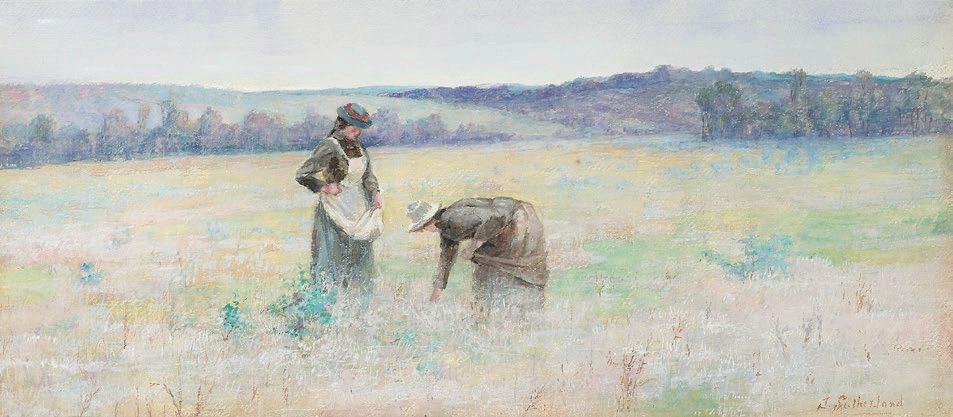
113
JANE SUTHERLAND
(1853 – 1928)
PORTRAIT OF THE ARTIST’S COUSIN, c .1895
oil on canvas
56.0 x 43.5 cm
signed lower right: J. Sutherland
ESTIMATE: $30,000 – 40,000
PROVENANCE
Brenda Sutherland, Melbourne
Christie’s, Sydney, 6 October 1976, lot 189 (as ‘Portrait of Brenda Sutherland, Cousin of the Artist’)
Private collection
Leonard Joel, Melbourne, 11 May 1977, lot 240A (as ‘Portrait of Brenda Sutherland, Cousin of the Artist’)
Private collection, Melbourne
Deutscher Fine Art, Melbourne
Private collection, Melbourne, acquired from the above in 1993
EXHIBITED
Sutherland, The Victorian College of the Arts Gallery, Melbourne, 8 – 30 September 1977, cat. 12 (as ‘Portrait’)
A selection of Nineteenth and Twentieth Century Australian Art, Deutscher Fine Art, Melbourne, 24 May – 9 June 1989, cat. 18 (as '(The artist's cousin)')
A Century of Australian Women Artists 1840s – 1940s , Deutscher Fine Art, Melbourne, 4 June – 3 July 1993, cat. 30
LITERATURE
Hammond, V., A Century of Australian Women Artists 1840s – 1940s , Deutscher Fine Art, Melbourne, 1993, cat. 30, p. 53 (illus., as '(The artist's cousin)')
This striking portrait of a young cousin is a compelling example of the art of Jane Sutherland, one of the leading women artists working in Melbourne in the later nineteenth century. Together with friends and colleagues including Clara Southern, Jane Price and May Vale, Sutherland was a vocal and visible advocate for the participation of women in creative fields in the years leading up to (white) women’s national suffrage, granted in 1902.
Sutherland had arrived in Melbourne as a teenager with her parents, numerous siblings and soon, an extended family of aunts, uncles and cousins. The family were liberal, musical and artistic, and the siblings received their earliest art lessons and encouragement from their father George. In 1871, Sutherland commenced formal artistic training at the recently formed National Gallery School the following year. Over a fourteen-year period, her teachers included Thomas Clark, Eugene von Guérard, George Folingsby and Frederick McCubbin. Commended as a
student, Sutherland exhibited regularly with local artist groups from the later 1870s. In 1888 she and her friend Clara Southern were among the first to established a studio in the Grosvenor Chambers on Collins Street: by the following year, it was reported that ‘Miss Sutherland is one of the busiest lady artists in Melbourne, as, in addition to her painting, she has several pupils, whom she receives individually or in classes, giving close attention to drawing, as the absolutely necessary groundwork.’1
Sutherland was an active and accomplished participant in Melbourne’s artistic circles: the Grosvenor Chambers had swiftly become a hub for eager artists, with fellow tenants including Roberts, Price Charles Conder and Louis Abrahams. The Sutherland family’s interest in bushwalking corresponded with the younger generation of artists’ increasing interest in plein air painting; from the mid-1880s, Sutherland joined with fellow artists Tom Roberts, Frederick McCubbin, Walter Withers and others on sketching trips around Melbourne. Being female, however, protocols limited the camping that she was able to undertake.
It is not surprising that women and children form the majority of subjects depicted in Sutherland and her female contemporaries’ landscapes, as in Sutherland’s The mushroom gatherers, c.1895 and Field naturalists , c.1896 (both in the collection of the National Gallery of Victoria). Sutherland’s extended family provide a rich source of material for her watercolours, oil paintings and increasingly, after she suffered a debilitating stroke in 1900, her pastels. This portrait is believed to depict her cousin Brenda, who graduated with a Bachelor of Science from the University of Melbourne, and was awarded a coveted travel scholarship to further her study in Canada and the United States. 2 Returning to Melbourne she converted her father’s boys’ school Carlton College into a College of Domestic Economy, a field that Brenda advocated over many years as a profession and career for women. 3 It has also been suggested that this young woman, with her red tresses reflecting their Scottish ancestry, may depict Brenda’s elder sister Sheila, who opened the Melbourne Book Club in Collins Street in 1918: a painting titled Sheila was exhibited in the Victorian Artists’ Society winter exhibition in 1890.4
1. ‘Miss Jane Sutherland’ Table Talk, 2 Aug. 1889, p. 7
2. ‘ Scientist wins distinction’, The Herald, 11 July, 1916, p. 5
3. ‘Domestic arts neglected’, The Herald, 28 May 1918, p. 4
4. Victoria Hammond, A Century of Australian Women Artists 1840s–1940s, Deutscher Fine Art, Melbourne 1993, p. 53
ALISA BUNBURY
114 IMPORTANT AUSTRALIAN + INTERNATIONAL FINE ART
22

115
FREDERICK M c CUBBIN
(1855 – 1917)
STUDY FOR WILLIAMSTOWN LANDSCAPE, 1909
oil on canvas board
25.5 x 35.5 cm
signed lower right: F M McCubbin
ESTIMATE: $50,000 – 70,000
PROVENANCE
Esther Paterson, Melbourne, 1962
Christie’s, Melbourne, 26 November 1996, lot 106
Private collection, Melbourne
Deutscher~Menzies, Melbourne, 20 April 1998, lot 35
Private collection, Melbourne
Deutscher~Menzies, Melbourne, 13 September 2006, lot 40
Private collection, Adelaide
EXHIBITED
Archives Exhibition, Victorian Artists’ Society, Melbourne, November 1962, cat. 22
The Artists’ Journey: Discovering the Victorian Coastline
1840 – 1910, Mornington Peninsula Regional Gallery, Victoria, 14 December 2003 – 22 February 2004 (label attached verso)
LITERATURE
MacDonald, J., The Art of Frederick McCubbin, The Lothian Book Publishing Co. Pty Ltd., Melbourne, 1916, p. 78
Thomas, D. E. L., ‘Frederick McCubbin’s Winter Sunlight’, Bulletin of the Art Gallery of South Australia, Adelaide, 1978, vol. 36, pp. 39 – 40
RELATED WORK
Williamstown Landscape , 1909, oil on canvas, 61.0 x 91.5 cm, formerly in the collection of the National Australia Bank, sold Deutscher and Hackett, Melbourne, 22 February 2022, lot 17
We are grateful to Brenda Martin Thomas, wife of the late David Thomas AM, for kindly allowing us to reproduce David’s writing in this catalogue entry.
Ships and docks run throughout Frederick McCubbin’s art, one of his earliest oil paintings being View of the New Dock , 1880. This is not surprising for McCubbin grew up in King Street, not far from the
Melbourne docks, and the docklands were part of his teenage bread round when working for his father. Moreover, ships from faraway places would have exercised a strong appeal for a young man of McCubbin’s romantic inclination. Two years later, he painted Falls Bridge, Melbourne, 1882 (National Gallery of Victoria), the numerous masts of tall ships spread enticingly across the background. This was followed by such major paintings as The City’s Toil, 1887 (also known as Smith’s Wharf, Yarra Yarra) now in Wesfarmers collection, and Melbourne , 1888 (National Gallery of Victoria), showing the city from the busy docks. Even during his trip to England in 1907 his attention was drawn to shipping and harbours, at Naples, Genoa, and especially on the Thames. His single, most important painting from this trip was The Pool of London, 1907, which was accompanied by a number of smaller studies and related scenes – Thames Barges ; Hammersmith Bridge ; and Barges, Pool of London – all of the same dimensions as the painting on offer. In England, he also enjoyed seeing at first hand the paintings of his lifelong hero, J.M.W. Turner, whose increased influence on his work after his return is engagingly apparent in this and other paintings.
The shipping slips and sheds of Williamstown on Port Phillip Bay attracted many artists, especially McCubbin after his return to Australia. In January 1909, he wrote to his old friend Tom Roberts in London: ‘I have been down at Williamstown for a few pochards [rough sketches] my dear boy, just like Venice, lovely colour. Water, sky and an old ship… the older I get, the wider my interest grows in all life, colour and charm.’1 Study for ‘Williamstown Landscape’, 1909 is one of at least three known and very similar studies for the larger painting, Williamstown Landscape, 1909 formerly in the collection of the Art Gallery of South Australia. Our painting appears to be the first of these studies, painted en plein air directly from the motif, the application of the paint with deft strokes of the palette knife capturing the scene with a sparkling freshness. Another important Williamstown subject, The Old Ship, Williamstown, 1915 was painted from a position on the other side of the buildings shown in this appealing study.
116 IMPORTANT AUSTRALIAN + INTERNATIONAL FINE ART
23
1. Letters to Tom Roberts, vol. II, no. 18, Mitchell Library, State Library of New South Wales, Sydney.
DAVID THOMAS
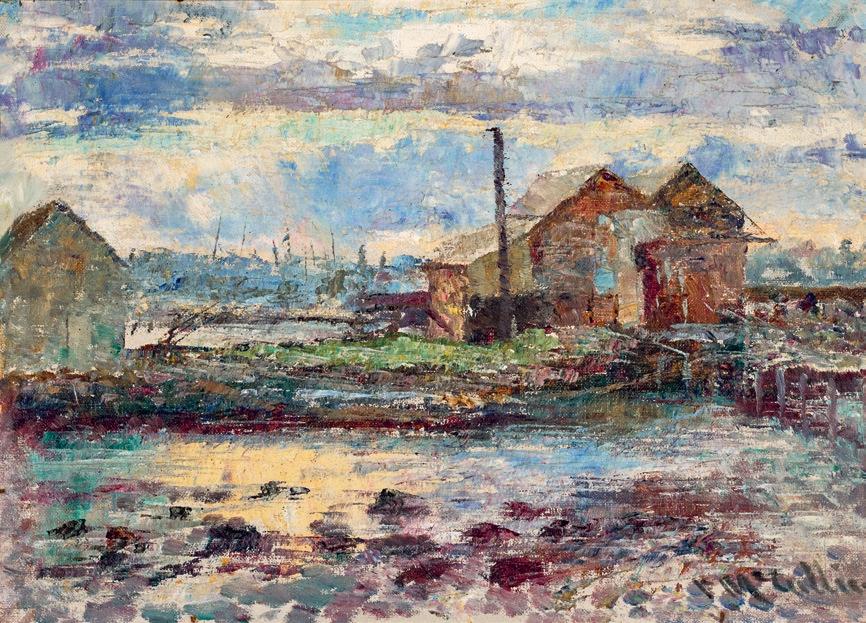
117
HENRI MARTIN
(French, 1860 – 1943)
L’ÉGLISE
DE LABASTIDE–DU–VERT,
c .1920 s oil on canvas
117.0 x 95.0 cm
signed lower left: Henri Martin
ESTIMATE: $100,000 – 150,000
PROVENANCE
Private collection
Sotheby’s, London
Private collection, Sydney, acquired from the above in the late 1990s
Thence by descent
Private collection, Melbourne
EXHIBITED
possibly : Galerie Georges Petit, Paris, c.1920 – 1926 possibly : Exhibition of French Contemporary Painting, Leicester Galleries, London, July – August 1927
Toulousian painter Henri-Jean Guillaume Martin’s early accolades at the École des Beaux-Arts de Toulouse facilitated a seamless entrance into artistic circles in Paris. There, the young Henri worked in the atelier of academic history painter Jean-Paul Laurens from the age of 19 and began exhibiting at the Salon des Artistes Français the following year. During this time, Martin produced grand Symbolist paintings, such as La Lutte des Titans contre Jupiter, 1884 – 85 (Museu Nacional de Belas Artes, Rio de Janeiro) whose positive reception at the Salon won the artist a formative travelling scholarship to Italy. Martin’s discovery of works by the masters of Italian Renaissance, in particular the frescoes of Giotto and Masaccio, radically changed his approach to painting. ‘After having seen Italy, I painted with love’,1 Martin wrote, his paintings now infused with brilliant light and displaying compositions of poetic lyricism. Crucially, at this point Martin also began to look beyond the classical techniques of his academic training – experimenting instead with the radical neo-impressionist technique of pointillism developed by Georges Seurat in 1884.
This peaceful village scene of L’Église de Labastide-du-Vert was painted during the 1920s in the free pointilliste style that brought Martin huge commercial success. Martin’s mosaic of unmixed parallel brushstrokes and the chromatic effects of their relative spacing creates a shimmering
springtime view of the small village in the south of France where Martin lived until death in 1943. By the age of 40, the artist had tired of Parisian life, and searched for a residence in the ‘midi toulousain’, where he could spend half the year in the warm and sun-drenched countryside of his childhood. In 1900, Martin purchased a grand 17th century château of 28 hectares, Marquayrol (meaning ‘maison du rocher’ in local Occitan dialect), in the preserved medieval village of Labastide du Vert, in the Lot. The tranquil rhythms of this rural village, ordered by seasonal agricultural work, provided Martin with a limitless natural source of inspiration for his best works.
Perched high on a hill, Marquayrol ’s terraced gardens offered the artist an incomparable sweeping view over the Vert valley, dotted with swaying poplars and ringed by purple peaks. The slow-moving tributary of the Lot River, the Vert, wends its way through the valley, snaking in a distinctive bend to the north of the town before passing under a double-arched drystone bridge a few meters from Labastide-du-Vert’s stone church, the Saint-Carissime. These three local landmarks: the sparkling iridescent stream, the bridge of local limestone where villagers would stop to chat, and the striking profile of the church’s campanile with its two successive rosettes, would become favourite subjects for Martin. Like Rouen Cathedral for Monet, Martin never tired of painting Saint-Carissime, capturing impressions of the building at different times of day and atmospheric conditions. This view of crisp springtime renewal was painted from the riverbank with a row of spindly poplars twinkling with spring buds and a trio of ducks in the foreground expertly described with a handful of brushstrokes of contrasting Prussian blue and pink. Martin has painted this scene in a spontaneous and assured manner, with small interstices of canvas left bare between brushstrokes. Confidently orchestrating the harmonies of bright meridional colours, Martin’s deft touches coalesce into this shimmering sublime bucolic scene.
Valmy-Baysse
118 IMPORTANT AUSTRALIAN + INTERNATIONAL FINE ART
24
1.
J., ‘Henri Martin’, Peinture d’Aujourd’hui, Paris, no. 5, 1910, cited in Juskiewensky, C., Henri Martin. Paysagiste et décorateur Languedocien, Thesis, Université de Toulouse, 1975
LUCIE REEVES-SMITH

119
AUGUSTE RODIN
(French, 1840 – 1917) TÊTE DE GÉNIE FUNÉRAIRE
(HEAD OF A FUNERARY SPIRIT), c .1898 – 99 also known as TÊTE DE GÉNIE DU REPOS ÉTERNEL/TÊTE NO. 33
cast c.1920s bronze
15.0 cm height signed at base: A. Rodin bears foundry stamp at base: Alexis RUDIER. / Fondeur. PARIS.
ESTIMATE: $30,000 – 40,000
PROVENANCE
Curt Valentin Gallery, New York
Joseph H. Hirshhorn, New York, acquired from the above in 1955 Hirshhorn Museum and Sculpture Garden, Washington D.C., a bequest from the above in 1966
Christie’s, New York, 18 February 1988, lot 1 Holland Fine Art, Sydney, acquired from the above Private collection, Sydney, acquired from the above in 1989
EXHIBITED
Rodin, Curt Valentin Gallery, New York, 4 – 29 May 1954, cat. 7 (illus. in exhibition catalogue, as ‘spirit of Melancholy’)
Sculpture in Our Time. Collected by Joseph H. Hirshhorn, The Detroit Institute of Arts, Michigan, 5 May – 23 August 1959, cat. 38 (as ‘Spirit of Melancholy, 1898’)
Modern Sculpture from the Joseph H. Hirshhorn Collection, Solomon R. Guggenheim Museum, New York, 3 October 1962
– 6 January 1963, cat. 395 (as ‘Spirit of Melancholy, 1898’) Artist and Maecenas: A Tribute to Curt Valentin, Marlborough–Gerson Gallery, New York, November –December 1963, cat. 7 (illus. in exhibition catalogue)
LITERATURE
Grappe, G., Catalogue du Musée Rodin, Paris, 1927, cat. 240, pp. 87 – 88 (illus., another cast)
Grappe, G., Catalogue du Musée Rodin, Paris, 1929, cat. 274, pp. 105 – 106, (illus., another cast)
Watkins, G. F., Rodin Museum of Philadelphia, Pennsylvania, 1929, cat. 73, p. 20 (as ‘Head of a Funeral Spirit’) Grappe, G., Catalogue du Musée Rodin, Paris, 1931, cat. 323, p. 127, (illus., another cast)
Grappe, G., Catalogue du Musée Rodin, Paris, 1938, cat. 259, p. 100 (illus., another cast)
Grappe, G., Catalogue du Musée Rodin, Paris, 1944, cat. 292 bis, p. 100 (illus., another cast)
Tancock, J. L., Rodin Museum: Handbook , Philadelphia Museum of Art, Pennsylvania, 1969, cat. 109
Tancock, J. L., The Sculpture of Auguste Rodin: The Collection of the Rodin Museum, David R. Godine in association with Philadelphia Museum of Art, Pennsylvania, 1976, cat. 118, pp. 613–614, 615 (illus., another cast, 1899)
Le Normand–Romain, A., The Bronzes of Rodin, Catalogue of Works in the Musée Rodin, Musée Rodin / Editions de la Réunion des musées nationaux, Paris, 2007, vol. I, pp. 394 – 398 (as ‘Funerary Spirit, Head, 1898’), vol. II, cat. S. 652, p. 395 (illus., another cast, c.1898)
120 IMPORTANT AUSTRALIAN + INTERNATIONAL FINE ART
25

121
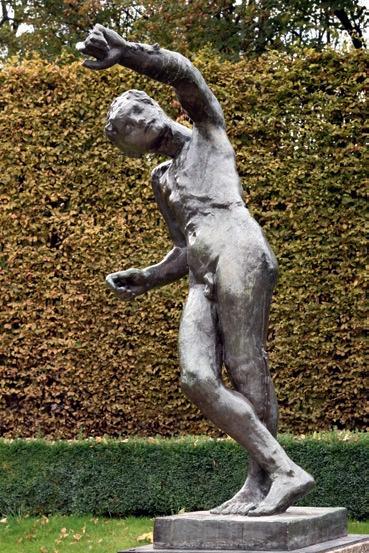
Auguste Rodin was the most influential sculptor of the 19th century, and by 1900, the date of his first solo exhibition, had reached the pinnacle of his career. Although his modern expressive style was far removed from the classical traditions of statuary, from 1880 – 1900 Rodin’s sculptural expertise was highly sought-after by the French state and by professional associations.1 The works resulting from these frequent commissions for public monuments became many of Rodin’s most famous works: The Gates of Hell (1880 – c.1890); The Burghers of Calais (1884 – 1889); Monument to Victor Hugo (1889 – 1897); and the Monument to Balzac (1892 – 97). This solemn and intimate sculpture of a young man’s head, Tête de Génie Funéraire, cast in bronze, relates to two plaster figures of the Génie du Repos Éternel (The Spirit of Eternal Repose).2 This allegorical portrait was included in Rodin’s commissioned maquette for a state monument for the recently departed French painter, Pierre Puvis de Chavannes (1824 – 1898). The Maître Puvis, like Rodin, was a major artistic figure of the Third Republic, a close friend and admired artistic peer. Although commissioned on 24 March 1899 and the maquette completed around 1905 3 , the monument itself was never realised, and an alternative version was instead constructed by Jules Desbois and inaugurated in 1924.
Instead of a portrait bust, this is the head of a male allegorical figure, an idealised Greek youth embodying the ‘funerary spirit.’ A personification of mournfulness, an expression of the transience of life and conferring glory on the deceased, this Dionysian figure was common in the sculpture of antiquity, with a popular resurgence during the Florentine Renaissance. With aquiline features and a rough halo of hair, the spirit has its eyes closed in a poignant and respectful expression of reflection. The bronze cast has retained the expressive quality of Rodin’s informal modelling of plaster, conveying with immediacy the emotive power of his figure.
The complete plaster maquette of the Puvis de Chavannes Monument (Musée Rodin, Paris) displays the full extent of the sculptor’s radical installation, and reveals the Hellenic influences the sculptor included to honour his friend’s classicism. Hastily constructed from pre-existing sculptures, Rodin’s humble monument featured a bust of Puvis he had made in 1891 atop a column of two superimposed architectural capitals (one doric and one Corinthian), placed on a table. Next to this static arrangement is an allegorical scene with the life-sized génie, in crosslegged contrapposto, leaning over to pick an apple from a sprawling
122 IMPORTANT AUSTRALIAN + INTERNATIONAL FINE ART
Auguste Rodin
Génie du Repos Éternel, 1899–1902 bronze, 193.5 cm height
photographer: Peter Horree Musée Rodin

sapling cast from life. Rodin described this work in a letter in 1909: ‘composed like a painting by Puvis, with voids and holes – it must let green shine though in the interstices.’4 The Spirit of Eternal Repose was based on a Roman statue in the Louvre Museum, Hypnos or Génie du Repos Éternel . Tellingly, the English artist Gwen John, Rodin’s paramour during this same period, also drew the sculpture from the Louvre’s collections – her drawing is now held in the Amgueddfa Cymru/ Museum Wales.
While the ‘intimate, gentle, and pure’ 5 monument was never fully realised in marble as intended, several of its individual elements and studies were individually cast during Rodin’s lifetime and afterwards by his estate, using the same founders and ateliers that he had approved of to carry out his artistic vision to the highest integrity. Rodin considered the Puvis monument one of his finest realisations, reportedly commenting on it in his last breath.6 This early bronze cast of the Génie Funér aire was purchased by the great American mining magnate, collector and philanthropist, Joseph H. Hirshhorn. Having amassed an extraordinary collection of 19th and 20th century art in the post-war years, Hirshhorn made a vast donation of works to American
government in 1966, resulting in the establishment of the Hirshhorn Museum and Sculpture Garden in Washington D.C., however crucially accompanied by a liberal deaccession policy. Between May 1986 – December 1988, the museum sold at auction 365 works over 46 auctions held by Christie’s and Sotheby’s7, rationalising the collection to allow for contemporary acquisitions. This Tête de Génie Funéraire was purchased directly from one of these divestment auctions, in December 1988, thus retaining its impeccable provenance.
1. Eisen, A., Rodin, Secker & Warburg, London, 1974, p. 67
2. The Spirit of Eternal Repose, c.1898 (195.5 cm height), the full-length plaster figure with head and no arms was exhibited at the Rodin exhibition in Brussels in 1900, as was a reduced version of the figure, from which it is suggested that the Head of a Funerary Spirit was cast in bronze. See Tancock, J. L., The Sculpture of Auguste Rodin, Philadelphia Museum of Art, 1976, cat. 118, pp. 613 – 615
3. Mauclair, C., Rodin: The Man – His Ideas – His Works, Duckworth & Co., London, 1905, p. 89
4. Letter to H. Durand-Tahier, 24 June 1909, cited in ‘Monument a Pierre Puvis de Chavannes’, A Nos Grands Hommes, Musée d’Orsay, see https://anosgrandshommes.museeorsay.fr/ index.php/Detail/objects/5459 (accessed March 2024)
5. Mauclair, ibid., p. 90
6. Vilain, J. et al., Rodin: At the Musée Rodin, Editions Scala, Paris, 1999, p. 68
7. Tully, J., ‘Hishhorn Sells 23 Works for $500,000’, Washington Post, 1 December 1988
123
LUCIE REEVES-SMITH
View of Rodin’s studio 1904–05
Photographer: Jacques-Ernest Bulloz, Musée Rodin, Paris
BERNARD BUFFET
(French, 1928 – 1999)
HURRAH!! PORTOVENERE!, 1977
oil on canvas
130.5 x 162.5 cm
signed lower left: Bernard Buffet dated lower centre: 1977. inscribed with title verso: Hurrah!! / Portovenere!
ESTIMATE: $150,000 – 250,000
PROVENANCE
Galerie Maurice Garnier, Paris (bears gallery stamp verso)
Private collection, Japan, acquired from the above in January 1989
Thence by descent
Private collection, Queensland
We are grateful to Galerie Maurice Garnier, Paris, for their assistance with this catalogue entry.
124 IMPORTANT AUSTRALIAN + INTERNATIONAL FINE ART
26
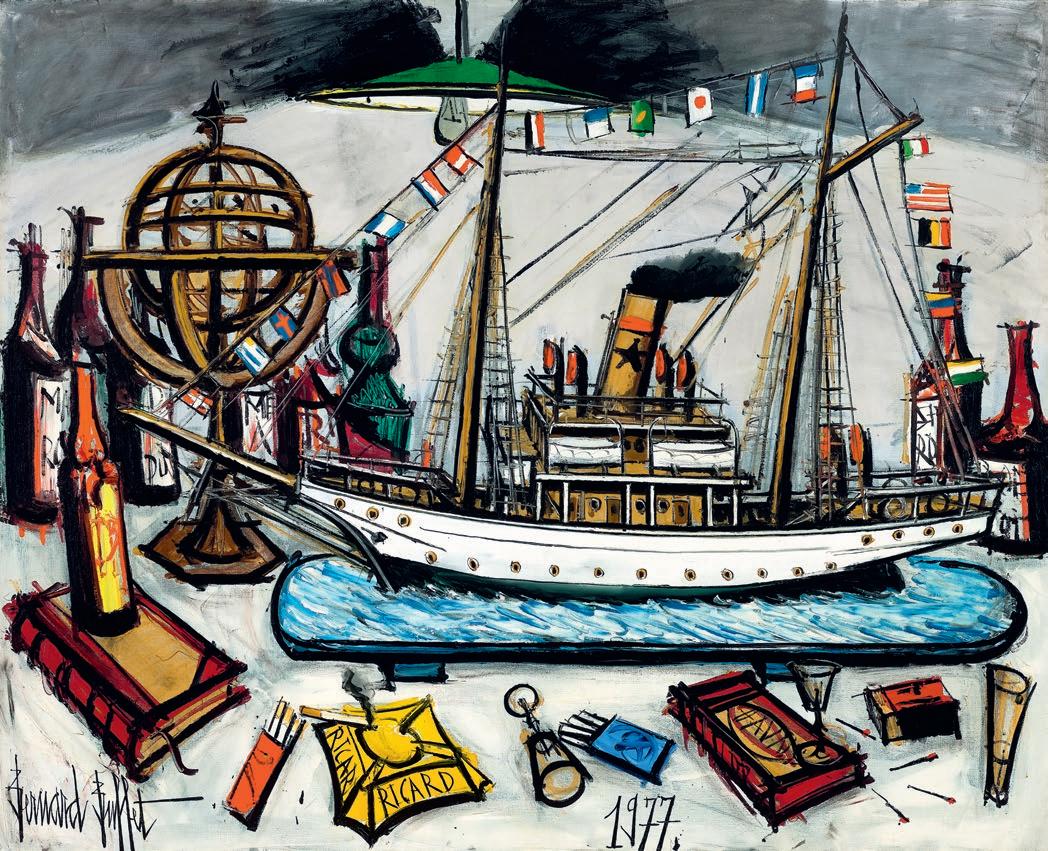
125

Bernard Buffet in his Castle in Villiers-Le-Mahieu, 1977 photographer: Benjamin Auger
Paris Match Archive /Getty Images
Bernard Buffet, once hailed as France’s finest post-war painter1, and reaching dizzying heights of fame and fortune before his thirtieth birthday, later suffered from critical denigration within his home country. Particularly damaging were exposés of Buffet’s lavish lifestyle presented in the illustrated press – a distasteful display in the eyes of the French public. As a member of the L’Homme Témoin (Man as Witness) group supporting expressive social realism, Buffet’s works from the 1950s and 60s were infused with Gallic spleen. 2 Sapped of colour and spatial depth, they reflected the lingering malaise and material privations of Post-War Europe, to which Buffet now appeared to be immune. Flush from successful commercial exhibitions, Buffet nevertheless weathered the public relations storm, and continued to indulge in his penchant for extravagant real estate. By 1971 he was buying his third château, a newly restored 13th-century moated castle near Versailles on the outskirts of Paris, living there with his wife Annabel and their growing brood.
It was within the thick walls of this Château de Villers-le-Mahieu that Hurrah!! Portovenere!, 1977 was painted, with gestural emphasis, by artificial lamplight in the wee hours. Inching towards his 50th birthday, Buffet had just traversed a tumultuous and exhausting decade during which he had become a Chevalier de la Légion d’Honneur and the youngest member ever elected to the Académie des Beaux-Arts;
had been embroiled in copyright litigations (both as plaintiff and defendant); and after a health scare, had monastically adopted years of ‘exemplary sobriety without complaining’. 3 Hurrah!! Portovenere!, with its enthusiastic exclamation points, appears to be an allegorical vanitas painting, in which Buffet has matter-of-factly displayed an array of his recently rediscovered vices. Nicholas Foulkes wrote in his 2016 biography of the artist that Buffet appears to have resumed drinking at the end of 1975, encouraged by his wife Annabel, who had been anxious to see the return of her seductive and moody drinking partner.4 Annabel recalled in her own memoir: ‘on my advice - he changed the strictness of his regime. He allowed himself some champagne or wine, and then he began smoking again. He lost weight. He was rejuvenated. I found that once again he sparkled with life’. 5
Prolifically working in thematic suites throughout his career (both for annual Maurice Garnier exhibitions and for his own artistic resolutions), this still life belongs to a series from 1977 of expressive table-top arrangements, each illuminated by triangular beams of stark lamplight. The symbolic objects of Buffet’s fickle lifestyle were scattered cigarettes in red and blue coloured packets, Havana cigars and spent matches, upturned crystal apéritif glasses, bottles of spirits and wine dripping with red wax, playing cards and a roulette wheel, pistols, a skull, a globe, a pile of leatherbound books and an assortment of model ships. While
126 IMPORTANT AUSTRALIAN + INTERNATIONAL FINE ART
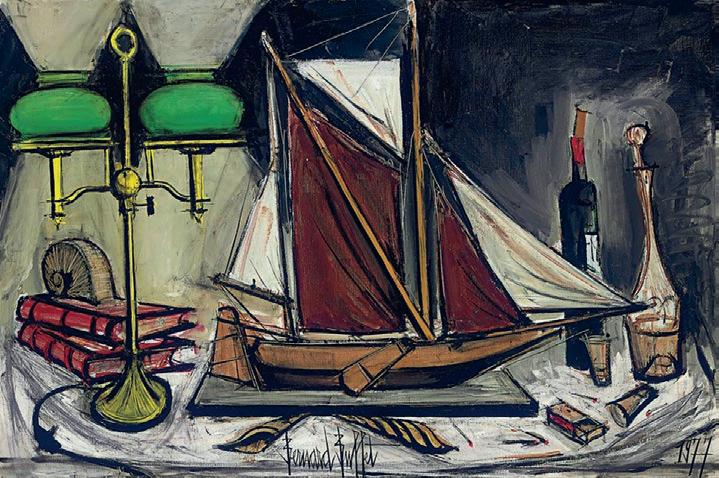
Bernard Buffet
Amsterdam Barge , 1977
oil on canvas, 97.2 x 146.1 cm
Private collection
© Bernard Buffet / Copyright Agency 2024
some of these compositions bore titles relating to the model ship, others had metaphorical titles, such as Le Grand Jeu (The Great Game).
In the early years of the 1970s, Buffet had become increasingly reclusive and feverishly painted sentimental landscapes, many depicting busy harbours of the Breton coast where he had holidayed with his mother in the 1940s. Returning to these maritime themes in his 1977 still lives, Buffet incorporated amongst the relics of his bon-vivant excesses, large model ships – at least four different historical models. Buffet’s library in the château was vast, and purportedly accommodated several largescale models of yachts and ships from the great days of sailpower.6
While the title of Hurrah!! Portovenere! contains both an international maritime celebratory exclamation and the name of a picturesque Ligurian port, the relationship between this title and the model of a two-masted steam-powered schooner within the image is unclear. Whimsically, Buffet has painted plumes of black smoke belching from the model ship’s singular funnel, mirroring the plume of smoke from his own unfinished Gauloise cigarette, balancing on a bright yellow ashtray advertising Ricard pastis. Further emphasising the celebratory atmosphere of toasts and enthusiastic cheers, Buffet’s model ship, gleaming with unpainted white gesso, is ‘dressed overall’. Carefully detailed in the artist’s characteristic scratchy lines, the ship is decked
out with flags in the time-honoured naval tradition for celebrating nation al holidays, regattas or special occasions. Only Buffet has either misunderstood or taken creative liberties with this custom, painting instead of the required international signal flags and pennants, an array of national flags including that of France, Italy, Belgium, the United States and Japan. Accompanied by a stylised globe on a stand, Buffet is perhaps alluding to his increasing global fame and reflecting on his inability to meet it. In 1973, when a museum in his honour had been inaugurated in Japan, Buffet had declined an invitation to attend, writing in apology ‘do not take my absence as a sign of indifference – I am a solitary person’.7 Buffet’s son believed that while his father had thought it morbid and premature to memorialise him with a dedicated museum during his lifetime, he regretted his absence from the celebrations for the rest of his life. 8
1. Connaissance des Arts, Paris, No. 36, 15 February 1955
2. Coined by writer Charles Baudelaire, ‘spleen’ describes a French feeling of melancholy and existential ennui.
3. Buffet, A., D’amour et d’Eau Fraîche, Messinger, Paris, 1986, p. 275
4. Foulkes, N., Bernard Buffet: The Invention of the Modern Mega-Artist, Arrow Books, London, 2016, p. 350
5. Buffet, op. cit., p. 276
6. Foulkes, op. cit., p. 297
7. Musee Bernard Buffet, reproduced in Foulkes, ibid., p. 315
8. Nicholas Buffet, interview with Foulkes, February 2015, cited in Foulkes, ibid., pp. 315 – 16
LUCIE REEVES-SMITH
127
PROVENANCE
Rudy Komon Art Gallery, Sydney
Tony Williams, Sydney
Thence by descent
Private collection, Sydney
FRED WILLIAMS (1927
– 1982)
LANDSCAPE IN UPWEY, 1965
gouache on paper
55.0 x 60.0 cm
signed lower right: Fred Williams
ESTIMATE: $70,000 – 90,000
Private collection, Sydney, acquired from the above
Menzies, Sydney, 1 December 2021, lot 26
Private collection, Victoria
EXHIBITED
Fred Williams, Rudy Komon Art Gallery, Sydney, 12 October – 12 November 1966, cat. 13 (label attached verso)
We are grateful to Lyn Williams for her assistance in cataloguing this work.
One of the most important Australian artists of the twentieth century, Fred Williams transformed the tradition of landscape painting in this country. His unique vision of the natural environment – from areas of scrubby bush on the edges of suburbia, to the vast inland country –captured its essence and created archetypal images that have become part of our collective visual memory. Produced during the mid-1960s at a time when Williams, confident and mature, emerged as a key figure in contemporary Australian art, the Upwey Series sits alongside the preceding You Yangs works as ‘classic’ Williams. Articulating their significance both within Williams’ oeuvre and the broader context of Australian landscape painting, Patrick McCaughey wrote, ‘They were clearly paintings of substance, well made and fully fashioned and yet they still allowed [his] touch to operate. They made of the drab and featureless bush, a landscape of enduring, even monumental proportions and dignity. They revalued Australian landscape painting… and renewed hope in the genre.’1
While Williams had previously painted in and around Upwey, in the Dandenong Ranges to the east of Melbourne, it was the experience of living there from 1963 which provided the impetus for a major series. Now able to paint full-time, he established a studio in the house by joining two rooms together, and the view looking from the valley up the hill to the sky above informed the composition of these images, which are characterised by a narrow band of sky running across the top of a steep, treed slope. 2 The strength of the series was recognised early, with the National Gallery of Victoria acquiring Upwey Landscape III, 1965 from the studio the year it was painted. Major Upwey paintings also entered the collections of the National Gallery of Australia, Art Gallery of New South Wales and Tate, London.
Williams worked in various media throughout his career – the technical possibilities and creative innovations of one, influencing his work in another – and Upwey subjects feature in drawings, etchings, gouaches, as well as oil paintings. A quick-drying medium composed of watercolour mixed with white pigment (which renders it opaque), gouache was his preferred medium for painting outdoors during the mid-1960s 3 . As this example shows however, in addition to its convenience and ease of use, in Williams’ hands, gouache also offered something of the richness of oil paint in terms of the pictorial possibilities and textural manipulation it allowed. The familiar format of the Upwey landscapes is combined here with a luscious wintry palette, a hillside of deep browns, ochre and grey, beneath a pale sky streaked with painterly clouds. Williams’ trademark daubs and dots of paint describe dense vegetation growing across the top of the hill and tree trunks, strongly defined in black, mark out the topography of the hillside, the verticals of standing trees creating a staccato-like rhythm across the picture which is counterbalanced by the series of horizontal lines at centre left depicting a group of recently felled trees.
1. McCaughey, P., Fred Williams 1927 – 1982, Murdoch Books, Sydney, 1996, p. 170
2. See Mollison, J., A Singular Vision: The Art of Fred Williams, Australian National Gallery & Oxford University Press, Canberra, 1989, p. 89
3. In the late 1960s Williams began to make small outdoor oil sketches, adding acrylic paint to his repertoire of outdoor materials in 1971.
128 IMPORTANT AUSTRALIAN + INTERNATIONAL FINE ART
27
KIRSTY GRANT

129
FRED WILLIAMS
(1927 – 1982)
AVENEL, 1971 gouache on paper
57.0 x 76.0 cm
signed lower left: Fred Williams
ESTIMATE: $50,000 – 70,000
PROVENANCE
Private collection
Lauraine Diggins Fine Art, Melbourne (label attached verso)
Private collection, Melbourne, acquired from the above 11 June 1999
EXHIBITED
Annual Collectors’ Exhibition 1999, Lauraine Diggins Fine Art, Melbourne, 5 June – 3 July 1999, cat. 95 (illus. in exhibition catalogue, as ‘Untitled Landscape’)
We are grateful to Lyn Williams for her assistance in cataloguing this work.
We are grateful to Brenda Martin Thomas, wife of the late David Thomas AM, for kindly allowing us to reproduce David’s writing in this catalogue entry.
There is a spontaneity about Fred Williams’ gouaches that singles them out from the rest of his work. Painted outdoors directly from the motif, they have that freshness of first response, sparkling with light and atmospheric luminosity. Like drawing in paint, Williams explored the landscape and its potential for inspiring works. Sometimes painted in two or three strips on the one sheet of paper, or as a single view as in Avenel, 1971, the images captured in gouaches were frequently later developed into oils in the more considered atmosphere of the artist’s studio. Yet although interrelated and worked as a series inspired by the You Yangs, Upwey, Bega, and the Hamersley landscape, his watercolours, prints and paintings, nevertheless remain independent works in their own right. Despite Williams writing in his diary ‘...I only use the subject matter as an excuse to hang the picture on’, such pictures combine a particular sense of place with that of the archetypal Australian landscape.1 Thus,
the oil, Red Landscape , 1981 (National Gallery of Victoria) is as much a part of his Pilbara series as being quintessentially Australian. And likewise, the twelve-sheeted gouache, Bushfire in Northern Territory, 1976 (National Gallery of Australia, Canberra) is the Australian bush on fire, no matter the location.
So it is with the present gouache, Avenel – one of the first landscapes Williams executed in the picturesque locale that was to so capture his attention during the 1970s. Situated in the Victorian wine country of the Goulburn River Valley, Avenel was settled in the 1830s by Henry Kent Hughes who named the area after a village in Gloucestershire, England. The Australian Avenel however, in the heart of Victoria where Ned Kelly famously lived for four years as a child, had little in common with the Cotswolds – the Strathbogie ranges rising steeply on one side, and extensive plains interspersed with trees extending for miles towards Nagambie on the other. Williams first visited the area in late 1971, staying with friend and fellow painter Rosemary Ryan, and her filmmaker husband, Patrick, at their sheep farm Glen Ogil, located in the hills above Avenel. Painted on the 19th November according to an entry in Williams’ diary 2 , Avenel encapsulates Williams’ characteristic tripartite division of the landscape perfectly, with the vastness of the foreground and incline flattened to horizontal bands and the majority of the composition dedicated to an immense expanse of billowing sky – touching on the infinite. Working in the more traditional landscape format, infinity is echoed in the line of the horizon, which would seemingly stretch forever if it were not for the confines of the picture’s space. Making a virtue of what others have seen as the monotony of the Australian landscape, Williams also reveals its intimate side. Although essentially an aerial view, through singular strokes of paint and scumbles of lyrical colour he reminds us of the detailed beauty that lies on the forest floor and in the endless varieties of eucalypt. From Avenel and Lysterfield to Weipa, herein lies the enchantment of our landscape and its unique interpreter.
DAVID THOMAS
130 IMPORTANT AUSTRALIAN + INTERNATIONAL FINE ART
28
1. Diary, 5 July 1970, cited in Zdanowicz, I. & Coppel, S., Fred Williams: An Australian Vision, The British Museum Press, London, 2003, p. 99
2. We are grateful to Lyn Williams for confirming this diary entry.

131
YVONNE AUDETTE
born 1930
COMPOSITION IN BLUE, 1958 oil on plywood
129.5 x 85.5 cm
signed and dated lower right: 58 Audette signed, dated and inscribed with title verso: 1958 Composition / IN BLUE / Audette
ESTIMATE: $80,000 – 100,000
PROVENANCE
Private collection, Sydney, acquired directly from the artist c.1960
Thence by descent
Private collection, Sydney
Even today, at the age of ninety-three, Yvonne Audette conveys the spark and curiosity of the young woman who painted this commanding work in 1958. Always one to chart her own course, Audette had travelled from her hometown of Sydney to New York in 1952 at the tender age of twenty-two, before leaving, three years later, for Europe. Having immersed herself in the riches of the burgeoning Abstract Expressionism movement and a city that was beginning to assert itself as a global art centre, she was on the hunt for something new. After a period of travel in Spain, France and Germany, she settled in Florence and later, Milan, commuting between the two cities to make work, and it is here, surrounded by the history and culture of life on the Continent, that she came to develop and refine her own unique language.
As Audette’s style and confidence grew, her abstractions freed themselves from the blocky, angular forms of her Constructions of 1955 – 57 – with their ‘muscular confidence’ and allusions to the glass and steel of the modern skyscraper1 – and by 1958 her work had emerged, as if from a chrysalis to the airy and more lyrical form of paintings such as Composition in Blue, 1958. The history of the artist’s new home and its ancient built environment is also evident in her shift to working on board at this time; the hardness of the wood providing a sense of resistance that is evident in the overlaid vertical and horizontal brushstrokes that effectively construct the painting. Working in direct
contradistinction to the fashion for the ‘splash and daub’ approach of Action Painting, Audette placed her panels against the wall of her studio, where she could return to and work upon different compositions over an extended period. With its multiple layers and rubbing back to reveal the pentimenti 2 of previous work, it is clear that Composition in Blue has been deliberated over and carefully constructed; its exquisite surface a result of mental rather than physical energy. In effect, the layers of intention, thought and labour that Audette crafted in Composition in Blue, echoed the layers of time and marks of occupation that she experienced in Italy: ‘the dry patinated surfaces, the crumbling textures, the light and colour of the art and architecture about her’. 3 As she later recalled, ‘It was important to leave the ghost or the myth of the underlying form.’4
As a classically trained pianist who was especially appreciative of Bach 5 , music also greatly influenced Audette’s imagery across the years, especially the form of the cantata (from Italian cantare, ‘to sing’), which served as both title and loose framework for multiple works. With this in mind, the assertive lines of Composition in Blue can also be read as a kind of free-wheeling visual score; each calligraphic mark directing a range of voices which come together in an imaginary aural journey of harmony and discord. As our eyes roam the work’s surface, settling on clusters of considered, deliberate marks, we experience this journey visually, as we seemingly move in and out of space, registering the dominant strokes of blue, cream and chestnut as oscillating backwards and forwards or as places for potential pause.
1. Heathcote, C., ‘Yvonne Audette: The Early Years’ in Heathcote, C. et al., Yvonne Audette: Paintings and Drawings 1949 – 2014, Macmillan Art Publishing, Melbourne, 2014, pp. 52 – 53
2. This expression was first used by Bruce Adams in Adams, B., ‘Walls and Ciphers: The Inscriptive Abstractions of Yvonne Audette’ in Ewington, J., Yvonne Audette: Abstract Paintings 1950s & 1960s, Queensland Art Gallery, Brisbane, 1999, p. 9
3. Adams, B., ‘Yvonne Audette: The Later Years’ in Heathcote, C. et al., op. cit., p. 148
4. Audette, Y., interview with Bruce Adams, 13 November 1998 in Adams, B., ‘Walls and Ciphers: The Inscriptive Abstractions of Yvonne Audette’, op. cit.
5. Adams, B., ‘Walls and Ciphers: The Inscriptive Abstractions of Yvonne Audette’, op. cit.
KELLY GELLATLY
132 IMPORTANT AUSTRALIAN + INTERNATIONAL FINE ART
29

133
TONY TUCKSON
(1921 – 1973)
BLUE VERTICAL ON WHITE AND YELLOW, 1971
synthetic polymer paint on composition board
213.5 x 122.0 cm
ESTIMATE: $80,000 – 120,000
PROVENANCE
Private collection, Sydney, a gift from the artist in 1972
With Tony Tuckson’s first solo exhibition held in 1970, he was immediately placed in an inimitable position in modern Australian painting. Critical reaction to this exhibition and another in 1973 singled him out as an abstract painter of rare distinction – large expressive works of sublime grandeur. It was also the year of his premature death, age 52.
Tuckson’s formative interest in Modernism was figurative, with European modernism – especially the School of Paris – shaping his approach. He had studied art in his native England (he was born in Egypt), flew Spitfires in WWII and was sent to Darwin in 1942. After the war he attended East Sydney Technical College where Grace Crowley and Ralph Balson taught, and each played an important role in further developing Tuckson’s outlook on modern painting.
In 1950 Tuckson was appointed to the staff of the Art Gallery of New South Wales, becoming its deputy director in 1957. He developed a keen and deep appreciation of Aboriginal and Melanesian art, and this not only shaped the Gallery’s collection, but also informed his own art. An echo of Ian Fairweather’s approach to painting is one discreet and recurring presence in Tuckson’s work. It is not stylistic, but rather an attitude to painting itself – a philosophy about making art. And they each shared an enduring interest in Aboriginal art and the culture which created it.
Marks, gestures, lineal designs across cultures – and the meanings they hold – became critical to Tuckson’s intellectual temperament. American Abstract expressionism in particular can be regarded as a decisive underpinning in the final paintings and drawings, with Tuckson encountering the movement during a study trip in 1967 – 68. Great post-war abstractionists abounded in New York. In the work of artists such as de Kooning, Newman, Rothko, Pollock, Motherwell and Twombly, Tuckson saw the conceptual and emotional possibilities inherent in abstraction.
In Blue Vertical on White and Yellow, 1971 we might be tempted to look for something observed in the central blue arrangement, but that would be a distraction. Literalism was Tuckson’s anathema.
The blue fluid-brushed, translucent calligraphic sweeps and the accents of yellow reach across white scumbling underpainting. Painterly incidents, dribbles and the shifts in underpainting serve as a veil for the overpainting. The blue becomes an ensemble of simple gestures and avoids any distractions of ‘finish.’ Hardboard especially was a common support for Tuckson, a surface plane with no resistance, something able to accommodate the physical immediacy in creating each work. All Tuckson’s final paintings began with forethought, but the process itself shaped their ultimate character. None suggests any sort of metaphor or understated symbolism, and titles to suggest anything beyond a pictorial description are rare.
When a family friend visited Tuckson, his studio window was open, a breeze parting the curtains offering glimpses to bushland that surround his Wahroonga home. She asked about the meaning of a painting: ‘It’s about this’, Tuckson said, fixated on the motion of the curtains, and then, with a surging gesture, he emphasised, ‘and everything out there.’1
1. Mimmocchi, D., et al., Tony Tuckson, Art Gallery New South Wales, Sydney, 2018, p. 18
DOUG HALL AM
134 IMPORTANT AUSTRALIAN + INTERNATIONAL FINE ART
30

135
JOHN OLSEN
(1928 – 2023)
NEWCASTLE COAL BOAT, 1973
oil on composition board
136.0 x 147.0 cm
signed and dated lower right: John Olsen 73
ESTIMATE: $60,000 – 80,000
PROVENANCE
Rudy Komon Art Gallery, Sydney, 1973 Australian Galleries, Melbourne, 1986
Private collection, Melbourne, acquired from the above in 1987
EXHIBITED
John Olsen: Paintings, Tapestries, Drawings and Lithographs related to his Opera House Mural, Rudy Komon Art Gallery, Sydney, 20 October – 7 November 1973, cat. 4
John Olsen, Atelier 72 Gallery, Adelaide, 11 – 30 March 1974 (on loan from Rudy Komon Art Gallery) 21st Anniversary Exhibition, Rudy Komon Art Gallery, Sydney, 6 December 1980 – 4 January 1981, cat. 23
John Olsen – In search of the open country 1961 – 1986 , Heide Park and Art Gallery, Melbourne, 5 August – 14 September 1986, cat. 6
John Olsen, Australian Galleries, Melbourne, 17 September – 7 October 1986, cat. 10 (illus. in exhibition catalogue)
John Olsen Retrospective, National Gallery of Victoria, Melbourne, 1 November 1991 – 3 February 1992; Art Gallery of New South Wales, Sydney, 8 May – 28 June 1992
LITERATURE
Millar, R., ‘Beaut County’, Herald, Melbourne, 15 August 1986, p. 7 (illus.)
Hurlston, D., and Edwards, D., (eds.), John Olsen: The You Beaut Country, National Gallery of Victoria, Melbourne, 2016, p. 147 (illus.) Hart, D., John Olsen, 2nd ed., Craftsman House, Sydney, 2000, pl. 75, pp. 3, 119, 121 (illus.), 253
We are grateful to Kylie Norton, Editor, John Olsen Catalogue Raisonné, for her assistance with this catalogue entry.
John Olsen was born in Cooks Hill, a suburb of Newcastle, and lived there until he was seven. These were the harsh Depression years when Newcastle was dominated by the BHP steelworks and associated pollutant industries such as mining. Coal was extracted from the banks of the Hunter River (known as Coquun, or Coquon by the traditional custodians, the Awabakal and Worimi people) before being freighted to the port for loading onto ships. In spite of such industrial conditions, Olsen remained a proud Novocastrian throughout his long life and fittingly, his childhood home is located a short walk from the Newcastle Art Gallery which now owns more than forty examples of his work. In 2017, he celebrated his 89th birthday there during the exhibition John Olsen: The City’s Son, which included the major painting King Sun and
the Hunter, 2016, commissioned by the Newcastle Art Gallery the previous year. However, it is a surprise to discover that Newcastle Coal Boat, 1973 was not painted in the city; rather, it was created in Olsen’s adopted home of Sydney, inspired by the passing steel ships and boats he saw during early morning swims in Camp Cove.
Olsen had returned to Sydney in 1971 after some years living amongst the dry scrub bushlands at Clifton Pugh’s property ‘Dunmoochin’ outside Melbourne. In December that year, the artist-critic James Gleeson invited Olsen to paint a mural at the soon-to-be opened Sydney Opera House. Completed in April 1973, the result was an extraordinary twenty-one metre opus inspired by Kenneth Slessor’s poem Five Bells (1939) – full of the artist’s lively motifs painted over the saturated background pigments, where ‘one can sink into the purpley colour, then float on the light blue, becoming part of the heave of the sea.’1 After the muted earthy tones of the paintings done at Dunmoochin, Olsen’s mastery over such an expanse of colour was a revelation, with him writing in his journal that ‘(c)olour should sing and have the vitality and impact that one colour can have against another. Real colour as opposed to tonal colour – the real colour of Persian miniatures, of the Egyptians.’ 2 Newcastle Coal Boat continues Olsen’s embrace of these possibilities with its use of an emphatic red-orange for the water and blue-green for the sky. Surmounted by tangled rigging punctuated by spots of yellow light, the ship’s cranes and hooks resemble the predatory menace of a deep-sea angler fish, whilst underwater, the ‘inventive, symmetrical application suggests a face, like a Melanesian mask.’ 3 It is a deliberately tough painting, though not without Olsen’s trademark humour, for the underwater cables also resemble a gigantic fish looking straight out at the viewer.
When considering the calligraphic marks and squiggles found in paintings such as Newcastle Coal Boat, James Gleeson later wrote of Olsen that ‘[we] are so conscious of the spontaneity that it is often difficult to apprehend the discipline lying behind it. [Olsen] is a master of the art of concealment, of hiding the effort behind an effect of effortlessness, of disguising knowledge as intuition, of painting with a child’s directness and a master’s skill.’4 Originally exhibited at Sydney’s prestigious Rudy Komon Gallery, Newcastle Coal Boat was subsequently retained by the artist for more than a decade, before its re-exhibition at Australian Galleries in Melbourne in 1986. Sold the following year, it has been housed in the same family collection ever since.
1. John Olsen, My salute to Five Bells, National Library of Australia Publishing, Canberra, 2015, p. 20
2. John Olsen, cited in Hart, D., John Olsen, Craftsman House, Sydney, 1991, p. 119
3. Hart, ibid
4. James Gleeson, ‘Comment’, John Olsen, Judith Wright Centre for Contemporary Arts, Brisbane, 1975, unpaginated ANDREW GAYNOR
136 IMPORTANT AUSTRALIAN + INTERNATIONAL FINE ART
31
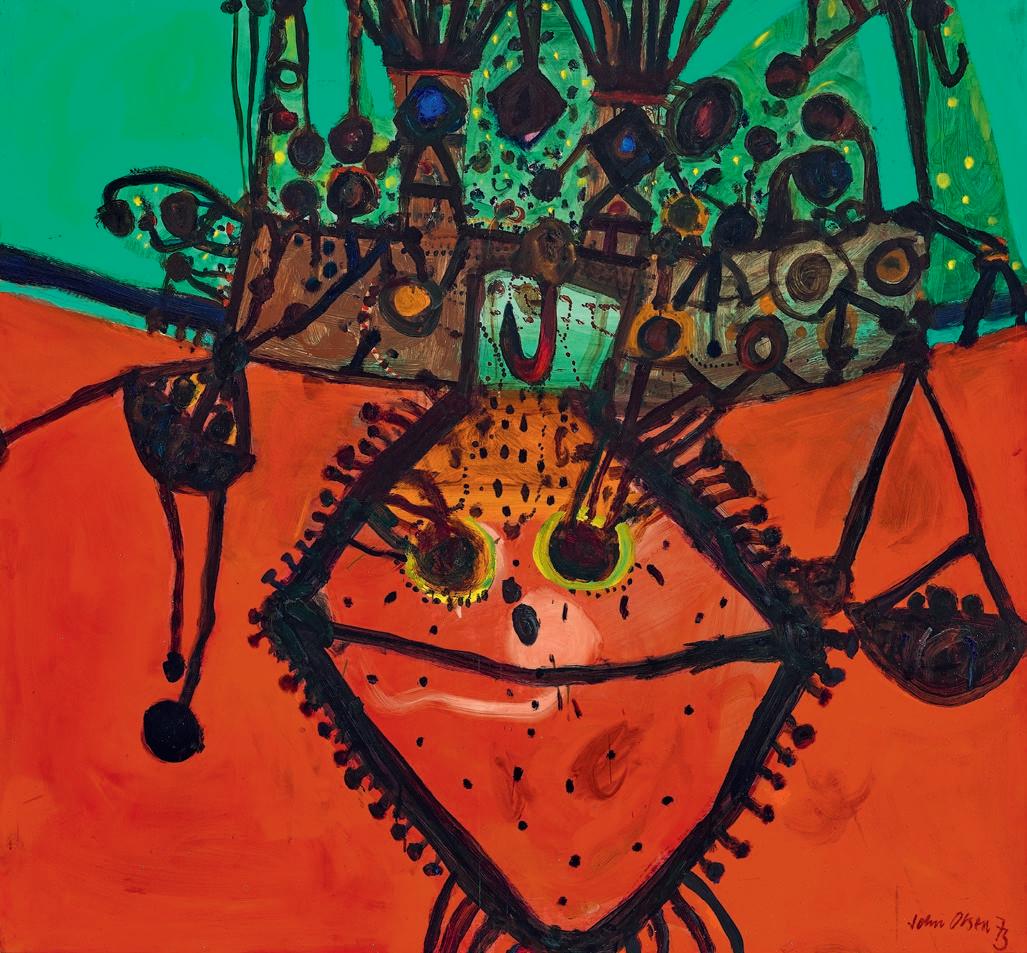
137
CLEMENT MEADMORE (1929
– 2005)
OUTSPREAD, 1991 bronze
93.0 x 92.0 x 62.0 cm edition: 3/6 signed, dated and numbered at base: Meadmore 2000 3/6 dated, numbered, inscribed with title and monogram on base: "Outspread" / 2000 3/6 / ART
ESTIMATE: $90,000 – 120,000
PROVENANCE
Robin Gibson Gallery, Sydney Private collection, Tasmania, acquired from the above in October 2007
EXHIBITED
Clement Meadmore , Robin Gibson Gallery, Sydney, 17 November – 12 December 2007, cat. 13 (another example)
RELATED WORK
Outspread, 1991, painted aluminium, 1036.5 cm height, Adachi Ward, Tokyo, illus. in Gibson, E., The Sculpture of Clement Meadmore, Hudson Hills Press, New York, 1994, p. 122
Clement Meadmore is Australia’s most significant and internationally accomplished sculptor. In a career spanning over fifty years, most of which was spent in America, Meadmore’s work featured not only enormous breadth in scale from small-scale maquettes to monumental works – as evidenced by the larger, black-painted aluminium version of Outspread, 1991 (Adachi Ward, Tokyo) – but traversed a wide-ranging scope of complex forms within a minimalist framework. The purity of his formal conceptions and command of materials ensure that each sculpture is a consummate example showcasing an uncompromising eloquence and weightlessness – whether it is 30cm high or over 10 metres. Furthermore, each sculpture complies to the maxim of being viewed independently but successfully from every vantage, no matter the scale, in order that the form can exude its presence be it through its rhythm, physicality, or innate energy, to inhabit, shape and extend into the environment.
Meadmore’s early work initially depicted encrusted welded vertical rods, later moving to the raw uneven interconnected slabs of metal, before mastering and elaborating on the tenets of American minimalist sculptors, exemplified in the work of Tony Smith, Donald Judd and Richard Serra amongst others. In Meadmore’s mature work, Eric Gibson has observed roughly three main phases: the dense coiled sculptures of the 1960s; the sculptures composed of multiple parts made in the 1970s; and the branching sculptures of the 1980s.1 Each period reflects a meticulous and often unsettling fusion of uncompromising balance and tension – a relentless quest to make inert and unyielding materials (mostly bronze or aluminium) come alive. Whether taking the shape of tightly compacted coils, elegant musical note-like forms, or divergent angles or shapes, the sculpture must reflect the mastery of form through the now manipulated and exquisitely shaped material.
Outspread, 1991 belongs to Meadmore’s late period in which he looked back on his body of work as a resource to be retrospectively considered, evaluated and progressed. The divided angles expressed in Outspread, refer to a body of work completed in the 1980s such as Outcome, 1983; Offshoot, 1982; and Aside, 1983. In Outspread, Meadmore contemplates the exquisite tension of opposing sharply sliced angles which have been split and turned away from their original rectangular source. The energy of the protruding spliced angles penetrates the inhabited space, offering a sense of magnitude whilst resting on Meadmore’s iconic vertically curved rod-shaped base. Meadmore is in his element, converting an intractable material bronze into a free, spontaneous, and complex moving form.
1. Gibson, E., The Sculpture of Clement Meadmore, Hudson Hills Press, New York, 1994, p. 112
FIONA HAYWARD
138 IMPORTANT AUSTRALIAN + INTERNATIONAL FINE ART
32

ROBERT KLIPPEL (1920 – 2001)
NO. 448 BIRDBATH, 1982
AP2 from an edition of 6 + 2AP bronze
137.0 x 63.5 x 31.0 cm signed with initials, dated and numbered on base: RK 448 82 AP Meridian Melbourne foundry stamp at base
PROVENANCE
ESTIMATE: $150,000 – 250,000 33
The Estate of the artist, Sydney Annette Larkin Fine Art, Sydney Private collection, Sydney, acquired from the above in 2013
EXHIBITED
Robert Klippel, Recent Sculpture and Works on Paper, Watters Gallery, Sydney, 16 November – 10 December 1983, cat. 73 (another example, illus. in exhibition catalogue)
Robert Klippel, Bronze Sculptures and Works on Paper, Pinacotheca, Melbourne, 14 November – 1 December 1984, cat. 18 (another example, illus. on front cover of exhibition catalogue)
Robert Klippel, Art Gallery of New South Wales, Sydney, 9 August – 13 October 2002 (another example)
Art in The Park XI 2013: Robert Klippel, Galerie Gmurzynska, Zurich, June – August 2013
LITERATURE
Edwards, D., Robert Klippel, Art Gallery of New South Wales, Sydney, 2002, pp. 193 (illus.), 250
Edwards, D., Robert Klippel: A Catalogue Raisonné of Sculpture , CD–ROM, Art Gallery of New South Wales, Sydney, 2002, cat. 448 (illus., another example)
Robert Klippel – The American & European Years , Galerie Gmurzynska, Zurich, 2013, pp. 64 – 65 (illus.)
RELATED WORK
Another example from this edition is held in the Parliament House Collection, Canberra
With an unwavering artistic vision and continued inventiveness of form Robert Klippel became one of Australia’s most preeminent and original sculptors. In the early 1980s, the fourth decade of his artistic career, Klippel experienced a burst of creative activity stimulated by his rediscovery of wood – a material that not employed since his early carvings some forty years prior. No. 448 Birdbath, 1982 is a singular work in Klippel’s late oeuvre. Although its form is typically uncompromisingly abstract and geometric, the rare addition of a descriptive epithet for its first public exhibition1, Birdbath , adds a humorous and functional dimension to this monumental bronze cast. This title also recalls Klippel’s early flair for surrealist automatism and his continued use of the scavenged, found object. No 448, a table-
like form, is constructed of a shallow hexagonal basin perched on a column of two stacked vertical blocks, topped with several jaunty curved elements, evenly balancing on the rim and extending joyfully into three dimensions.
In 1980, the burgeoning Australian National Gallery advertised their intention to commission contemporary Australian sculpture for their outdoor garden, piquing Klippel’s interest and sparking a new direction in his work towards monumental constructions in wood and bronze. 2 No. 448 and over a hundred other constructions from this decade were borne from a vast pre-existing cache of wooden objects that the artist had stored in his Birchgrove home studio, a trove which Klippel called a ‘field’. 3 These geometric fragments were obsolete pattern-parts of machinery, originally used to create moulds for metal castings, and had been found by chance by Klippel’s friend, the artist Colin Lancely between October 1963 and June 1964, in a disused store belonging to Morts, a shipbuilding firm operating a dry-dock in Balmain from the mid-19th century. For Klippel, a former WWII navy officer and engineer, the maritime applications of these blocky sections held special significance. Unlike Lanceley, whose baroque assemblages commenced immediately, Klippel waited some 20 years before incorporating the wooden parts into his sculptures, either retaining their original bright painted surfaces, or, as in No.448, sanded smooth and cast in monochrome bronze with ‘stately solemnity.’4
In incorporating into his constructions fragments of real machinery, Klippel’s doggedly abstract sculptures are animated with a poetic synthesis of industrial-mechanical and organic energies. Although using a base formal lexicon of arbours and cogs, pinions and axles, Klippel’s curved forms on the top of this construction echo the dynamic shapes of birds in flight, noisily enjoying a bath. A poetically simple composition, No. 448 is stripped down to a formal arrangement of a static and rectilinear base juxtaposed with an exuberant and asymmetric capital requiring a viewing in the round. Freestanding and bearing no fixed point of view, the viewer’s eye is instead drawn in multiple directions and perspectives. These additions to the top of the composition display a free and spontaneous handling of forms, placed casually as if by chance and defying physics by having been cast solidly together in perpetuity.
1. In the catalogue for Robert Klippel, Recent Sculpture and Works on Paper, Watters Gallery, Sydney, 15 November - 10 December 1983, No. 448 is both illustrated on the cover of the catalogue and features in the large list of 75 bronze sculptures as the only work with a descriptive title in addition to the consecutive RK number. The same is true for the Pinacotheca exhibition the following year.
2. Edwards, D., Robert Klippel, Art Gallery of New South Wales, Sydney, 2002, p. 188 3. ibid.
4. Gleeson, J., Robert Klippel, Bay Books, Sydney, 1983, p. 413
140 IMPORTANT AUSTRALIAN + INTERNATIONAL FINE ART
LUCIE REEVES-SMITH

INGE KING (1915 – 2016) NAYADS, 1993 bronze
114.0 x 120.0 x 52.0 cm
ESTIMATE: $40,000 – 60,000
PROVENANCE
Australian Galleries, Melbourne Private collection, Melbourne, acquired from the above in 1994
EXHIBITED
Inge King, Australian Galleries, Melbourne, 8 August – 3 September 1994, cat. 5
LITERATURE
Trimble, J., Inge King SCULPTOR, Craftsman House, Sydney, 1996, pp. 164, 165 (illus.), 206 Grishin, S., The Art of Inge King Sculptor, Macmillan Art Publishing, Melbourne, 2014, p. 374
RELATED WORK
Nayads Maquette , 1993, bronze, 37.5 x 40.0 x 18.5 cm, formerly in the collection of the artist Nayads II, 1996–97, patinated bronze and synthetic polymer paint, 232.6 x 278.0 x 117.3 cm, in the collection of the National Gallery of Victoria, Melbourne
At the time of her death in 2016 at the age of 100, Inge King’s work had transformed her hometown of Melbourne, with monumental sculptures such as Forward Surge, 1974 at the Arts Centre; Shearwater, 1994 – 95 at Southbank; and Sentinel, 2000 on the Eastern Freeway, becoming iconic city markers – recognised by tens of thousands of people, even if they remained unaware of the name or extraordinary achievements of the artist who made them.
When King emigrated to Australia with husband and fellow artist Grahame in 1951, she had already trained in Berlin, Glasgow, London and New York, accumulating considerable experience as a sculptor. Just two years later, she was one of the founding members of the Group of Four (along with Julius Kane, Clifford Last and Norma Redpath), which was established with the collective desire to create a sympathetic relationship between modern abstract sculpture and architecture. The Group was joined by Vincas Jomantas, Lenton Parr and Teisutis Zikaras in 19611, becoming Centre 5 – a seminal coterie that continued to
champion a greater appreciation of modern sculpture and the inclusion of ambitious sculpture in contemporary Australian architecture.
As one of the first Australian sculptors to learn to weld 2, King began to work exclusively in welded steel from the mid-1960s, creating work that could withstand Australia’s harsh conditions and hold its own in what seemed to her to then be a ‘strange, untidy landscape’. 3 However, over time, she came to love and better the understand the Australian bush, with its cast of unique birds becoming part of her lexicon of totemic figures in the 1990s.
This influence is clearly evident in Nayads , 1993, whose abstracted bird-like form seems to dance and leap, its expressive and free movement capturing the joy and playfulness of the female nymphs of Greek mythology referenced in its title. While registered with surprise, King’s shift to figuration in the early 1990s – described by Charles Green in Artforum International as ‘an intensely cosmopolitan revision of Modernist abstraction’4 – was a resounding conceptual and critical success. Interestingly, it also led to new working methods for the artist, with King initially making and arranging shapes cut from paper, and then balsawood, before having these balsawood sections either cut in steel or, in the case of Nayads, sand-cast in bronze and patinated. Once returned from the foundry to the artist, these parts were then arranged into forms and soldered together, leading to fascinating combinations based on the art of assemblage and collage.
The National Gallery of Victoria was to mount the major survey of King’s work, Inge King: Sculpture in 1992, with these recent works serving as an indication of exciting new directions in the artist’s practice. Made in the year following the NGV exhibition, Nayads was to become the catalyst for the Gallery’s commission of second version of the sculpture – Nayads II, 1996 – 97, realised at a larger scale, and for which the Gallery sought permission from the owner of the original work in order to proceed.
1. The exact date of Centre 5’s formation has been long contested. This is the date ascertained by Jane Eckett from Lenton Parr’s diaries in his papers in the State Library of Victoria, Melbourne. See Eckett, J. ‘Binary Star: Inge and Graham King’ in Hurlston, D. & Jane Eckett, Inge King: Constellation, National Gallery of Victoria, Melbourne, footnote 60, p. 119
2. Scarlett, K., ‘Tough and Dedicated’, Australian Art Review, Sydney, February – April 2010, p. 48
3. Lancashire, R., The Age, 31 September 1992, at https://igking.info/inge-king-2/inge-kingthe-early-years/ (accessed December 2021)
4. Green, C., ‘Inge King’, Artforum International, vol. 31, no. 7, March 1993, p. 108, cited in Hurlston & Eckett, op. cit., p. 19
KELLY GELLATLY
142 IMPORTANT AUSTRALIAN + INTERNATIONAL FINE ART
34

IMANTS TILLERS
born 1950
OUTBACK: P, 2008
synthetic polymer paint and gouache on 54 canvas boards 227.5 x 213.0 cm overall each panel numbered sequentially with stencil verso: 083448 – 083501
ESTIMATE: $50,000 – 70,000 (54)
PROVENANCE
Bett Gallery, Hobart
Private collection, Brisbane, acquired from the above in 2009
EXHIBITED
Clouds on a Distant Horizon, Bett Gallery, Hobart, 11 March – 21 April 2009
With a large tiled grid of 54 shimmering painted canvas boards, Imants Tillers’ Outback: P, 2008 presents an open landscape, its deep red earth dotted with spindly trees and overlaid with a scatter of text references and place names. The underlying landscape of radiant ochre hues, although not explicitly named, is of the foothills of the Dandenong Ranges in Victoria, specifically a view painted by Fred Williams in 1965 in a similarly large composition currently in the collection of the National Gallery of Australia: Upwey Landscape , 1965 – 66. Tillers’ ‘Outback’ paintings comprise a specific subset of works within the artist’s appropriationist practice. Together they comprise a kind of historiography of western landscape art in Australia, from Glover to Gascoigne, interrogating how the continent has been mythologised in art and language. Landscape is a dominant theme in Tillers’ oeuvre, particularly since moving to the arid countryside of the Monaro region in 1998. His landscape paintings are ‘meditations about landscape’, viewed the prism of Western art history, often looking back to whom he considers to have been ‘the last credible landscape artist: Fred Williams.’1 The Outback works, starting in 2003, are an offshoot of the series ‘Nature Speaks’ (1998 - present) within the artist’s vast anthology of his canvas board works, numbered consecutively since 1981 and collectively titled The Book of Power
As an interpretation of a historical painted landscape, Tillers’ work speaks to the idea of flux and transience, of different perspectives that have coloured previous attempts to capture the essence of the Australian landscape. A postmodern artist par excellence, Tillers’ longstanding artistic practice has been founded on its devices:
appropriation, grid-based enlargement and reproduction and application of text and stencilled overlay on the painted surface. Layering, repetition and variation are central tenets of his practice. Outback: P, like each of the paintings in the larger ‘Nature Speaks’ series (comprising of 159 paintings in 2009) includes the words of the artist’s ‘Mallarméan mantra’, 2 taken from a Symbolist poem of free verse and radical typography by Stéphane Mallarmé, Un coup de dés jamais n’abolira le hasard from 1897: ‘a throw of the dice will never abolish chance’ in blue stencilled text. Joining these words is a cascading list of placenames, providing a tangible sense of locality with words which the artist describes as ‘readymade poetry.’ 3 . This list runs vertically down the centre the painting, listing locations from north to south, from Yirrkala and Faraway Bay in the Northern Territory on the top edge of the painting, to Bendigo in Victoria at the bottom. By also including words from David Horton’s map of Aboriginal language groups: Arrernte/Amangu/Kurrenji, Tillers signifies his acknowledgement of the underlying sovereignty of First Nations people.
Included in an exhibition in Hobart in 2009, titled ‘Clouds on distant horizon’, alongside several paintings from the ‘Nature Speaks’ series, Outback: P is a translation of Fred Williams’ distillation of the landscape into a flat and increasingly minimal painterly vocabulary. Tillers has transcribed Fred Williams’ gestures into graphic stencilled silhouettes obscured under a textural pattern of fragmented metallic lettering. Although Tillers has retained the high horizon of Williams’ original painting and through his own artistic techniques augmented its compressed depth of field and glowing layers of red-ochre and golden brown, the finished work bears little resemblance to Upwey Landscape. Instead it joins Tillers’ grand conceptual project. Like its siblings, this perceptive painting solicits deep reflection on how the painted landscape informs our collective conception of the physical landscape and forges our national identity.
1. Imants Tillers, 9 April 2012, see: https://www.artgallery.nsw.gov.au/prizes/ wynne/2012/29209 (accessed March 2024)
2. Tillers, I., ‘When Locality Prevails’, Heat, No. 8, 2004, p. 115 3. ibid.
LUCIE REEVES-SMITH
144 IMPORTANT AUSTRALIAN + INTERNATIONAL FINE ART
35
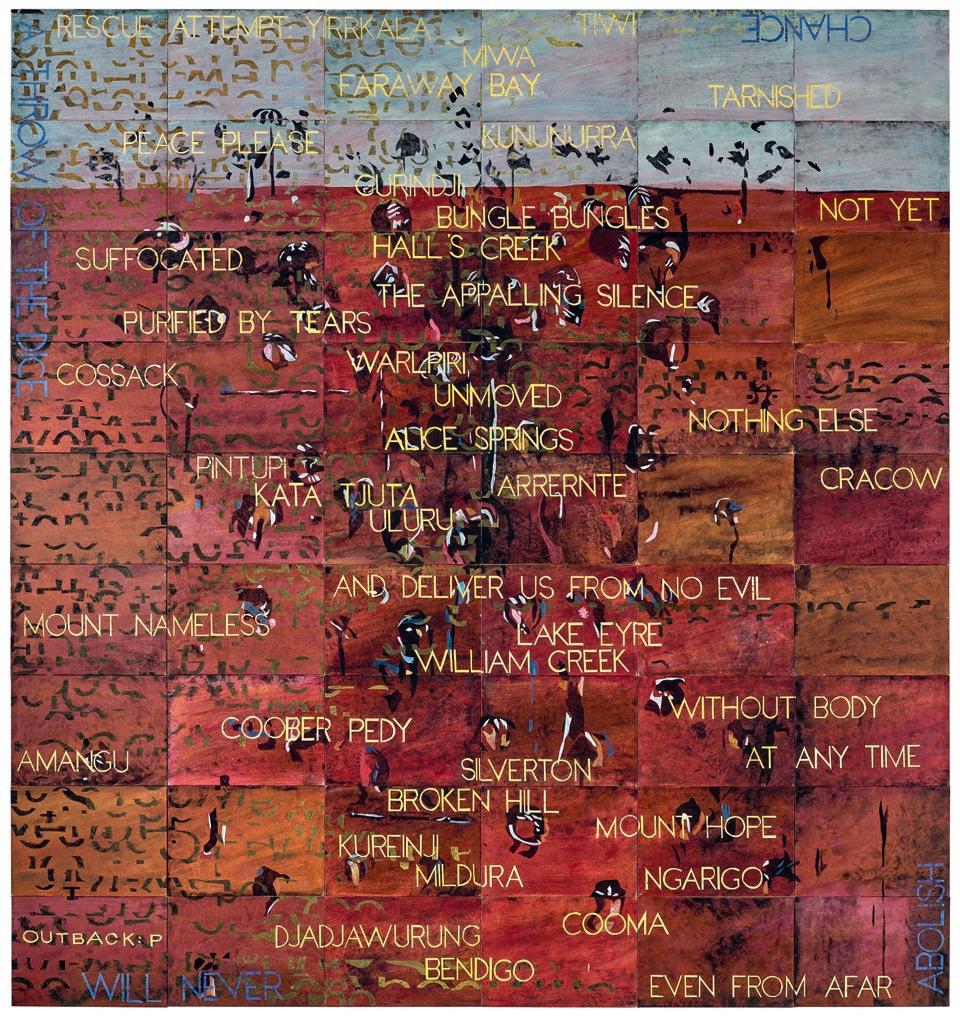
145
JOHN KELLY
born 1965
MAN LIFTING COW, 1994 oil on linen 74.5 x 54.5 cm signed and dated lower right: Klly [sic] 94
ESTIMATE: $35,000 – 45,000
PROVENANCE
Niagara Galleries, Melbourne
Private collection, New South Wales, acquired from the above in 1994
EXHIBITED
Niagara Galleries at ACAF 4, Fourth Australian Contemporary Art Fair, Melbourne, 29 September – 2 October 1994
Fusing intelligent social commentary with playful humour, reality with non-reality, John Kelly is recognised internationally as one of the most original artists of his generation. Widely acclaimed for his iconic theme of ‘the cows’ – exemplified here brilliantly by Man Lifting Cow, 1994 – Kelly completed a Masters of Arts at RMIT University in 1995, following which he was awarded the prestigious Anne and Gordon Samstag International Visual Arts Scholarship to further his studies as an Affiliate student at the Slade School in London. He has since regularly exhibited in the United Kingdom with Piccadilly Galleries, Agnew’s, and Merville Galleries, and his surrealist cow sculptures have been included in a number of major international exhibitions including the Champs de la Sculpture II (1999) on the Champs Elysées, Paris; La Parade des Animaux (2002) in Monte Carlo; the Musée d’Art Moderne de Contemporaine, Nice (2007); The Hague (2007); Glastonbury (2006 and 2007); and Cork City (2011). Closer to home, he is obviously known to local audiences through his beloved sculpture, Cow up a Tree , 2000, permanently situated on the Harbour Esplanade at the Docklands, Melbourne.
Occupying the vast majority of his oeuvre, Kelly’s whimsical cow interpretations were originally inspired by William Dobell’s creation of papier-mâché cows during World War II, deployed as camouflage around defence bases in a strategy intended to deceive enemy warcraft. As Dr McMahon recalls, 'When World War II broke out, Bill [Dobell] served as a camouflage labourer, and later as an artist recording the work of the Civil Construction Corps which built airfields and other defence projects. As a camouflagist, he was one of several, later famous artists1, who had been
ordered to make papier-mâché cows and move them around the base in the hope of fooling Japanese pilots. Said Bill, ‘I think the authorities underestimated the eyesight of Japanese airmen…’’ 2
Like many of his inaugural iterations upon the theme, in Man Lifting Cow Kelly explicitly references this bizarre episode as his source of inspiration – here evoking the mysterious workshop of Dobell’s airfield as his setting, complete with windsock blowing in the distance and bomber plane overhead, while an air force worker in blue overalls moves a (presumably) papier-mâché cow around the base. Significantly however, over time ‘Dobell’s cows’ would gradually morph to become ‘Kelly’s cows’, isolated from the original historical narrative and acquiring their own history and curious identity. Depicted as stacked, balanced, wheeled, propped on trestles, assembled sideways or upside down, indeed these later interpretations would be notably bereft of any hint of wartime tragedy, despair or bleakness. To the contrary, such works became ‘humorous forays into the artist’s inventiveness… poignantly quizzical metaphors for aspects of Australian culture and colonial history, or even enigmatic signifiers of art’s shifting purposes and the puzzling scenarios in which it finds itself.’3 As the artist himself elucidates, ‘My intention is to create work that encapsulates the concepts and ideas that intrigue me. I take historical subjects such as Dobell’s cows… and my own personal experience to build a framework within which I can create my own vision of things. Within this, I pursue a multi-layered research of imagery of concepts and ideas, both visual and intellectual… to generate paintings and sculptures that create their own history by engaging in the real world as works of art… I like to create works that reach beyond their absurdity to reflect something of my visual and intellectual environment. This is my intent.’4
1. Other celebrated Australian artists enlisted as camoufleurs included Arthur Boyd, Joshua Smith and Ivor Francis.
2. McMahon, E., First Draft, Dobell Archives, National Gallery of Victoria, Melbourne, see John Kelly, Cow up a Tree, Niagara Galleries, Melbourne, 1999, p. 12
3. Hammond, V., ‘Cow Up a Tree / Sculpture’ at https://www.onlymelbourne.com.au/cow-up-atree (accessed February 2024)
4. Kelly, cited in John Kelly, Cow up a Tree, op. cit.
VERONICA ANGELATOS
146 IMPORTANT AUSTRALIAN + INTERNATIONAL FINE ART
36

147
BEN QUILTY
born 1973
AUSTRALIAN LANDSCAPE #1, 2005 oil on canvas
90.0 x 120.0 cm
signed, dated and inscribed with title verso: Australian Landscape No 1 / Quilty / 05
ESTIMATE: $45,000 – 65,000
PROVENANCE
Jan Murphy Gallery, Brisbane Private collection, Sydney, acquired from the above in 2005
EXHIBITED
Alex Seton, Ben Quilty, We’ve Gotta get out of This Place , Jan Murphy Gallery, Brisbane, 29 July – 13 August 2005
Ben Quilty describes this work as Australian Landscape #1, 2005, yet it is the Toyota 4WD Landcruiser that is the actual subject of the painting. Quilty makes his choice of vehicle carefully exploring the landscape and our relationship with it through the cult of the 4WD vehicle. In this instance it reflects a young white male’s desire to identify with the tough talking, hardworking Australian male of the outback. It says, ‘I belong with no-bullshit, can-do real men and with my Toyota, I am connected with the land.’ As a backdrop to the yarns and myths that ferment across the outback, the Toyota Landcruiser parked out the front of the pub pulses with masculine credibility.
Vehicles are not new to Quilty – the Holden XU1 Torana, with its V8 engine crammed under the hood became an early favourite. The Torana entered Australian folk lore in 1972, when Peter Brock drove it to victory against the dominant Ford Falcons at Bathurst’s annual orgy of booze and petrol on Mount Panorama, in the Hardie Ferodo 500. In the decades that followed, the popular Torana (an Aboriginal word meaning ‘to fly’) became the choice of young men when buying their first, second-hand car. By the time Ben Quilty got his Ps, the choice was easy. As time passed his repertoire extended to include Kombis, muscle
Fords and 4WDS. Here again, the artist is exploring our relationship to landscape and its importance in shaping the lives of adolescent males through risk-taking rites of passage.
As Lisa Slade suggests, ‘The terrain that the car inhabits, and traverses also interests Quilty. Since he began painting cars, he has been adamant that these paintings also be read as landscapes… Quilty argues convincingly that we rarely experience the landscape without the mediation of the car. In this sense, the car becomes a contemporary Claude glass, a reflective lens that simplifies and synthesises an experience of the landscape that is otherwise too much to bear, too much to restrain into an image.’1
By coincidence or otherwise, the three by four-foot format of this work connects the work directly to a tradition in modern Australian landscape painting. The reason for this format may well be arbitrary as it corresponds to the size the Masonite sheets are made. Nevertheless, conceptually it is a tangible connection to the convention and underpins Quilty’s assertion that what he has painted here is an Australian landscape – albeit an image of a Toyota.
Quilty’s paintings ooze paint and metaphor. His technique of applying paint in broad, thick swathes using baker’s tools results in fleshy surfaces where the paint is literally caked on. The manner of applying paint in moments of driven inspiration may also be understood to reflect the bravado Quilty’s paintings strive to project.
1. Slade, L., ‘Torana Means to Fly’ in Slade, L. (ed.), Ben Quilty – We are History, University of Queensland, Brisbane, 2009, p. 22
HENRY MULHOLLAND
148 IMPORTANT AUSTRALIAN + INTERNATIONAL FINE ART
37

149

GWYN HANSSEN PIGOTT (1935 – 2013)
WINDOW SERIES – STILL LIFE, 1999
Limoges porcelain seven pieces (2 bottles, 3 beakers, 2 bowls) 44.0 cm (overall) each stamped at base with artist’s roundel
ESTIMATE: $10,000 – 15,000 (7)
PROVENANCE
Rex Irwin Art Dealer, Sydney
Private collection, Sydney, acquired from the above in 1999
EXHIBITED
Important Works on Paper, Rex Irwin Art Dealer, Sydney, 23 March – 17 April 1999, cat. 23
150 IMPORTANT AUSTRALIAN + INTERNATIONAL FINE ART
38

born 1972
MUTUAL VIBRATION (ALL TOGETHER NOW), 2017 voile, acrylic mirror and wood 65.0 x 50.0 x 6.0 cm
signed, dated and inscribed with title verso: “Mutual Vibration (All together now) / Study” / NIESCHE / 2017
ESTIMATE: $9,000 – 12,000
PROVENANCE
Zeller van Almsick, Vienna Private collection, Melbourne, acquired from the above in July 2017
EXHIBITED
Splitting Image: Jonny Niesche , Zeller van Almsick, Vienna, 23 June – 29 July 2017
151
JONNY NIESCHE
39

LLOYD REES (1895 – 1988)
STABLES AT PARRAMATTA, 1924 oil on canvas on board 20.0 x 30.0 cm
signed and dated lower left: REES / 24
ESTIMATE: $12,000 – 18,000
40
PROVENANCE
Private collection
Sotheby’s, Melbourne, 25 August 1998, lot 82
Private collection, Melbourne
LITERATURE
Free, R., Lloyd Rees , Lansdowne, Melbourne, 1972, cat. 022, n.p.
152 IMPORTANT AUSTRALIAN + INTERNATIONAL FINE ART
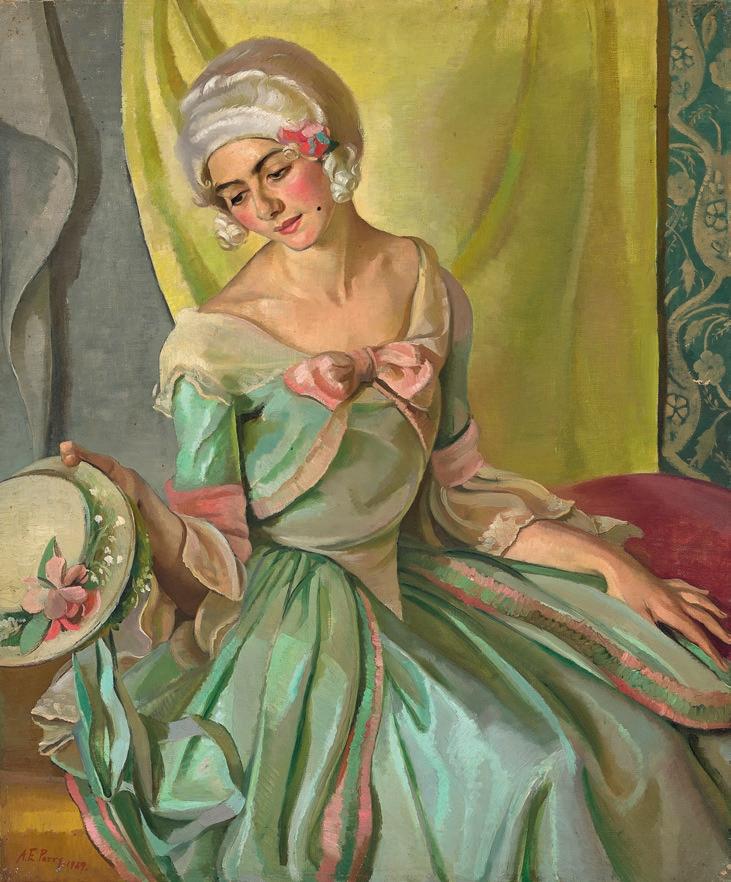
ADELAIDE PERRY (1891 – 1973)
GREEN AND SILVERY, 1929 oil on canvas 76.0 x 63.0 cm signed and dated lower left: A. E. Perry / 1929.
ESTIMATE: $18,000 – 24,000
41
PROVENANCE
Private collection, Sydney
Artlovers Gallery, Sydney
Private collection, Sydney
EXHIBITED
Society of Artists' Annual Exhibition, Education Department, Sydney, 7 September – 4 October 1929, cat. 110 (as 'Green and Silver')
153
SALI
HERMAN (1898 – 1993)
PADDINGTON, 1967 oil on canvas
102.5 x 137.5 cm
signed and dated lower right: S. Herman 67
ESTIMATE: $40,000 – 60,000
PROVENANCE
B.N. Beirman, Sydney, by 1971
Holdsworth Galleries, Sydney
Private collection, Sydney, acquired c.1993
EXHIBITED
Sali Herman, Holdsworth Galleries, Sydney, 8 October 1973, cat. 39
Sali Herman Retrospective , Art Gallery of New South Wales, Sydney, 30 June – 26 July 1981, cat. 92, lent by Mrs B.N. Beirman (label attached verso, as ‘Terrace houses’)
LITERATURE
Thomas, D., Sali Herman, Australian Art Monographs , Georgian House, Melbourne, 1962, pl. 66 (illus.), p. 112
Pearce, B., Sali Herman Retrospective , Art Gallery of New South Wales, Sydney, 1981, cat. 92, pp. 27 (illus.), 80 (as ‘Terrace houses’)
only full of the social history of a time now past, but are also fascinating as works of art. It began with McElhone Stairs, 1944 (National Gallery of Australia), which was awarded the 1944 Wynne Prize, accompanied by the howls of outrage that then plagued art prizes. Sydney Scene, 1946 was acquired by Yehudi Menhuhin; The Law Courts, 1946 went to the National Gallery of Victoria (via the Felton Bequest); and the Art Gallery of New South Wales added Near the Docks, 1949 to its collections. Other prominent private and public collectors gained similar works. Mr and Mrs Kenneth Myer chose the engaging Feeding the Cats, 1952, and the state galleries in Adelaide and Perth acquired Reconstruction, 1950 and Woolloomooloo, 1952, respectively.
We are grateful to Brenda Martin Thomas, wife of the late David Thomas AM, for kindly allowing us to reproduce David’s writing in this catalogue entry.
The rich vein of humanitarianism that runs throughout Sali Herman’s art finds ideal expression in Paddington, 1967. The older parts of inner Sydney, of Paddington and Woolloomooloo and their Victorian terraces attracted Herman during the forties as much as the people and street life around them. He was so fascinated by their character, both architectural and human, that he produced a series of paintings which today are not
Herman painted old Sydney, then slums, with sympathy, a fresh eye and a lively mind. ‘To anybody used to pictures of gum trees and the harbour,’ he said, ‘my slum pictures were startling. But I painted houses, because houses are part of people and people are part ofhouses.’1 These pictures are peopled with anecdote – a woman sweeps the front footpath or sits at the window watching the passing parade (as in the present work), a child chases a dog and others play in a vacant lot. For those who lived in these small, often cramped terrace houses, the street offered the place to socialise. Herman also involves the personalities of the houses themselves, as in the peeling paint. As Barry Pearce observed, ‘With a palette knife he plastered and scraped his pigments across the canvas so that the textures took on the very character of the buildings he was portraying.’ 2 Through paintings such as these, where ideas, technique, and humanism harmonise, Sali Herman has long endeared himself to collectors.
1. Herman, cited in Hetherington, J., Australian Painters: Forty Profiles, F.W. Cheshire, Melbourne, 1963, p. 77
2. Pearce, B., Swiss Artists in Australia, 1777 – 1991, Art Gallery of New South Wales, Sydney, 1991, p. 68
DAVID THOMAS
154 IMPORTANT AUSTRALIAN + INTERNATIONAL FINE ART
42

155

ARTHUR BOYD (1920 – 1999)
SHEEP GRAZING, WIMMERA oil on composition board 52.0 x 64.0 cm
signed lower right: Arthur Boyd
ESTIMATE: $30,000 – 40,000
43
PROVENANCE
Private collection, Melbourne
Savill Galleries, Sydney (label attached verso)
Private collection, Sydney
Menzies, Sydney, 23 March 2010, lot 29
Private collection, Melbourne
Lawson–Menzies, Sydney, 11 August 2011, lot 54
Private collection, Victoria
156 IMPORTANT AUSTRALIAN + INTERNATIONAL FINE ART

RAY CROOKE (1922 – 2015)
TOWARDS SORRENTO, 1960 oil on composition board 76.5 x 61.0 cm
signed and dated lower right: R Crooke / 60
ESTIMATE: $30,000 – 40,000
PROVENANCE
Australian Galleries, Melbourne
Private collection, Melbourne, acquired from the above in June 1960
44
Gould Galleries, Melbourne
Private collection, Melbourne, acquired from the above in 2000
Deutscher~Menzies, Melbourne, 13 September 2006, lot 76
Private collection, Adelaide
EXHIBITED
Twentieth Century Australian Art: A Major Collectors’ Exhibition, Gould Galleries, Melbourne, 25 March –30 April 2000, Gould Galleries, Sydney, 13 May – 11
June 2000, cat. 23 (illus. in exhibition catalogue)
Director’s Choice 2006, Gould Galleries, Melbourne, 8 February – 26 March 2006, cat. 8 (illus. in exhibition catalogue)
157

CLAUDE VENARD
(French, 1913 – 1999)
VOILIERS SUR LA SEINE, c .1988 oil on canvas 99.5 x 99.5 cm
signed lower right: C. VENARD
inscribed with title verso: Voiliers sur la Seine bears inscription verso: no 3 / Cat Paris
ESTIMATE: $15,000 – 20,000
45
PROVENANCE
Galerie Félix Vercel, Paris
Private collection, Japan, acquired from the above in January 1989
Thence by descent
Private collection, Queensland
EXHIBITED
VENARD: Galerie Félix Vercel, Paris, 18 March – 10 June 1989, cat. 3 (illus. in exhibition catalogue, as ‘Voiliers’)
158 IMPORTANT AUSTRALIAN + INTERNATIONAL FINE ART

JOHN
OLSEN
(1928 – 2023)
THREE FROGS, c .1989
watercolour and pastel on paper
72.0 x 86.5 cm (sheet)
signed lower left: John Olsen
ESTIMATE: $30,000 – 40,000
PROVENANCE
Private collection, Sydney, acquired directly from the artist c.1990
159
46
PROVENANCE
EDWARD ROPER
(British/Canadian, 1833 – 1909)
[ABORIGINAL CAMP, VICTORIA], 1884
oil on canvas
32.0 x 50.5 cm
signed and dated lower right: E Roper / 1884
ESTIMATE: $20,000 – 30,000
Private collection, Queensland Bonhams, Sydney, 23 August 2022, lot 51 (as ‘Aboriginal Camp’)
Private collection, Sydney
EXHIBITED
Possibly: Colonial fine art exhibition: catalogue of Australian & New Zealand, Canadian & American oil paintings, and watercolour drawings under the patronage of Sir Saul Samuel K.C.M.G., Burlington Gallery, London, 1886, cat. 10 (as '“Their only Home”, a Black’s Mia–mia, Victoria’)
RELATED WORK
Aboriginal encampment by a river, c.1862, oil on board, 31.2 x 52.3 cm, in the collection of the Art Gallery of Ballarat, Victoria, probably exhibited: Exhibition of Pictures of our Colonies , The Great Assembly Hall, London, 1893, cat. 122 (as 'Native Mia-Mias, on the Avoca, 1856')
160 IMPORTANT AUSTRALIAN + INTERNATIONAL FINE ART
47
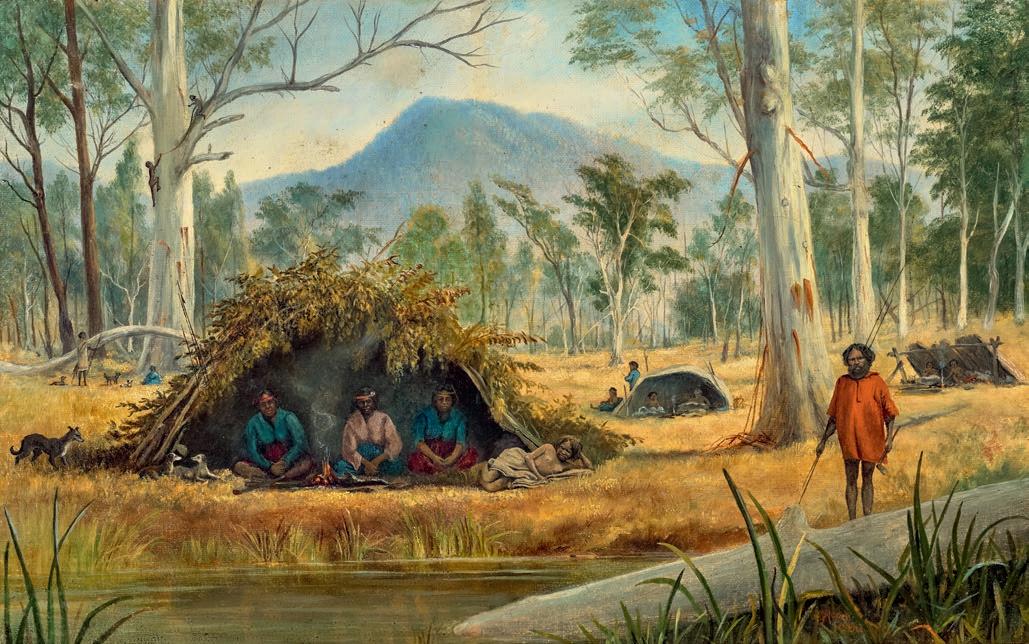
161

Purchased with funds from the Gallery Women's Association, 1984 The
‘…Having resided for many years in various parts of the British Colonies, [Mr Roper] made the different features of those countries the subjects of his brush and pencil, depicting the scenery and animal life which surrounded him, showing the mode of life pursued by the Colonists and the Natives, also introducing various sporting and hunting scenes’.1
In 1870 the painter, illustrator, engraver and lithographer, writer, photographer and prolific traveller Edward Roper presented to the Deptford Emigration Society, stating ‘To my mind Australia is the most wonderful country that ever was and I believe ever can be again: the way it has progressed during the last fifteen years is something tremendous’. 2 English-born Roper had first visited Australia in the 1850s, spending the years 1852–56 on the Victorian goldfields. Although then only in his early twenties, he was already well-travelled, having sailed as a midshipman to the West Indies prior to emigrating with his family to Canada when a teenager: by 1870, Roper said, ‘I have crossed the Atlantic to America and back some ten times, four times in emigrant ships.’3
Roper returned to Australia in 1870, travelling from England to Canada, via train across the United States, then sailing to Hawai’i, New Zealand and New South Wales. In 1871 he established a Melbourne branch of the Graphotype Engraving Company, a form of reproductive printmaking, which he ran until 1873. 4 By this time Roper was an experienced illustrator, producing sketches and watercolours, although he is not known to have exhibited his art while in Australia. He took up oil painting following his return to England where he spent his later years, while travelling frequently to Canada. Family records suggest that he undertook study in Paris; certainly his subsequent painting, drawing upon earlier sketches, was prolific, often repeating his topics. During the 1880s and 1890s, he exhibited extensively in group and solo exhibitions in London, with subjects ranging from Canadian snowscapes to Māori kiwi hunting, goldrush scenes to felling giant eucalypts to, as here, forms of Indigenous architecture. In addition, Roper wrote and spoke widely about his extensive travels and experiences, particularly in North America.
162 IMPORTANT AUSTRALIAN + INTERNATIONAL FINE ART
Edward Roper
Aboriginal encampment by a river, c.1862 oil on board, 31.2 x 52.3 cm
collection of the Art Gallery of Ballarat, Victoria
Painted in 1884, this scene of Indigenous habitation among towering gums might be the work titled “Their only home”, a Black’s mia-mia, Victoria, which was exhibited in 1886. 5 Roper is known to have visited the Wimmera and Grampian regions of western Victoria in 1870–71, which might be depicted here; photographs he took of his party are held in the State Library of New South Wales. This oil painting, and a closely related watercolour in the Ballarat Art Gallery, were probably also the result of photography: the three styles of built structures seen here are highly unlikely to have been used simultaneously but are amalgamated to convey ethnographic information and colonial spectacle, rather than regional accuracy. Photographs of Aboriginal families similarly posed were common and may have been taken by Roper himself or produced commercially. Roper was awarded a gold medal for paintings displayed at the 1905 Colonial and Indian Exhibition in London’s Crystal Palace, the year before that edifice burnt down, and four years before his own death.6
1. Exhibition advertisement, Egyptian Hall, London, 1890s, illustrated at https://samizdatpress. typepad.com/issue_three2_fall_2010/edward-roper-by-jim-burant-10.html
2. Edward Roper, What Emigration really is: By a Resident in Canada and Australia with Illustrations by the Author, paper for the Deptford Emigration Society, London 1870
3. ibid.
4. ‘Graphotype’, The Argus 9 Oct. 1872 , p. 1
5. A painting of this title was also exhibited in London in 1873 (see Exhibition History above).
6. Extensive research on Roper’s life and Canadian art has been undertaken by Jim Burant, Hamilton Arts & Letters, Fall 2010 and following, https://samizdatpress.typepad.com/issue_ three2_fall_2010/edward-roper-by-jim-burant-1.html
ALISA BUNBURY
163
LOUIS BUVELOT (1814
– 1888)
NORTHCOTE BY SIDE OF BRUNSWICK, MELBOURNE, 1871
oil on canvas on panel 25.5 x 36.0 cm
signed and dated lower centre: L Buvelot / 1871
ESTIMATE: $35,000 – 45,000
PROVENANCE
Private collection, Melbourne
Australian Galleries, Melbourne
Private collection, Victoria
Deutscher and Hackett, Melbourne, 16 April 2008, lot 19
Private collection, Adelaide
RELATED WORK
Northcote, Merri Creek, 1866, pencil, 14.0 x 23.0 cm, formerly in the collection of Mde Buvelot, illus. in Gray, J., Louis Buvelot: His Life and Work , MA thesis, University of Melbourne, 1977, vol. 2, cat. 193, p. 124
We are grateful to Brenda Martin Thomas, wife of the late David Thomas AM, for kindly allowing us to reproduce David’s writing in this catalogue entry.
For many colonial artists of the latter half of the nineteenth century, the appeal of the Australian landscape lay in its panoramic splendour and awe-inspiring beauty. Typical of this inclination was Eugene von Guérard who saw the hand of the creator in nature’s grandeur, adopting the theme so popular to Romantics of man’s infinitesimal role in the grand scheme of things. With his French-leaning Swiss background, Louis Buvelot’s approach was entirely different, nurtured by the Barbizon School and its transcripts of nature in which the civilising hand of man is always present. While Von Guerard aesthetic interests were the sublime, Buvelot was a master of the homely scene, those peaceful moments of the day in gentle transition to evening, of ducks by the farmyard pond,
folk wending homeward as friendly smoke rises from the homestead chimney. In his day, Buvelot replaced Von Guerard as Melbourne’s most popular artist. The young Heidelberg painters Tom Roberts, Frederick McCubbin and Arthur Streeton saw him as a father figure in the development of landscape painting. On his death in 1888 an era came to an end, popular sentiment being so great that the National Gallery of Victoria renamed their Grosvenor Gallery the Buvelot Gallery in his honour.
Living in the city of Melbourne during the 1860s, Buvelot made many sketching trips into the Victorian countryside, returning to his studio to paint such large canvases as Summer Afternoon, Templestowe , 1866 one of the first works by Buvelot to be purchased for the National Gallery. By 1869 his reputation as the colony’s leading landscape artist was well established. Waterpool at Coleraine , 1871 was acquired the following year as Buvelot played an active role in the newly established Victorian Academy of Arts. Northcote by Side of Brunswick , Melbourne , 1871 belongs to this highly successful and creatively fruitful time. Although the view shows the beginnings of Northcote in the distance, the open foreground invites the eye to engage in the civilised scene of women beside a pond in the sheltered care of gums as cows graze contently nearby. The buildings speak of settlement in harmony with nature, and the blue silhouette of Mt Macedon affords a pleasing backdrop to a characteristically tranquil Buvelot scene. Two 1866 drawings of Northcote are known. Moreover, one of Buvelot’s earliest patrons, George Knowles Parker once owned a painting of Northcote. Some credit him with having ‘discovered’ the artist. Parker married Margaret Bennett, sister of Buvelot’s friend and pupil, Charles Bennett. Many of Buvelot’s works now in the Bendigo Art Gallery originally belonged to Parker and Bennett.
DAVID THOMAS
164 IMPORTANT AUSTRALIAN + INTERNATIONAL FINE ART
48

165
PROVENANCE
William Little, Ballarat
EMMA SCAMMELL (1856 –
1947)
GOLDEN POINT, BALLARAT 1852, before 1887
oil on canvas
71.0 x 76.0 cm
signed lower right: Emma Scammell inscribed with title lower left: Golden Point / Ballarat / 1852
ESTIMATE: $20,000 – 30,000
Leonard Joel, Melbourne, 1 August 1984, lot 1120 (artist name as ‘Emma Gemmell’)
Private collection, Sydney
Deutscher Fine Art, Melbourne
Private collection, Melbourne
EXHIBITED
Australian Painting: Colonial/Impressionist/Early Modern, Deutscher Fine Art, Melbourne, 30 October – 16 November 1984, cat. 14 (illus. in exhibition catalogue)
A Century of Australian Women Artists, 1840s – 1940s, Deutscher Fine Art, Melbourne, 3 June – 3 July 1993, cat. 20
LITERATURE
Little, W., Ballaarat: A Retrospect by Lambda. Printed for private circulation by William Little, 1907 (illus. frontispiece)
Hammond, V., A Century of Australian Women Artists 1840s – 1940s, Deutscher Fine Art, Melbourne, 1993, cat. 20, p. 50 (illus.)
RELATED WORKS
William Strutt, Golden Point, Ballarat, 1852, pen and ink and watercolour, illus. in Strutt, W., Victoria the Golden: Scenes , Sketches, and Jottings from Nature, 1850–1862, compiled c. 1895, Victorian Parliamentary Library, Melbourne, pl. 90 William Strutt, View of the Golden Point, Ballarat, 1852, lithograph, 40.6 x 50.2 cm, published by Campbell and Macartney, Melbourne, February 1852
Unknown engraver after William Strutt, The Golden Point, Ballarat, wood engraving, illus. in ‘Gold in Australia’, The Illustrated London News , 3 July 1852, vol. 21, issue 567, p. 9
‘The axe of the digger quickly made inroads upon the forest all round; the green banks of the Yarrowee were lined with tubs and cradles, its clear waters were changed to liquid, yellow as the yellowest Tiber flood, and its banks grew to be long shoals of tailings’.1
This scene, looking across ‘Golden Point’, Ballarat, where gold had been discovered in August 1851, originated from the skilful pencil of William
Strutt, the English-born and French-trained artist who travelled to the goldfields only six months later. There he recorded the social turmoil and environmental damage caused by the influx of hordes arriving every day to try their luck. This painting, however, was not created in 1852 – and indeed, the artist, Emma Scammell, was not born until 1856. Instead Scammell based her painting on the lithograph Strutt swiftly produced in Melbourne – decorated with depictions of miners, native police and mining equipment – or a wood-engraved version published shortly afterwards in the Illustrated London News , in July 1852, or a later iteration.. 2
Such historic subject matter was common in the 1870s and 1880s when older artists (including Strutt back in England) returned to earlier sketches, and a younger generation investigated their local history, as the fiftieth anniversary of the colonisation of Victoria approached. Scammell is recorded as having trained at the Ballarat School of Mines and being awarded medals and commendations in Melbourne exhibitions of ‘juvenile’ (student) art in 1879 and 1880. This substantial oil painting was produced prior to her marriage in 1887, the year that she and her husband Edgar Foreman settled in Brisbane. There she became a founding member of the Queensland Royal Society of Art, exhibiting over subsequent decades, and died in 1947, her obituary noting her as ‘well known in art circles in Brisbane’. 3
1. W.B. Withers, History of Ballarat and Some Ballarat Reminiscences, 1870 (facsimile: Ballarat Heritage Services, 1999), p. 23
2. See related works, listed above
3. ‘Death of artist’, The Telegraph, Brisbane, 5 Feb. 1947, p. 5
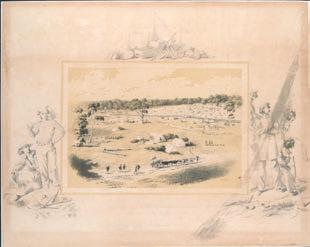
William Strutt
View of the Golden Point, Ballarat , 1852
lithograph on paper 40.6 x 50.2 cm
State Library of Victoria, Melbourne
166 IMPORTANT AUSTRALIAN + INTERNATIONAL FINE ART
49
ALISA BUNBURY

167

(1818 – 1880)
OUTER MANLY BEACH, SYDNEY, c .1856
watercolour on paper
24.5 x 33.5 cm
inscribed with title lower right: Outer Manly Beach – Sydney / From Track to Fairy Bower
ESTIMATE: $15,000 – 20,000
PROVENANCE
Private collection
Sotheby’s, Melbourne, 27 November 1989, lot 253
Private collection, Melbourne
RELATED WORK
Approach to Manly Beach near Sydney, 1856, lithograph, 15.7 x 22.0 cm, , in the collection of the National Library of Australia, Canberra
168 IMPORTANT AUSTRALIAN + INTERNATIONAL FINE ART
S.T. GILL
50
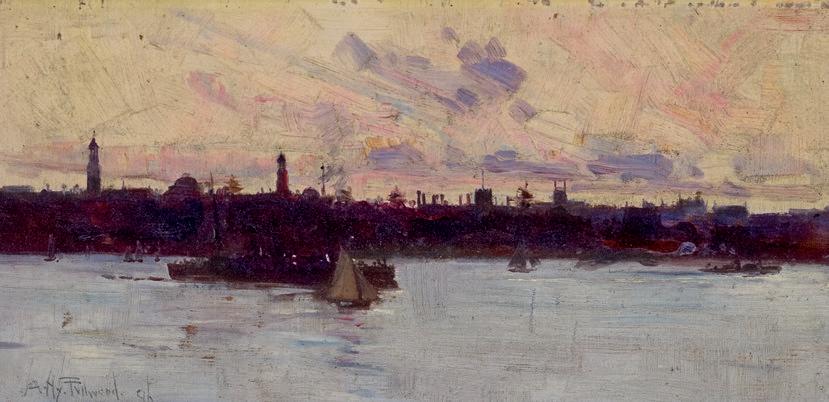
ESTIMATE: $12,000 – 18,000
PROVENANCE
Private collection, New South Wales
Private collection, News South Wales, acquired from the above
169
ALBERT HENRY FULLWOOD (1863 – 1930)
SYDNEY, 1896 oil on panel 13.0 x 26.5 cm signed and dated lower left:
A.HY. FULLWOOD. 96 bears inscription verso: Sydney / To P. ... ... a Henry Fullwood / ... / ... / ... 1896 / ...
51
WILLIAM CHARLES PIGUENIT
(1836 – 1914)
CYNTHIA BAY, LAKE ST. CLAIR WITH MT. IDA IN DISTANCE, TASMANIA, c .1880 s oil on canvas 72.0 x 108.0 cm signed lower left: W C PIGUENIT
ESTIMATE: $25,000 – 35,000
PROVENANCE
Private collection
Deutscher Fine Art, Melbourne
Private collection, Brisbane, acquired from the above in 1984
EXHIBITED
Australian Paintings: Colonial / Impressionist / Early Modern, Deutscher Fine Art, Melbourne, 30 October – 16 November 1984, cat. 35 (illus. in exhibition catalogue)
RELATED WORK
Mt Ida, Lake St Clair, Tasmania, c.1881, pencil, watercolour, scraping out, white gouache highlights on white wove paper, 33.2 x 52.9 cm, in the collection of the Art Gallery of New South Wales, Sydney
and Colonel W.V. Legge who would both leave accounts of the overland trip. It also included Piguenit’s old friend R.M. Johnstone who indeed may have invited Piguenit to come…
…The West Coast Party left Hobart on 17 February and followed much of the same route Piguenit had taken with Scott in 1873 as far as Lake St Clair. But from there the men veered west south-west across the Navarre Plain, past Mt King William and the King William Range, past Mt Arrowsmith, Mt Rufus, Mt Gell, and The Frenchman’s Cap. The track was incredibly rough… On 20 February the party camped on the Cardigan River.4 Next morning, most of the men continued to the King River, but Piguenit and Legge, ‘wishing to see more of the beautiful scenery in the vicinity pf Lake St Clair, and taking no interest in the King River mines, returned to King William…’5
The following excerpts are from Johannes, C.E. and Brown, A.V., W.C. Piguenit 1836 – 1914: Retrospective , Tasmanian Museum and Art Gallery, Hobart, 1992, p. 25pp. 25 – 26:
Born in Hobart in 1836, during the early 1880s W.C. Piguenit and his family moved permanently to Sydney. However, he never forgot ‘the tight little island that I am proud to call my native land’1, and spent time in Tasmania in 1884 2, returning in 1887 for one last trip into the Western Highlands. He was now fifty-one and would soon no longer have the physical stamina required for the rigours of such explorations. He joined Charles Sprent’s planned ‘West Coast Party’ 3 which consisted of many eminent Tasmanians, amongst them James Backhouse Walker
…On the way out, the West Coast Party had spent a couple of afternoon hours wandering over Lake St Clair’s sandy beach in damp and chilly weather when the lake or rather, the mountains round it were covered with flying clouds and mist… as snow showers passed over and great peak after peak loomed through the gloom, forming a splendid vista of mountains… Everyone had been impressed by the grandeur of the scene…’6
1. Letter from W.C. Piguenit to Andrew Inglis, 12 April 1888 in A.J. Clark Papers, University of Tasmania Archives, Hobart
2. This evidence is provided by a pencil sketch, Mount Wellington from Old Beach, 1884, now in the collection of the Queen Victoria Museum and Art Gallery, Launceston.
3. Charles P. Sprent was Deputy Surveyor General of Tasmania.
4. The Cadigan is a river halfway between Lake St Clair and modern-day Queenstown.
5. W.V. Legge, ‘The Highlands of St Clair’, Papers and Proceedings of the Royal Society of Tasmania for 1887, The Mercury, Hobart, 1888, p. 117
6. Backhouse Walker, J., Walk to the West, 1887, p. 7
170 IMPORTANT AUSTRALIAN + INTERNATIONAL FINE ART
52

171
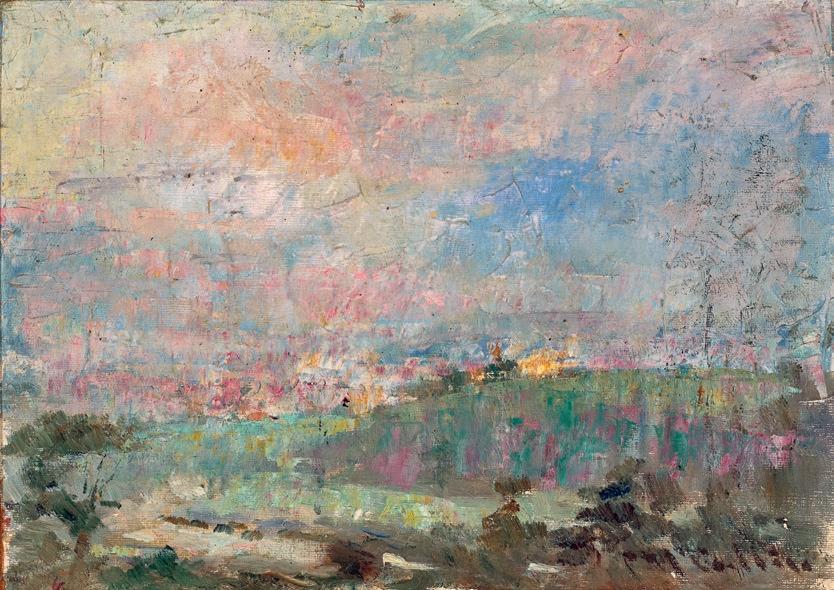
FREDERICK M c CUBBIN (1855 – 1917)
TOWARDS RICHMOND FROM
KENSINGTON ROAD, SOUTH YARRA, c .1910
oil on canvas board
25.0 x 35.5 cm
signed lower right: F McCubbin
bears inscription verso: no. 7 J. Q. McCUBBIN
ESTIMATE: $30,000 – 40,000
53
PROVENANCE
The artist, Melbourne
Thence by descent
John McCubbin, Melbourne, the artist’s grandson
Thence by descent
Mrs Nanette McCubbin, Melbourne
Deutscher and Hackett, Melbourne,
27 – 28 August 2008, lot 25A
Private collection, Melbourne
172 IMPORTANT AUSTRALIAN + INTERNATIONAL FINE ART

JANE SUTHERLAND (1853
PROVENANCE
– 1928)
THE PEACH ORCHARD, c .1910 pastel on paper
27.0 x 38.0 cm (sight)
signed lower left: J. Sutherland
ESTIMATE: $10,000 – 15,000
Private collection, Melbourne
Deutscher Fine Art, Melbourne
Private collection, Melbourne
EXHIBITED
Victorian Artists’ Society’s Exhibition, Athenaeum Gallery, Melbourne, October 1910, cat. 5
A Century of Australian Women Artists , 1840s – 1940s, Deutscher Fine Art, Melbourne, 3 June – 3 July 1993, cat. 31
LITERATURE
Hammond, V., A Century of Australian Women Artists 1840s – 1940s, Deutscher Fine Art, Melbourne, 1993, cat. 31, p. 53 (illus.)
173
54
HANS HEYSEN
(1877 – 1968)
SUNLIT GUMS, HAHNDORF, 1951 watercolour on paper on card 33.0 x 42.0 cm
signed and dated lower left: HANS HEYSEN / 1951 signed verso: Hans Heysen
ESTIMATE: $20,000 – 30,000
PROVENANCE
Private collection
Elder Fine Art, Adelaide, 7 August 2005, lot 62
Private collection, Adelaide
We are grateful to Brenda Martin Thomas, wife of the late David Thomas AM, for kindly allowing us to reproduce David’s writing in this catalogue entry
Hans Heysen and the village of Hahndorf in the Adelaide Hills are almost synonymous. The picturesque Hahndorf near Mt Barker in the Adelaide Hills was named after Captain Dirk Hahn of the ship Zebra , which brought out the Prussian Lutheran families who settled there in 1839. During the First World War the South Australian Government changed many of the German place names, Hahndorf becoming Ambleside, after a town in northwest England. It remained so until 1930. Heysen used both names in his numerous watercolours and oil paintings of the area. Heysen and his wife Sallie moved to Hahndorf in 1908. They lived in rented accommodation before buying the nearby property ‘The Cedars’ in 1912. It was to be his home for over fifty years.
Heysen rejoiced in the beauty of the area, painting it throughout the changing seasons and times of day – of mists or the brightness of spring, early morning light and the hazy heat of midday, to the gentle light of day’s end. The constant throughout his art was the noble gum. As the artist wrote:
‘The subtlety of the tree combined with the beauty; the bulk, the solidity of the tree, and the character of its growth... It’s wonderful just to watch the combination of characters; sometimes you get a group of gums and you see how they combine, grow into interesting shapes, and suggest various things, ...I had my special trees, and they altered their appearance - the time of the year and the angle of the sun made all the difference. You could paint a tree one day and get all its various facets. And the next day it would be a different tree...’1
Painted in the Hahndorf landscape surrounding ‘The Cedars’, Sunlit Gums , 1951 captures this iconic motif of the gums, bathed in the bright light of the midday sun. Redolent with the serenity Heysen found here, and gently reigned over by the grandeur of the ancient trees, it is a lyrical vision of nature in all her plenitude, painted in a golden period in Heysen’s art.
1. Thiele, C., Heysen of Hahndorf , David Heysen productions, Adelaide, 2001, p. 147
DAVID THOMAS
174 IMPORTANT AUSTRALIAN + INTERNATIONAL FINE ART
55
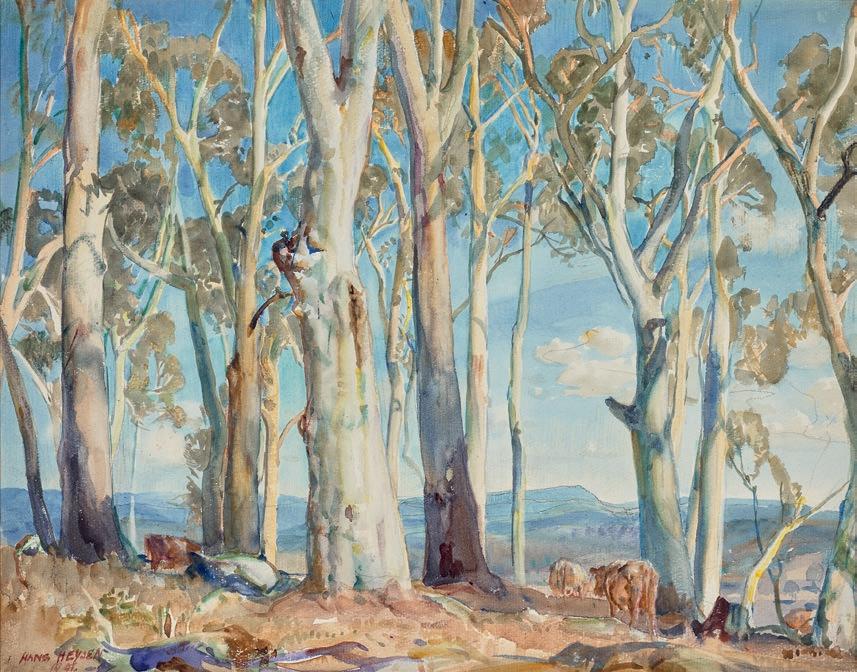
175
99 points
“Good depth and hue of colour it’s still purpletinted at this age. The bouquet is fresh and bold, replete with forest-floor/mint and driedherb nuances, while the palate is very powerful, concentrated, full-bodied and firmly constructed. Deep-set cassis fruit as well, still partially in hiding. This is a dense, power-packed cabernet-driven red with abundant tannins. Tremendously long finish. A magnificent wine, which has what it takes to age and reward cellaring for the long term.”
Huon Hooke, The Real Review, 21 March 2023
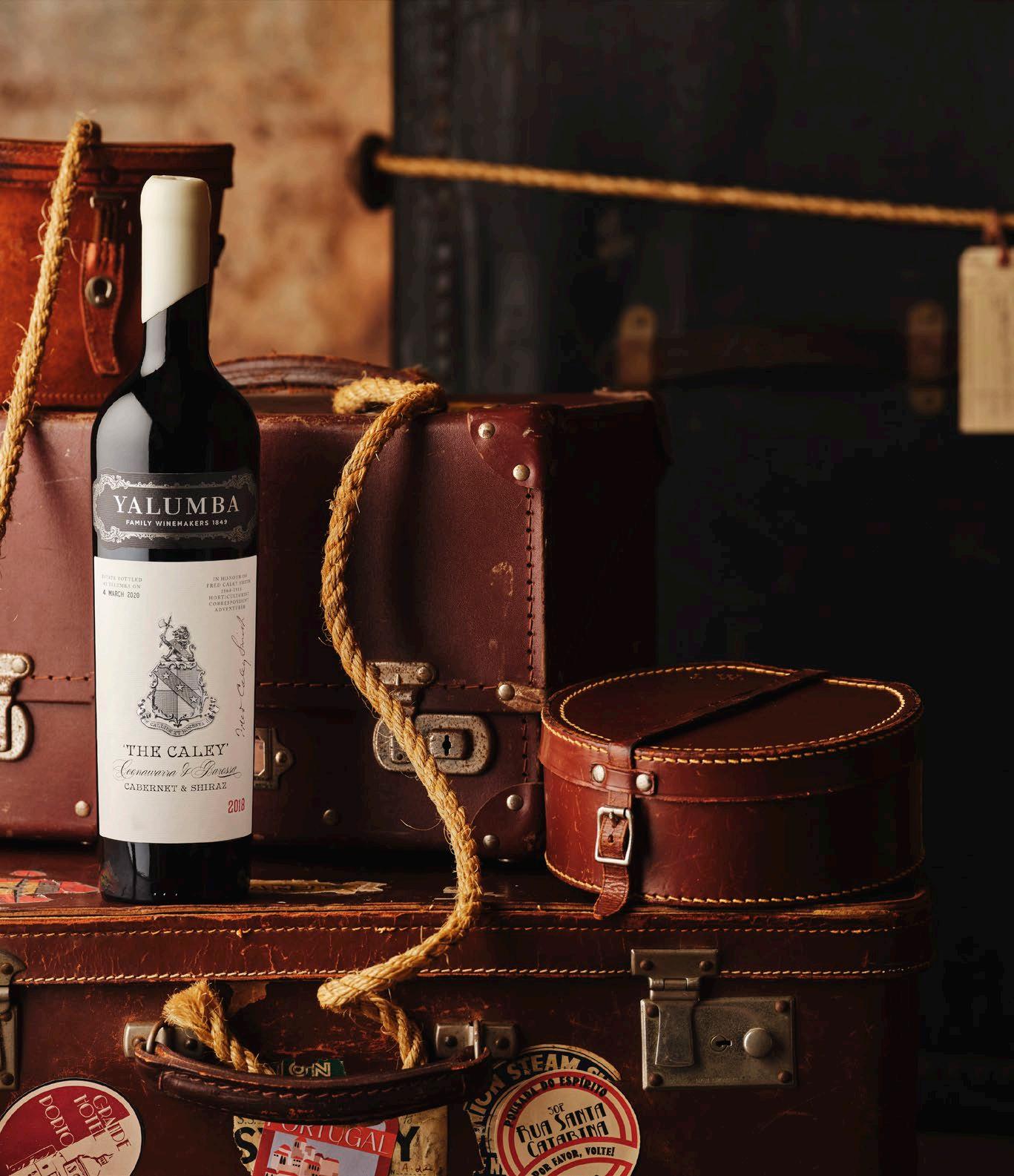
yalumba.com
Yalumba The Caley Cabernet & Shiraz 2018 available now.

177 for appraisals please contact MELBOURNE • 03 9865 6333 SYDNEY • 02 9287 0600 info@deutscherandhackett.com www.deutscherandhackett.com consigning now Important Australian + International Fine Art


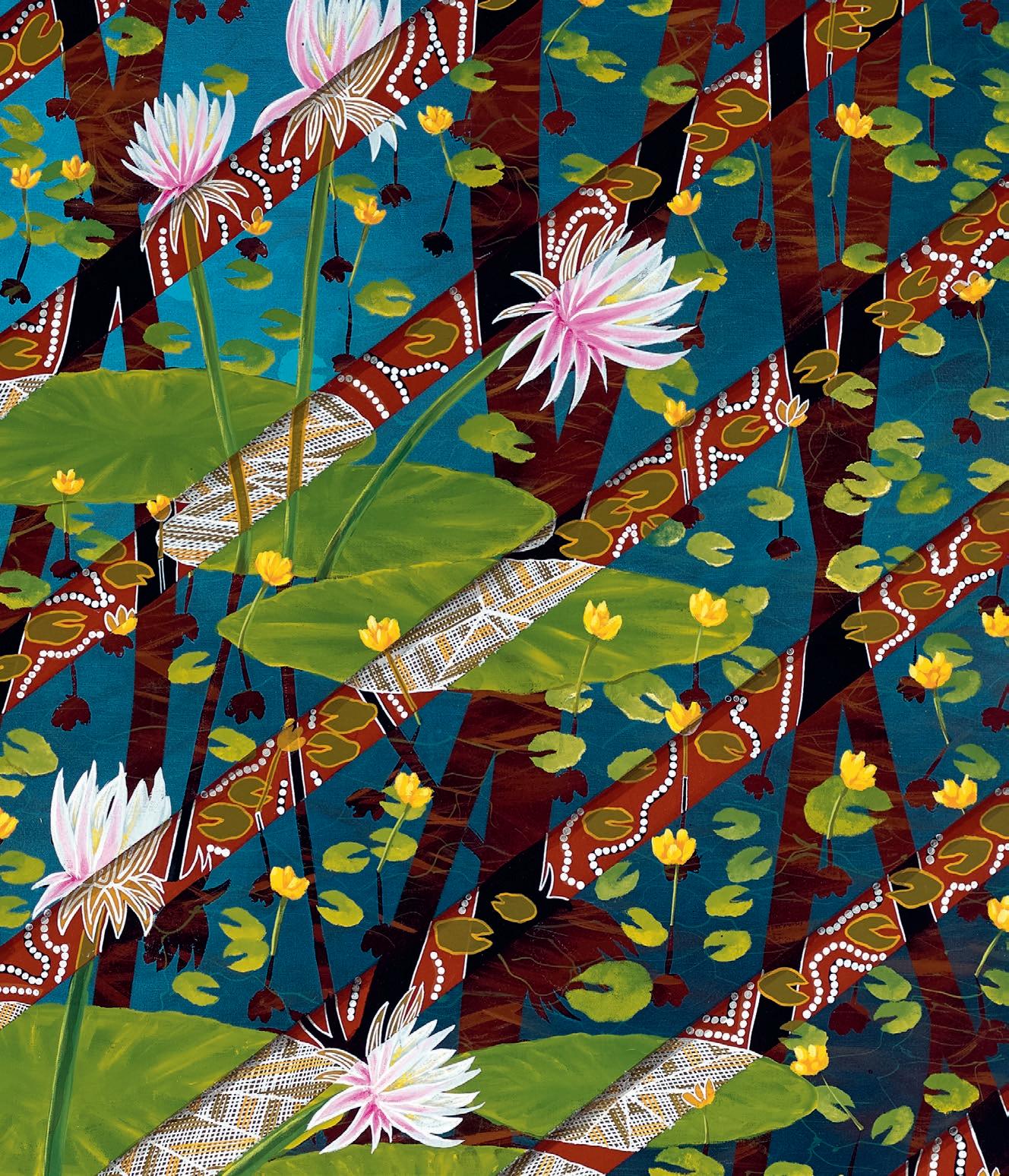

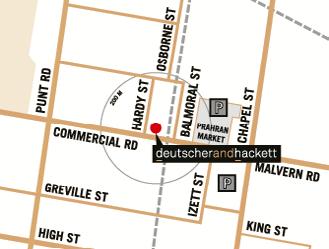










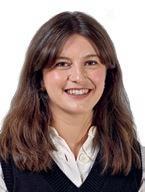









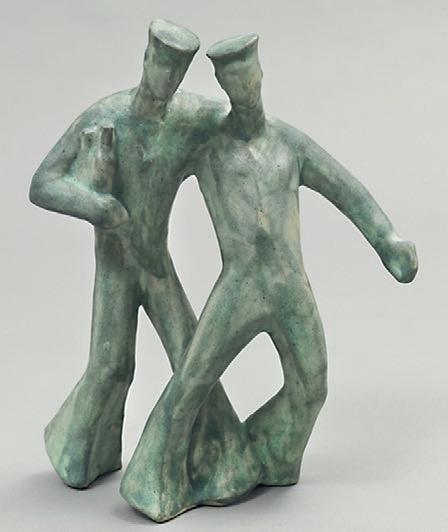
 Daphne Mayo working on the Brisbane City Hall tympanum, c.1930 University of Queensland Fryer Library, Brisbane
Daphne Mayo working on the Brisbane City Hall tympanum, c.1930 University of Queensland Fryer Library, Brisbane



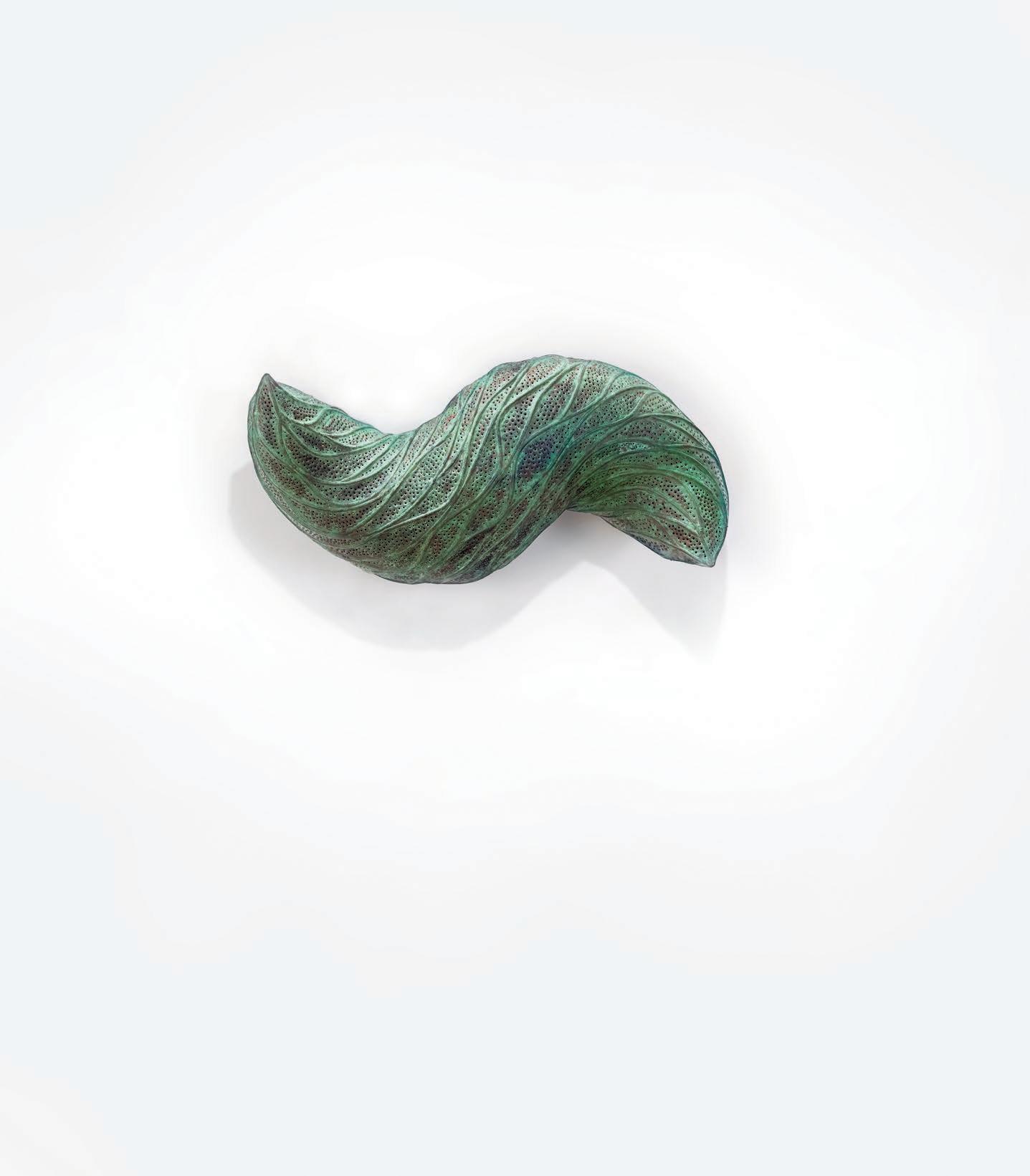

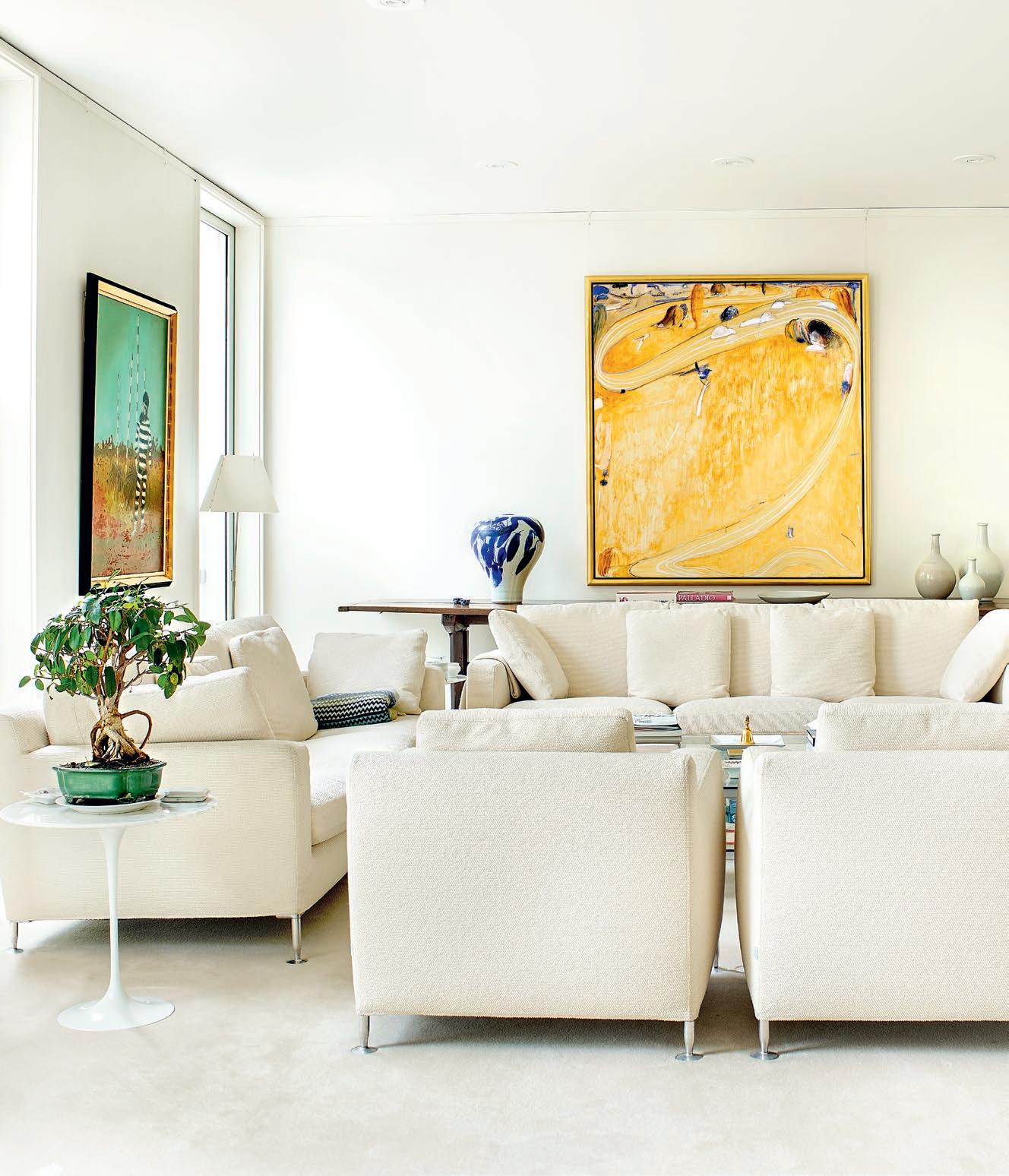

















 John Perceval in his studio at the Australian National University
John Perceval in his studio at the Australian National University








 Brett
Brett


























 Four young women relaxing at the Reynell family home, featuring Gladys (seated on the floor) and Emily (with the dog on her lap), c.1905
Four young women relaxing at the Reynell family home, featuring Gladys (seated on the floor) and Emily (with the dog on her lap), c.1905































































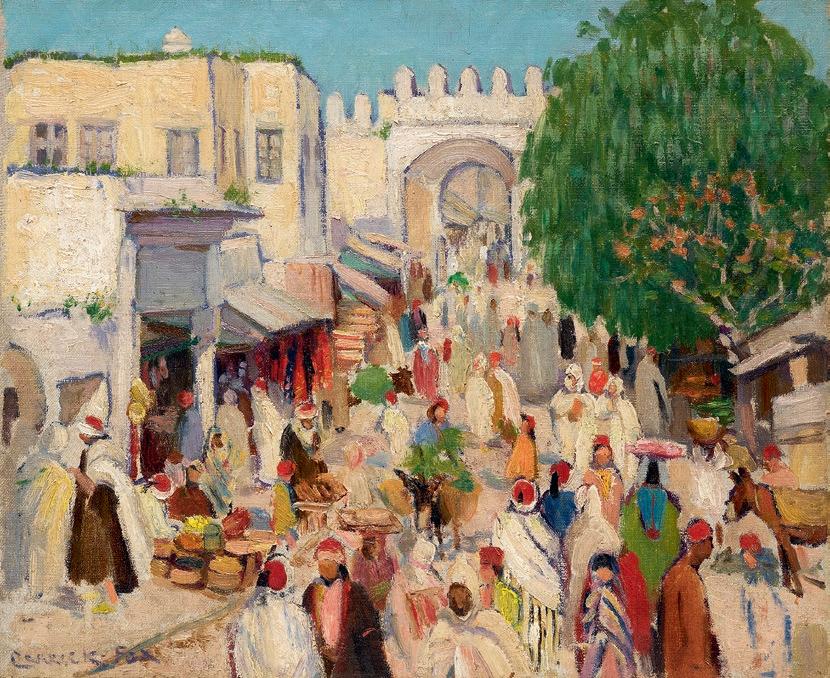

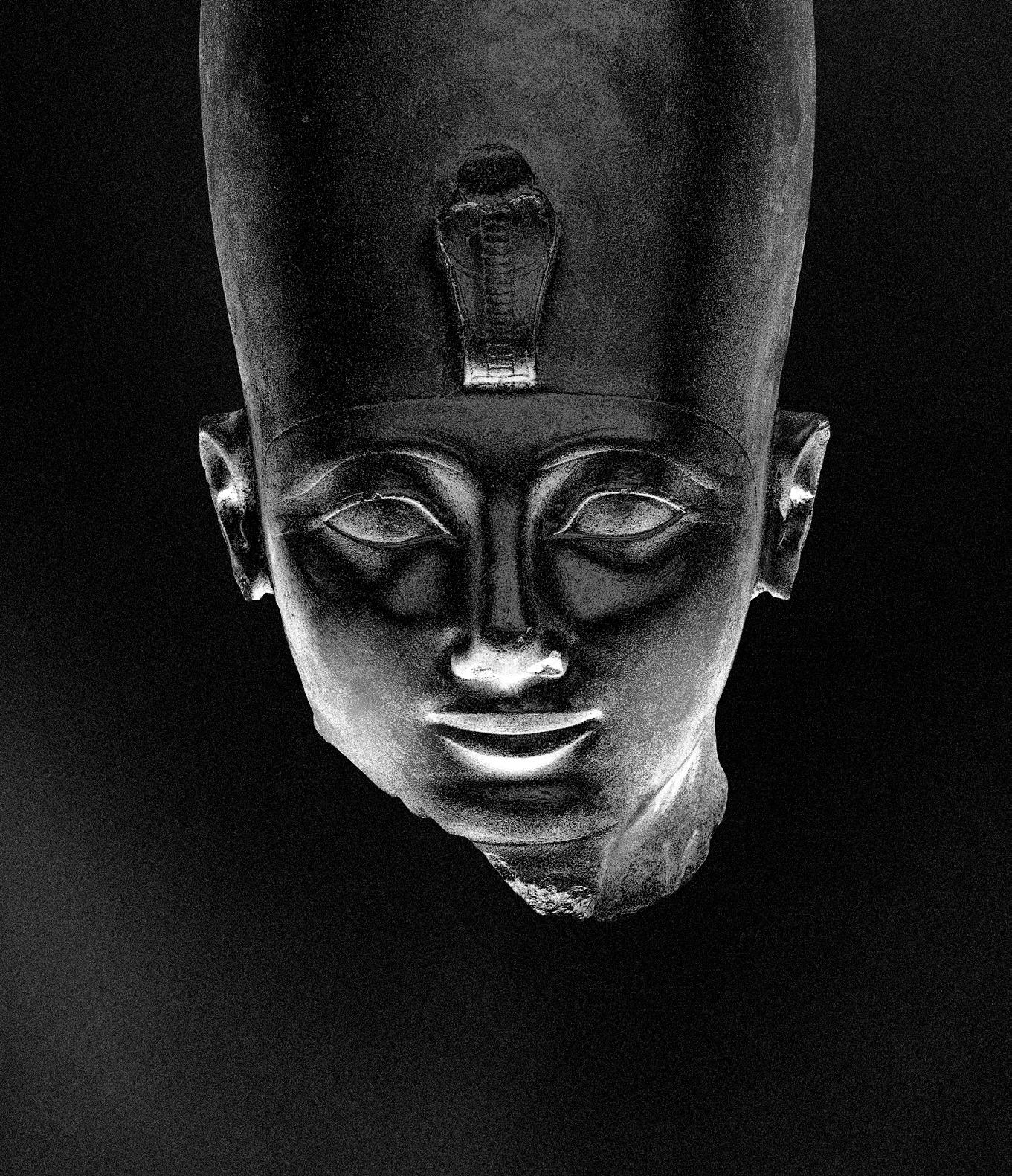
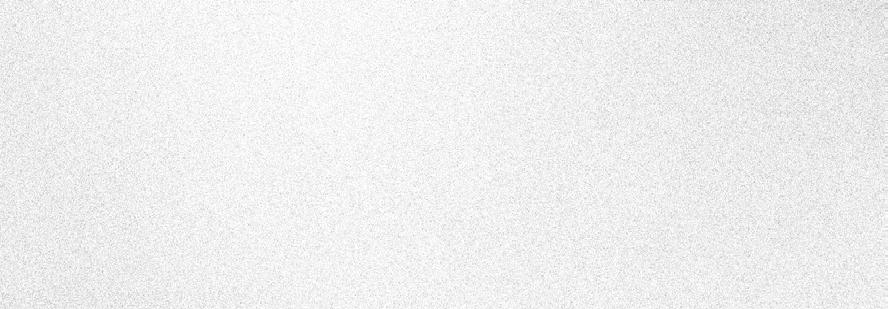


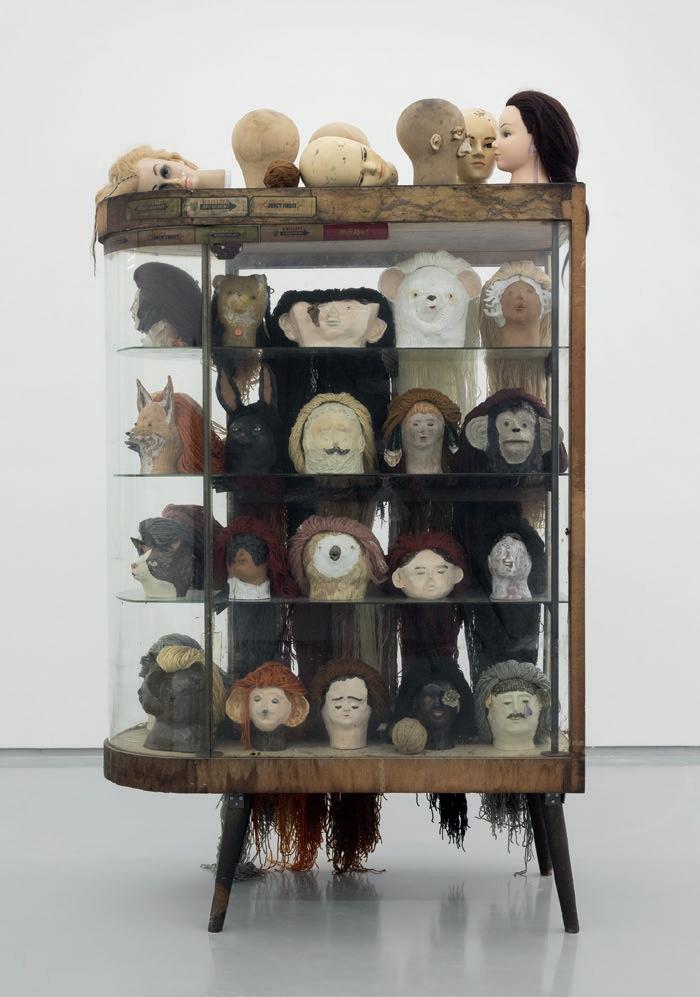
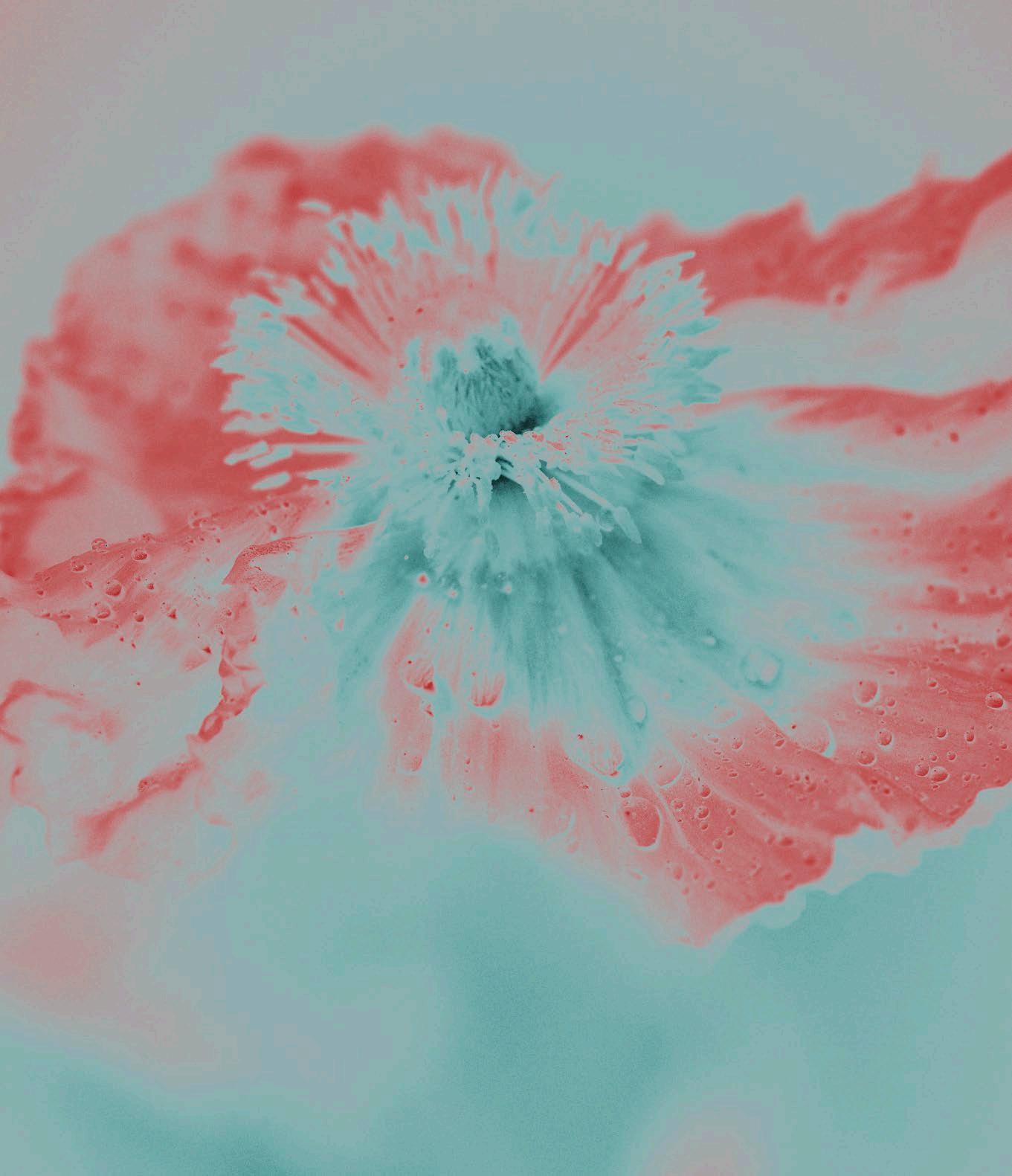









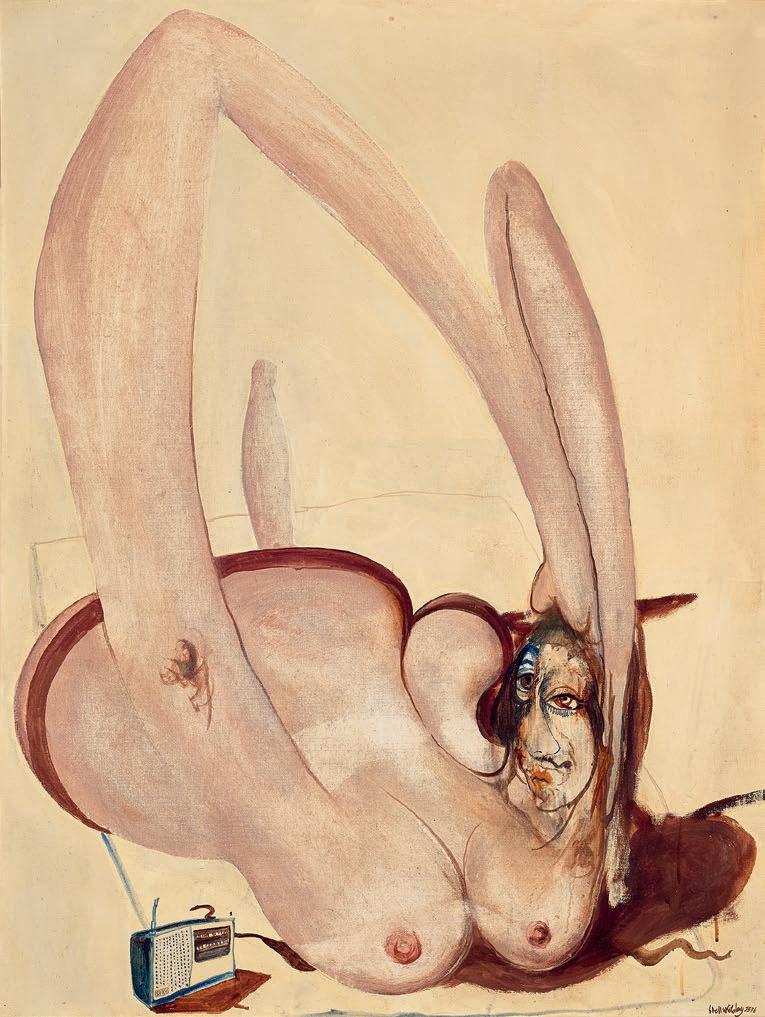 specialist fine art auction house and private gallery
specialist fine art auction house and private gallery